|
Otto Zachow and William Besserdich
Patents
Four Wheel Drive
Auto Company (FWD) During World War Two
Clintonville, WI
1909 - 1910 as the Badger Four Wheel Drive Auto
Company
1910-1958 as the Four Wheel Drive Auto Company (FWD)
1958 - ? as FWD
?- Current as Seagrave
1941-? Eagle Division -
Appleton, WI
May 1943 - August 1945 Stevens Point, WI
This page updated
1-13-2024.
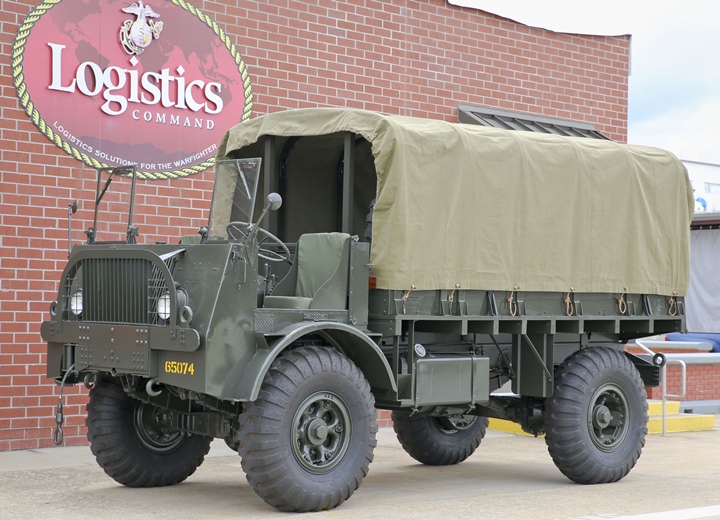
This Four Wheel Drive Auto Company (FWD)-built
USMC Model SU-COE is probably the only one of its type still in existence.
There were only 250 of this type of SU-COE built during World War Two.
This excellent restoration was done by the Marine Depot Maintenance
Command at Albany, GA after being found in a scrap yard in San Diego,
CA. Photo courtesy of the Marine Depot Maintenance Command at
Albany, GA.
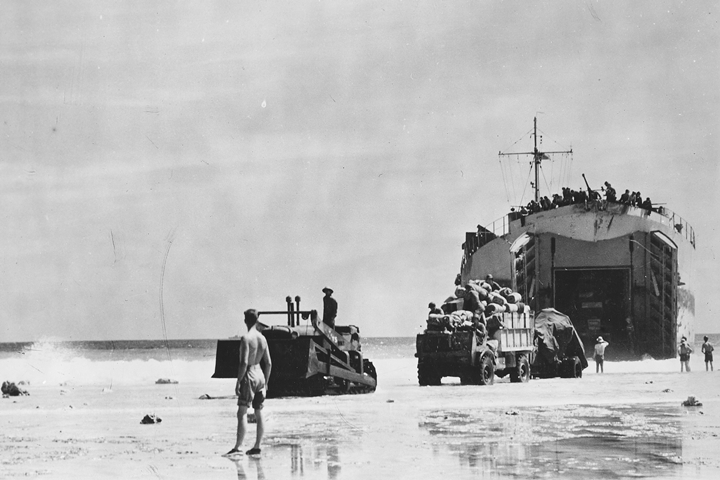
Somewhere in the Central or South Pacific a
USMC SU-COE 5-6-ton 4x4 truck follows a Caterpillar D-7 tractor onto the
beach. It was common practice during landings in the Pacific for a
tractor with a bulldozer blade to be the first vehicle out of the LSTs.
If needed, the tractor could build a sand road for the wheeled vehicles
if the water was too deep. Or, if there were obstructions
on the beach, it could clear them out so trucks like the FWD SU-COE
could proceed inland. In this case, it appears the beach was just
fine for the SU-COE to traverse across the beach. Photo courtesy
of the Tim Wright Collection.
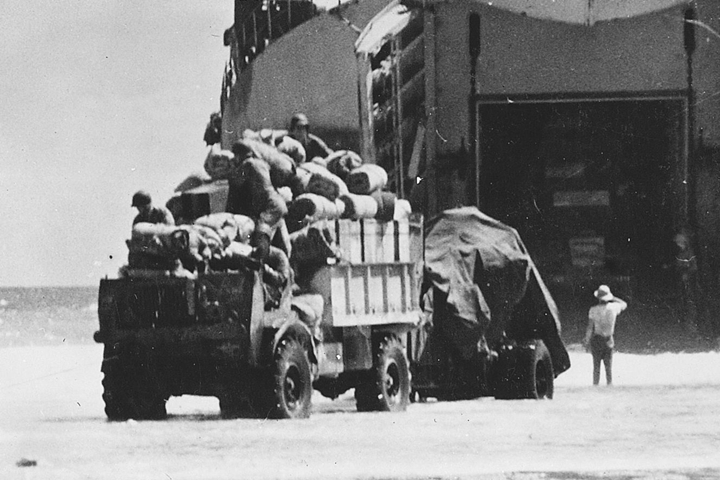
The SU-COE is piled high with sleeping bags.
The body had a second set of side rails installed so the truck could
carry an extra-large load of personal belongings ashore. It
appears the SU-COE is pulling a 90mm anti-aircraft gun. Experience
had taught American invading forces in the Pacific that Japanese
aircraft would contest island landings the same day or evening of the
invasion. Setting up anti-aircraft guns was one of the first
objectives after securing the beachhead. Photo courtesy of
the Tim Wright Collection.
The Four Wheel Drive Auto Company of
Clintonville is a company whose World War Two contributions have been
overlooked and forgotten in the United States. There are several
reasons for this. Firstly, 93% of the 15,724 vehicles that FWD built during World War Two were for foreign use. This
was either through direct purchases by foreign countries or by
Lend-Lease. These vehicles
were primarily used by Canada and Great Britain, with a small percentage
going to the Soviet Union. Secondly, and a result of the previous
reason, there are no vehicles in the United States for collectors to
obtain. Thirdly, because the FWD vehicles were primarily not used
by American forces, American military vehicle enthusiasts do not have an
interest in obtaining such vehicles.
That being said, the Four Wheel Drive Auto
Company made many vehicles that were welcomed by Canada, Great Britain,
and Russia to provide needed transportation of supplies for their
fighting forces. The company was recognized by several
organizations for its contribution to help win World War Two.
In the end, FWD had the last laugh as it still
exists as Seagrave at the original factory location in Clintonville, WI.
Many of the original buildings are still used to make parts and the
original office building is still in use. That cannot be said for
Diamond T or the White Motor Company that took business away from FWD
during World War Two. They are long gone while Clintonville, WI
area residents still go to work at the original FWD factory site making
fire trucks.
Firstly, we need to find out why the Four
Wheel Drive Auto Company chose to build four wheel drive vehicles in
Clintonville, WI. Actually, it was an invention in the town that
resulted in the formation of the company to produce four-wheel drive
vehicles at this location.
One thing that is certain is where and how the
initial idea that eventually developed into the Four Wheel Drive Auto
Company got its start. This is where the
story begins.
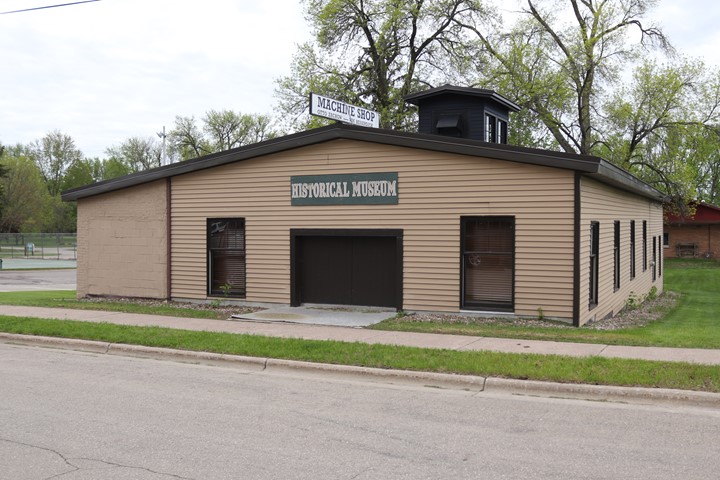
This former machine shop in Clintonville, WI
is where the concept of power to all four wheels, or four-wheel drive,
was conceived in 1908. This is also
where the Four Wheel Drive Auto Company began, which was the first manufacturer of
four-wheel drive vehicles. Author's photo.
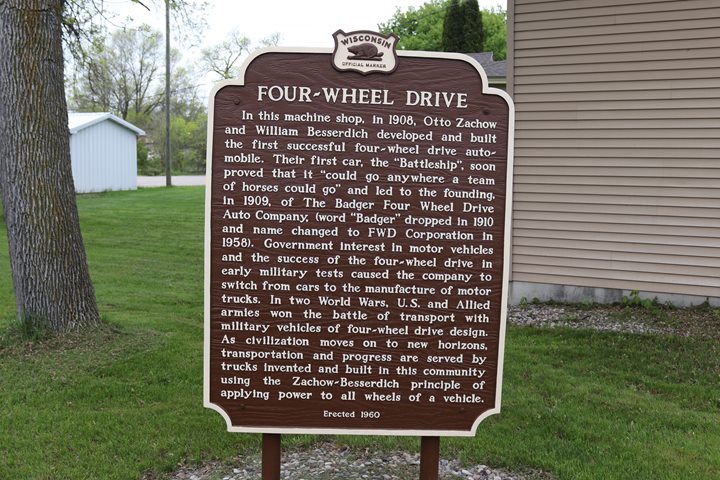
The information on the historical marker is
accurate as far as it goes. However, it does not mention that by
1912 Otto Zachow had cashed in his 350 shares for $9,000 and went back
to his machine shop. Then, in
1914, William Besserdich left the Four Wheel Drive Auto Company and then
formed what became today's Oshkosh Corporation. Previously,
The sign is in Clintonville, WI,
home of FWD and the FWD Museum. When this historical marker was
erected in 1960, the two companies were competitors in a limited market.
FWD lost market share, eventfully purchased Seagrave and began making
fire apparatus in Clintonville. Oshkosh obtained several key military contracts
and became a dominant manufacturer of all-wheel drive military vehicles. Author's
photo.
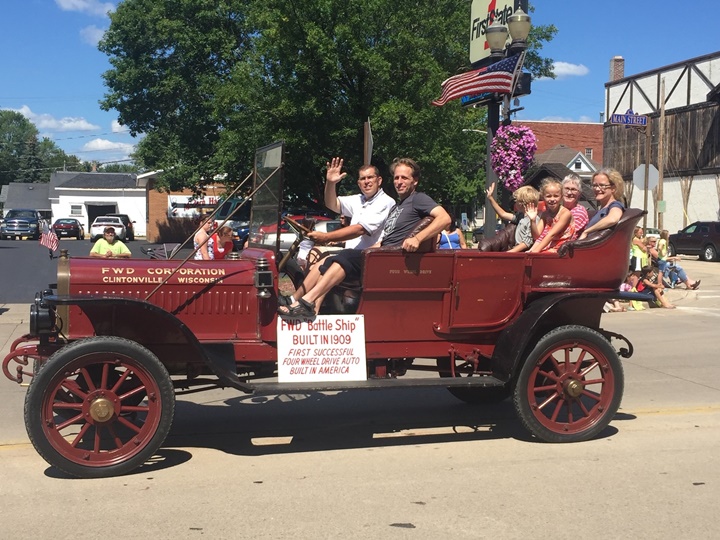
In 1908, the Badger Four Wheel Drive Auto
Company, under the direction of Mr. Zachow and Mr. Besserdich, built its
first ever four-wheel drive vehicle named the "Battleship" as stated on
the historical marker. Another ten cars were built but the market
was not receptive to a four-wheel car at the time. Therefore, the
company moved into producing trucks, which was a path taken by several
other car companies early in the history of the automobile. The
passengers in the "Battleship" include William Besserdich's
granddaughter, great grandson, and great, great grandson. Tom
Cihowiak photo via Tim Wright.
Author's Note: Many of the photos
included in this webpage are from the Tim Wright Collection. Mr.
Wright has been collecting FWD memorabilia and photos for many years and
is a well-known Four Wheel Drive Auto Company historian. Mr.
Wright has been gracious enough to allow me to use many of his photos in
order for me to tell the full story of how the FWD Company helped win
World War Two. I want to thank Mr. Wright for allowing me to use
his photographs in this website. Mr. Wright is the person driving
the FWD Battleship in the above photo.
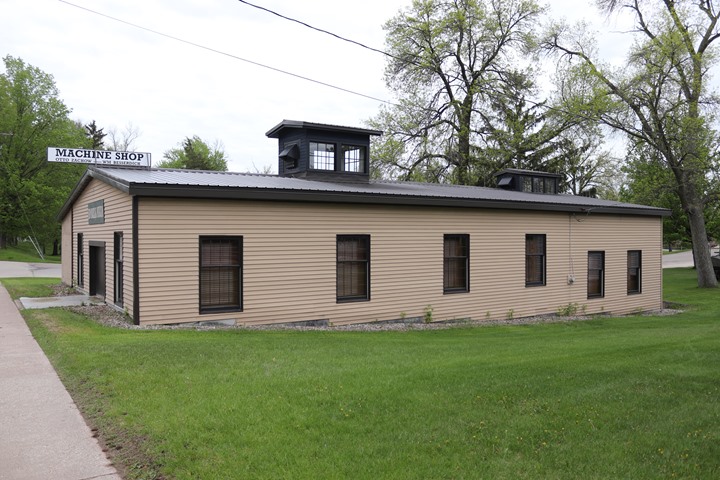
Today, the machine shop where four-wheel and
all-wheel drive was invented is part of the FWD Seagrave Museum located
in Clintonville. Author's photo.
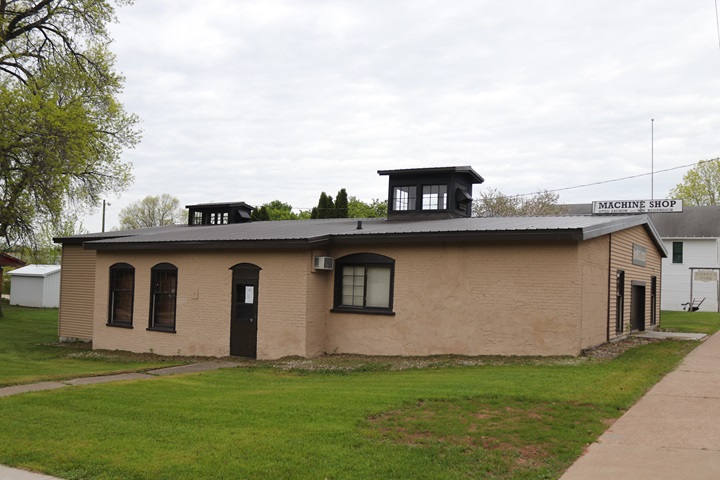
Today, four-wheel and all-wheel drive
vehicles are
commonplace. Now four-wheel drive is pretty much standard equipment
on pickup trucks, and many SUVs are equipped with all-wheel drive.
For this to have happened, Otto Zachow and William Besserdich designed
the first really workable method of applying power to the front wheels
needed to steer the vehicle. That was done in this building. For those
of us who
drive trucks with four-wheel drive and SUVs with all-wheel drive, we are indebted to Mr. Zachow and
Mr. Besserdich. Author's photo.
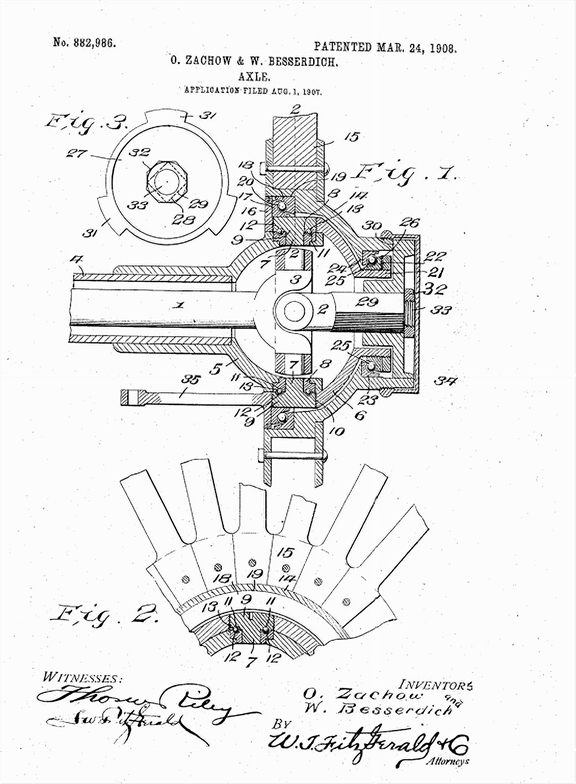
This is the first of two patents that Otto
Zachow and William Besserdich were awarded. Unlike previous attempts and patents relating to four-wheel drive vehicles,
their patents evenly divided the power to front and rear wheels.
The U.S. Army was so impressed by this particular design that was used
on the FWD Model B in World War One, that it purchased both patents from
the company and gave the technology to other truck companies.
Both patents can be viewed in their entirety
at the link at the top of this page.
In 1908, Otto Zachow and William Besserdich had two patents but were short on
cash to move forward. Dr. W.H. Finney of Clintonville provided
$1,800 in financing to assist the two men. However, in 1910 Dr.
Finney reversed his position and withdrew his support and money from the
fledging enterprise. At this point, a lawyer, Walter A. Olen, gave
up his law practice to become the company's person in charge of sales
and marketing. Staging a large public competition among many auto
makers in a Clintonville FWD company's sand pit, all of the other contestants had
to be pulled out by the FWD competitor. Mr. Olen used the
enthusiasm generated at the event to persuade local residents to invest
in their local vehicle manufacturer. With this initial funding,
the company built a small factory in Clintonville.
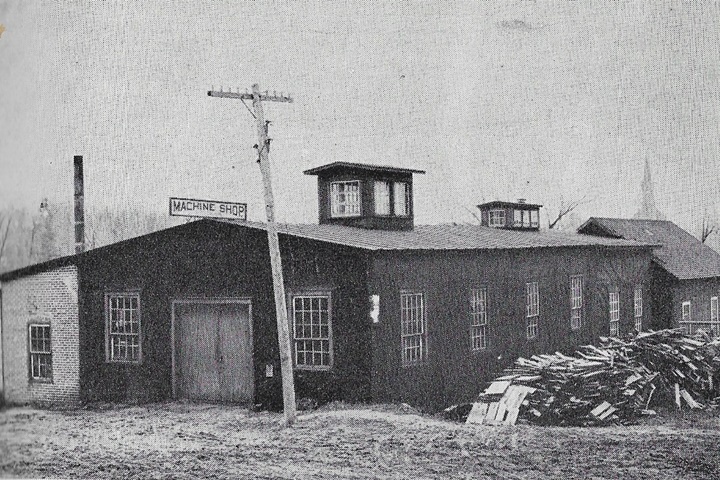
As noted above, both Mr. Zachow and Mr. Besserdich left the
company they created. Otto Zachow left in 1912 and returned to his
machine shop.
William Besserdich stayed another two years. Differences of opinion with the
company's president, Walter Owen, and an engineer, Mr. Battenberg,
caused his departure. In 1914 he sold his shares in the Four Wheel
Drive Auto Company and moved on. William Besserdich then teamed up with
Bernhard Mosling, an established businessman in Clintonville. The
two formed the Wisconsin Duplex Auto Company in Clintonville and set up
shop in Mr. Mosling's mercantile store. However, the Four Wheel
Drive Auto Company dominated the business atmosphere in Clintonville.
Therefore, the first vehicle built by the fledgling company in 1917 was
a one-ton 4x4 built at Andrews Motor Manufacturing under the
guidance of William Besserdich. This four-wheel drive truck was
named "Old Betsy." The same year the operation moved to
Oshkosh, WI and became the Oshkosh Motor Truck Company.
Early Military Vehicles: In 1910,
the one year old company sold its first military vehicle after U.S. Army
Quartermaster officer Captain Alexander E. Williams noticed a newspaper
ad for the new company's product. In his current assignment he was investigating several vehicle companies and had purchased
several trucks for testing. Once Captain Williams read the ad on
the new four-wheel drive truck, he took the train to Clintonville, WI to
see the new vehicle for himself. While at Clintonville, Mr. Zachow
and Besserdich drove him all over the country side in the second
automobile the company had made. Impressed by what he saw during
the test drive, Captain Williams purchased one of the original ten
automobiles for $1,900. The vehicle was modified with an army
escort wagon box which turned it into a truck. Besides being the
first military sale for the fledging company, it may well have been the first sale of any type of four-wheel drive truck for the U.S. Army. This was the first of many military truck
sales for the small company.
In 1912, Captain Williams organized a
1,509 mile endurance test for the trucks he had purchased.
On February 28, 1912, the test began at Washington, D.C. Besides the FWD
vehicle Captain Williams had purchased, trucks from Autocar, Sampson,
and White were also in the test. Each vehicle was loaded with one and a
half tons of supplies plus another half ton of sand. Captain
Williams wanted to prove that motorized vehicles could perform the same
function as the horse drawn supply wagon. The course went south to
Atlanta, GA over muddy roads and open fields. Once in Atlanta, the
vehicles turned north and proceeded to Fort Benjamin Harrison on the east
side of
Indianapolis, IN. The Sampson had to drop out due to failure of
the connecting rod bearings, but the other three trucks arrived at Fort
Harrison on March 28, 1912. After a second endurance run in Iowa
and Wisconsin, Captain Williams chose FWD, Mack, and White for further
use and testing.
After World War One started in 1914, FWD
received an order for two trucks from the British firm of Gaston,
Williams, and Wigmore. After evaluating the two vehicles, the
British company ordered another 50 trucks, which were more vehicles than
what FWD had previously built in its limited existence. In 1915, the
company shipped 400 trucks to Great Britain and expanded the size of its factory in
Clintonville several times. It became an international company
with sales not only to Britain, but Argentina, Brazil, France, Portugal,
Russia, and Spain.
On March 9, 1916, Pancho Villa crossed the
U.S.-Mexican border and attacked Columbus, NM. This resulted in an
order of 147 FWD 3-ton 4x4 trucks for General John Pershing's
Mexican Expedition. This was FWD's largest order to date for
the U.S. Army.
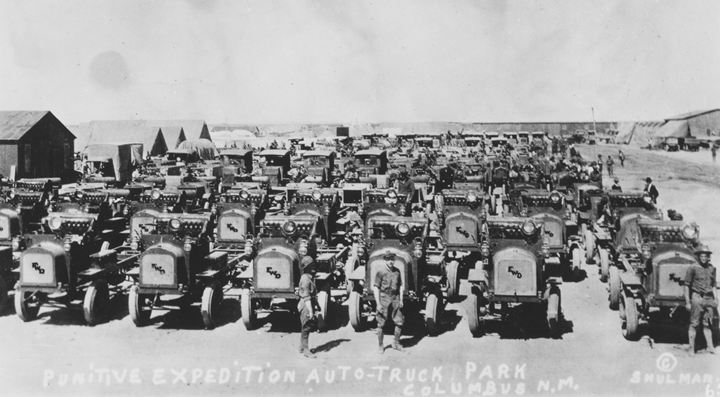
There are at least sixteen Model Bs ready to
move into Mexico in search of Pancho Villa. Photo courtesy of the
Tim Wright Collection.
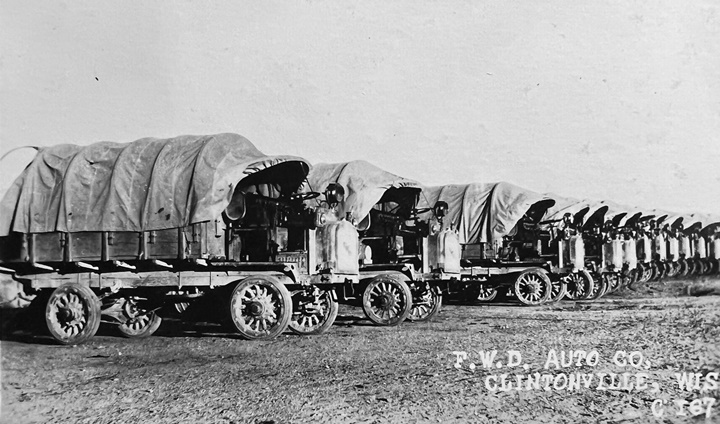
This is another line of FWD Model B's in New
Mexico. Photo courtesy of the Tim Wright Collection.
World War One: The Four Wheel Drive Company-designed Model B
was one of several types of 4x4 trucks supplied to the U.S. Army during
World War One. There was a total of 16,000 built. It should
be noted that FWD did not have the production capacity to build the
16,000 in the time required by the U.S. Army. Therefore, four other
companies, Kissel, Mitchell, Peerless, and Premier, were licensed to build the Model B during World War One. FWD built
approximately half of the Model Bs while the other companies built the
rest. FWD's first World War One Army contract was awarded in 1917 when the
company received a $12,000,000 contract for 3,750 Model B 3-ton 4x4
trucks. This was a unit price of $3,200. The Model B was powered by a 56 hp engine and a
three-speed transmission. The transfer shaft was driven by a Morse
five-inch silent chain to provide power to both the front and rear drive
shafts. Of special interest is the fact that the company used a
vanadium steel in its ladder type chassis. The Model B could carry
its own weight in freight and had multiple uses in World War One.
Besides being used to move cargo and supplies, the Model B was also used
to carry ammunition and had a special steel body mounted to the chassis
for this function.
FWD Model Bs were the largest group of
American trucks to serve on the Western Front during World War One.
The large variety of trucks and the large number of various required
spare parts was the reason for the creation of the Standard B truck with
standardized parts. But it was too little too late, and
only a few were shipped to Europe. However, the FWD Model Bs were
there in quantity and helped win World War One.
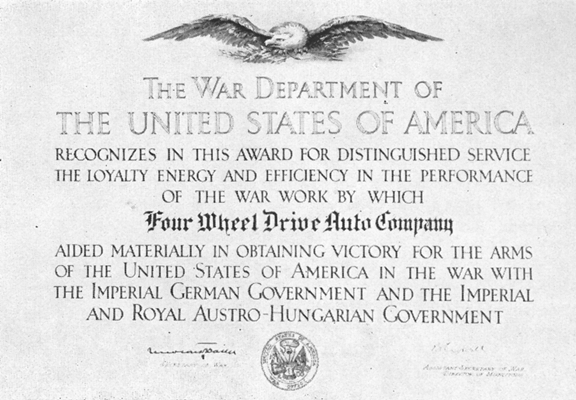
The Four Wheel Drive Auto Company was
recognized for its contribution to the winning of World War One by the
War Department. Photo from FWD World War Two newsletter in the Tim
Wright Collection.
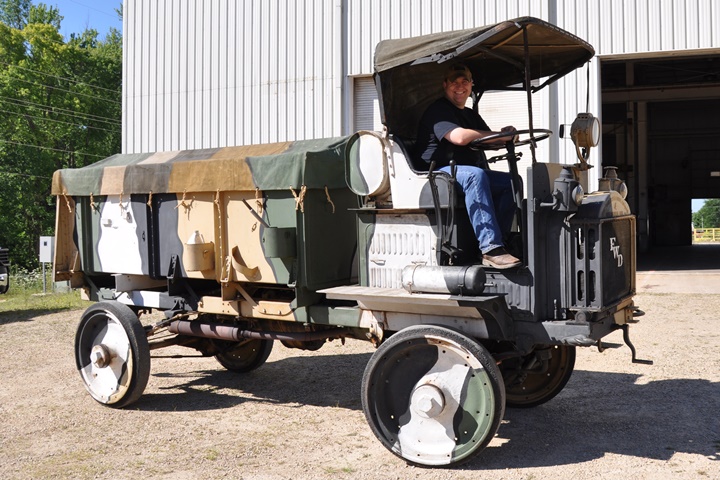
The FWD Seagrave Museum in Clintonville, WI
has a working example of a Model B. Photo courtesy of the Tim
Wright Collection.
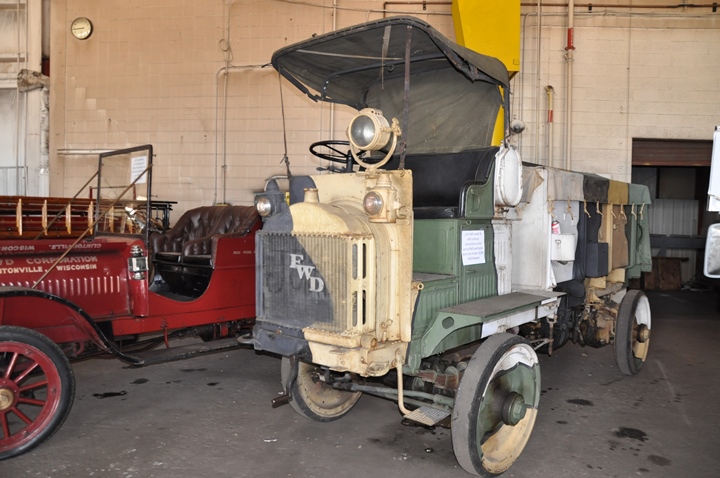
Photo courtesy of the Tim Wright Collection.
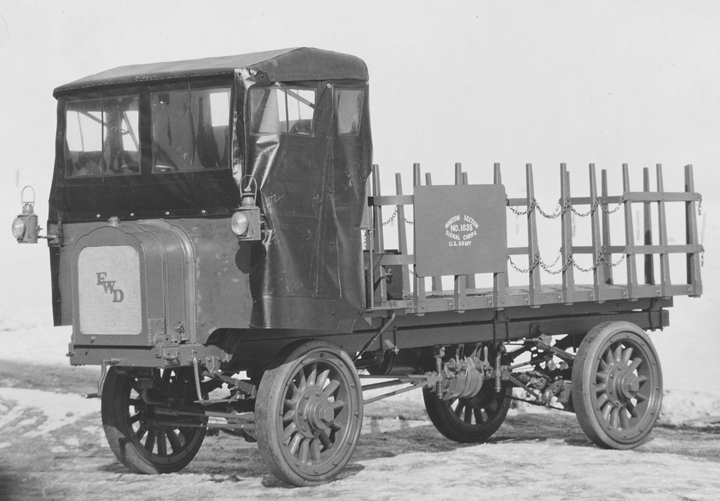
This FWD Model B belonged to the Army Signal
Corps Aviation Section and is truck number 1035. Note that
the cab has been weatherized by a clear plastic and rubber enclosure.
Photo courtesy of the Tim Wright Collection.
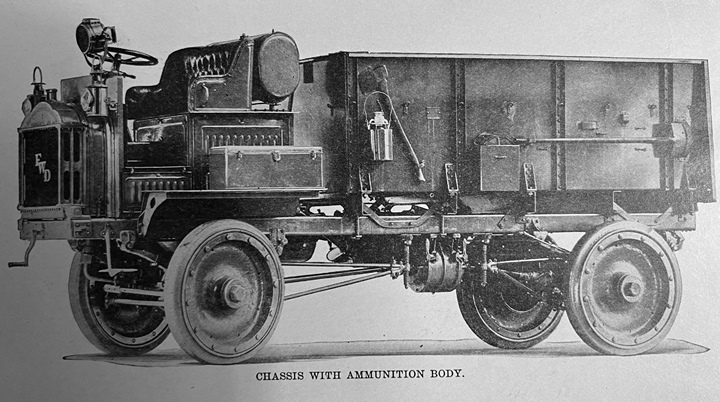
This image from the FWD Handbook shows Model B-1917
equipped with a steel ammunition body. The transfer case is
a gear driven unit as described in Mr. Zachow's and Mr. Besserdich's Patent
No. 907,940. This 1908 patent was for a "Power Applying
Mechanism." In World War Two the company used chain driven
transfer cases. Photo courtesy of the Tim Wright Collection.
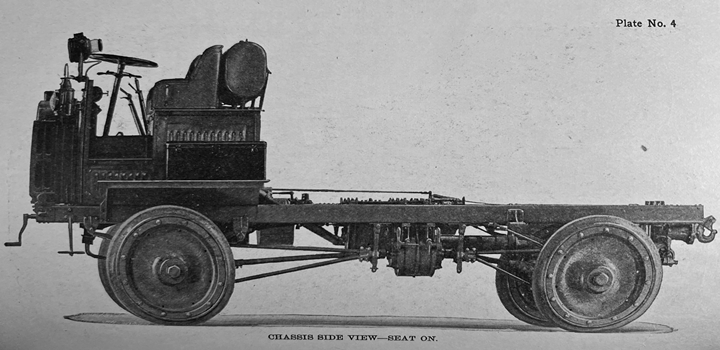
Photo courtesy of the Tim Wright Collection.
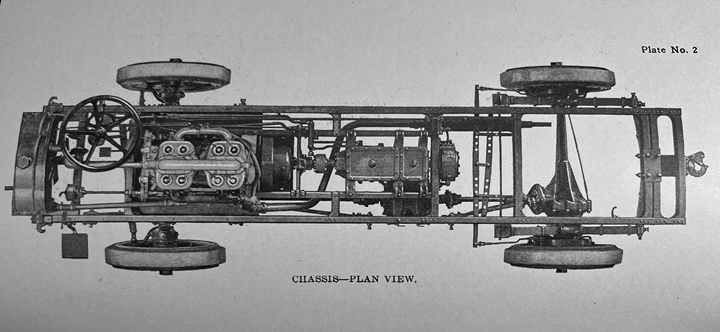
Photo courtesy of the Tim Wright Collection.
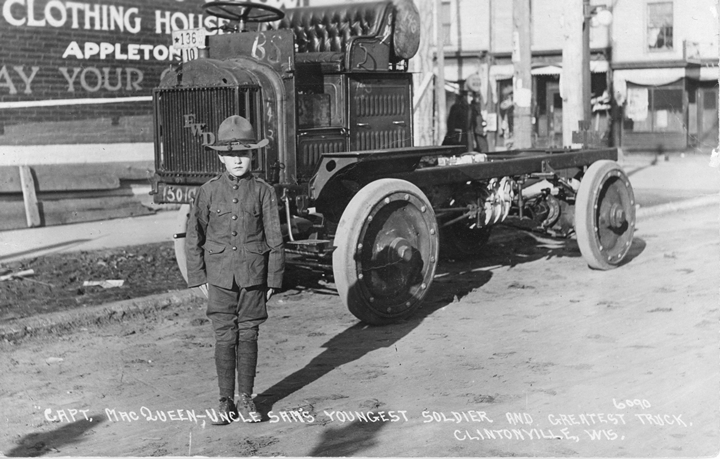
Photo courtesy of the Tim Wright Collection.
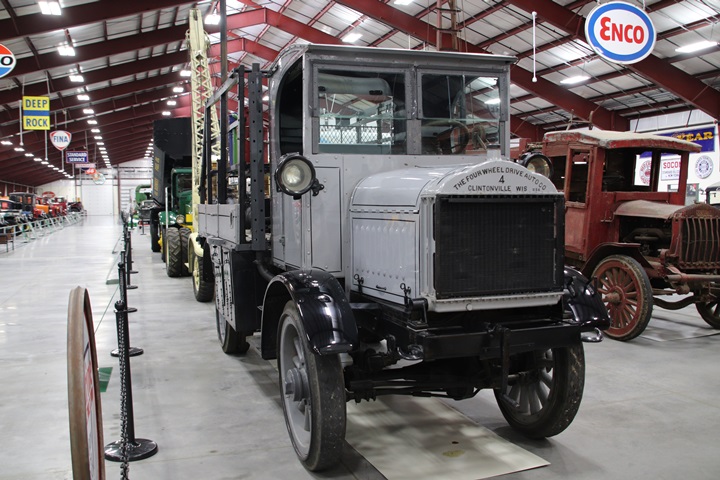
This 1926 FWD Model BT is on display at the
Iowa 80 Trucking Museum. Note that the truck and the location of
manufacture is well identified on the top of the radiator housing.
Author's photo added 1-13-2024.
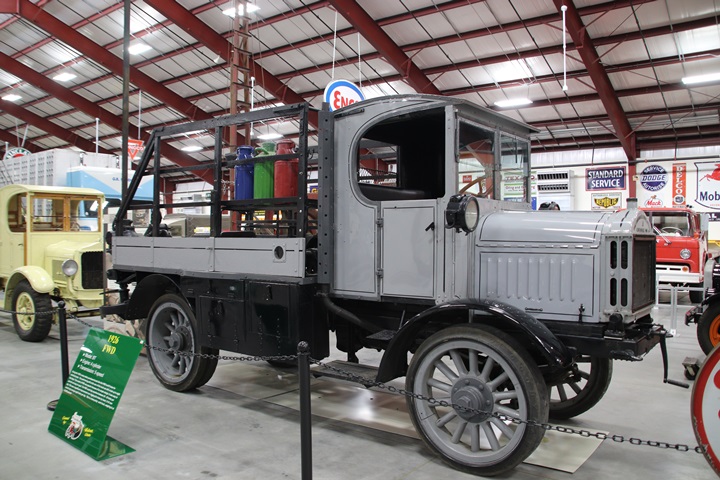
The Model BT was a heavy duty work truck weighing 13,400 lbs. Author's
photo added 1-13-2024.
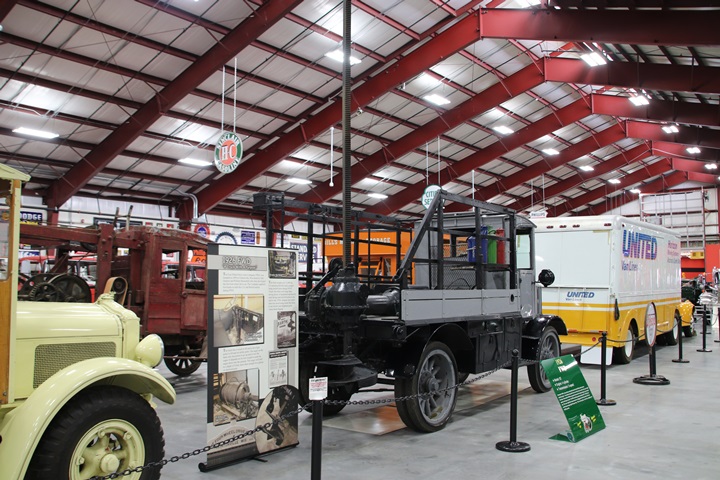
Mounted on the rear of the truck is a boring machine that could bore
holes up to eight feet deep. Author's photo added 1-13-2024.
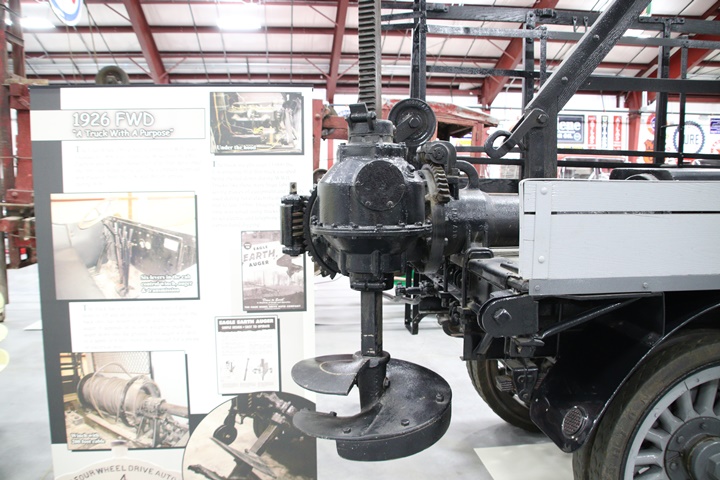
The boring machine could bore 25-30 holes
per day compared to 8-10 men being able to bore only an average of eight
per day. During the 1920s and 1930s, the United States was
undergoing an intense program of rural electrification. The FWD
Model BT with the boring machine was instrumental in boring holes for
power poles throughout the United States. Author's photo added
1-13-2024.
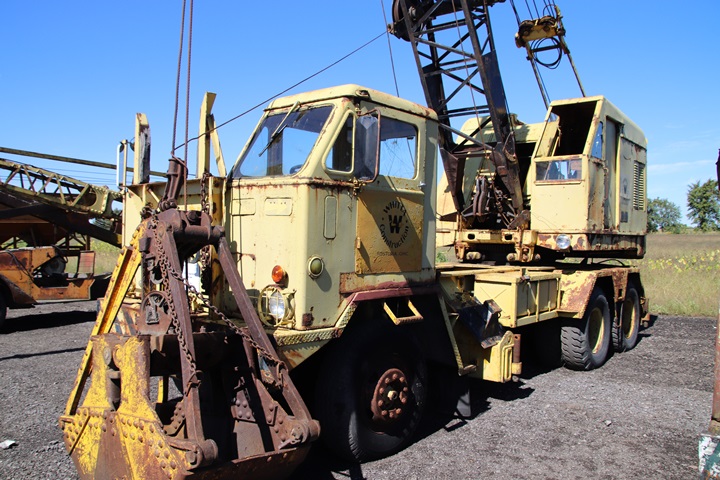
This former military M20
crane carrier has an FWD chassis and a Gar Wood crane. It is part
of the large and excellent collection at the Historical Construction
Equipment Association at Bowling Green, OH. Note that FWD departed
from its normal 4x4 configuration and specifically designed and built
the 6x6 chassis for this vehicle.
Author's photo added 1-13-2024.
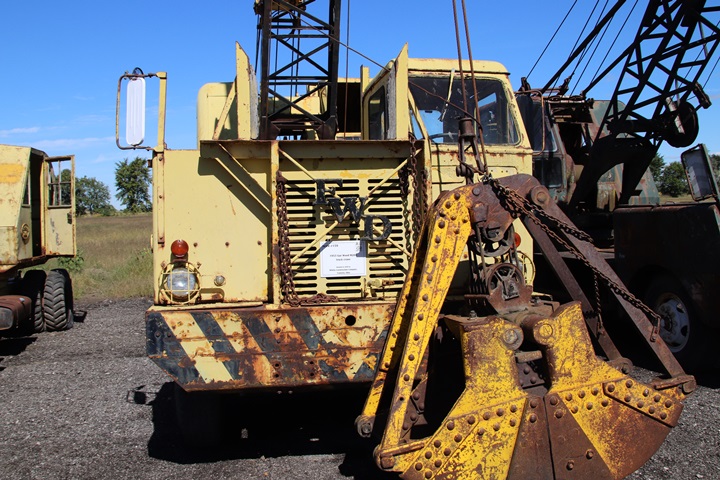
Author's photo added 1-13-2024.
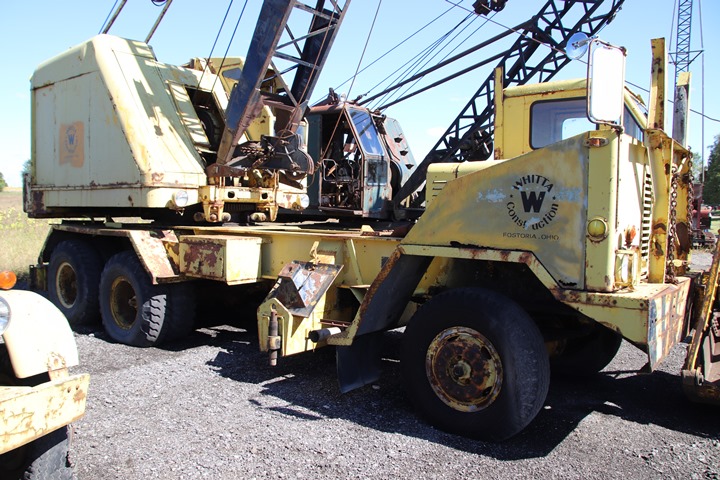
FWD began production of this unit in 1952 as
the model MUC. The MUC chassis during its service time had other
cranes and shovels mounted on it. However, the units with the Gar
Wood crane were most prominent and eventually designated as M20s.
This particular one was purchased as military surplus by a construction
company in Ohio and then donated to the
Historical Construction Equipment
Association in 2020.
Author's photo added 1-13-2024.
World War Two: After World War One, FWD sold its patent rights to the United States
Army. This allowed the American military to have other truck
companies begin to use the patented four-wheel drive system on a variety
of different models and sizes. When the United States military
began ordering trucks for its use in World War Two, it had a larger
selection of companies from which to
choose to provide all-wheel drive vehicles. Also, in trucks
larger than 2-1/2-tons, the U.S. Army preferred 6x6 vehicles.
Because the Four-Wheel Drive Auto Company specialized in 4x4 trucks, the
company was not considered for major Army contracts. Therefore,
the company's 4-ton 4x4 HAR series trucks lost out to Diamond T's 4-ton 6x6
truck during World War Two. FWD also had the SU-COE series 5-6-ton
4x4 trucks which did not fit into the standard size of trucks the U.S.
Army had developed. Also, FWD was located in a small town of only
several thousand persons in northern Wisconsin which did not have the capacity
or the estimated workforce to produce trucks in the quantities
that the U.S. Army was going to need.
While the U.S. military, for the most part, was
not interested in FWD's products during World War Two, Great Britain
was. The British military favored 4x4 trucks and took all of
the FWD trucks it could get. Canada and the USSR also received
some, but Great Britain was the biggest user of the trucks built in
Clintonville, WI. As noted at the top of this page, the USMC used
a small number of modified SU-COEs in the Pacific. The U.S. Army
Corps of Engineers and the U.S. Navy also purchased small quantities of
FWD trucks during World War Two.
Awards: The Four Wheel Drive Auto Company, while not a big
producer for the U.S. military, was still recognized for its
contributions to the war effort by the number of awards it received.
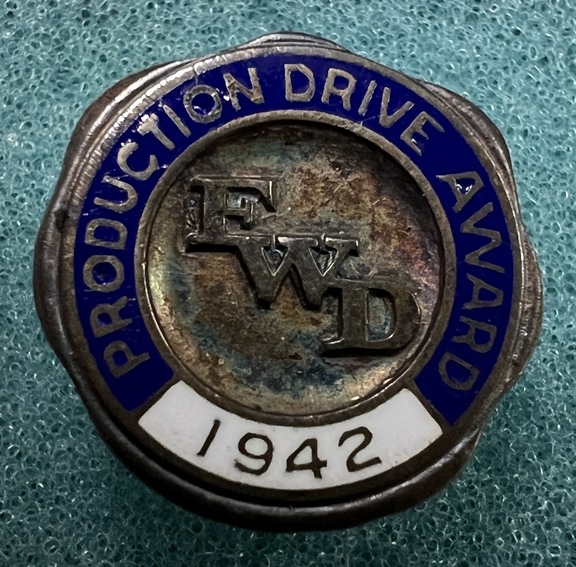
This 1942 Production Drive Award Pin appears
to have been company generated. As soon as the United States
entered World War Two, the company began a newsletter as a motivator to
increase production. The Four Wheel Drive Auto Company awarded
its employees with this pin in 1942 for their contribution to meeting
schedules and getting trucks out the back door.
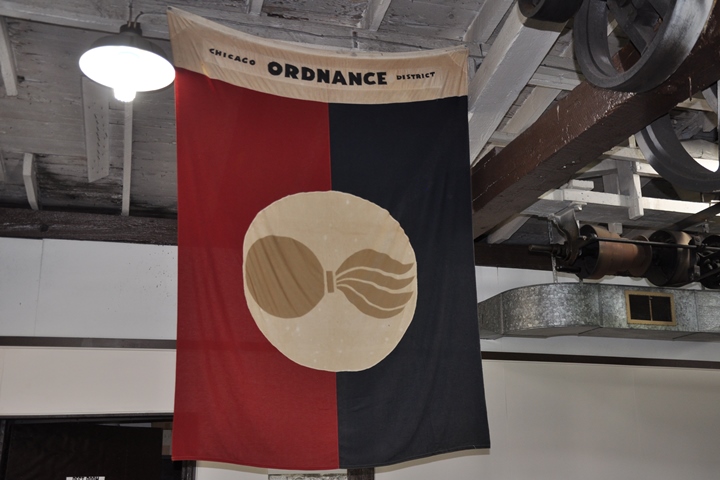
The U.S. Ordnance Chicago District awarded the company its own flag.
This is the only one I have ever seen in my years of researching World
War Two companies. This may well have been an award that only the
Chicago District did for companies with which it worked. In the
case of FWD, one of the main reasons given for the award was that it
disassembled HAR-1 trucks after testing to be packed into crates
so that they took up less shipping space on railcars and ships. FWD was a
leader in this type of operation. Photo courtesy of the Tim
Wright Collection.
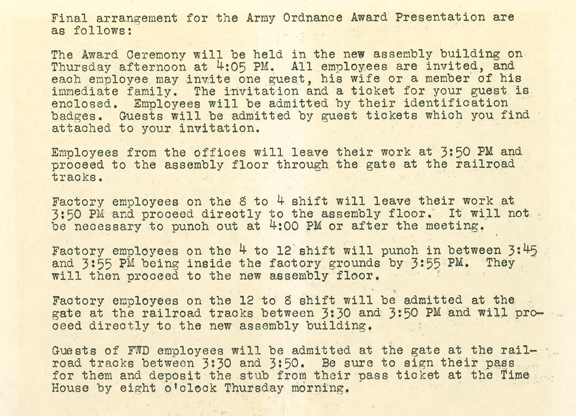
This document gives the FWD employees
instruction for attending the Army Ordnance Award ceremony.
Apparently, FWD had just completed an expansion with a new final
assembly building in which it held the presentation. Photo courtesy of the Tim
Wright Collection.
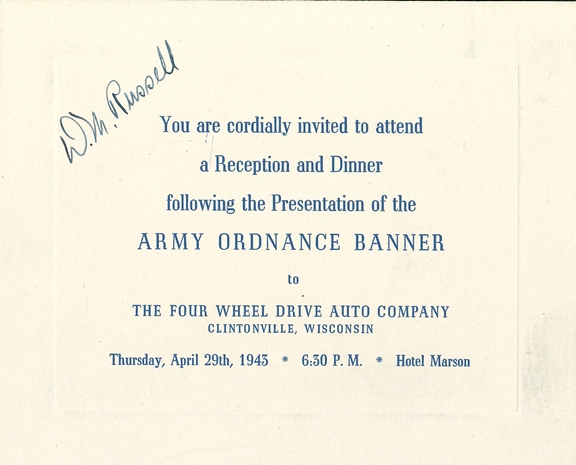
This took place on second shift. It
remains to be seen whether the second shift workers were allowed to
attend this dinner. Photo courtesy of the Tim
Wright Collection.
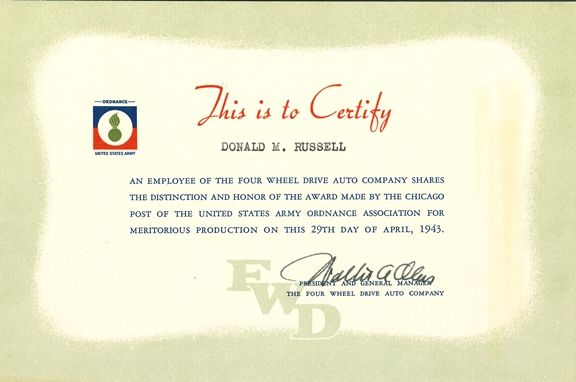
Each employee received a certificate with
his or her name on it. This is very similar to the certificate
that was awarded employees who won the Army-Navy "E" Award. Photo courtesy of the Tim
Wright Collection.
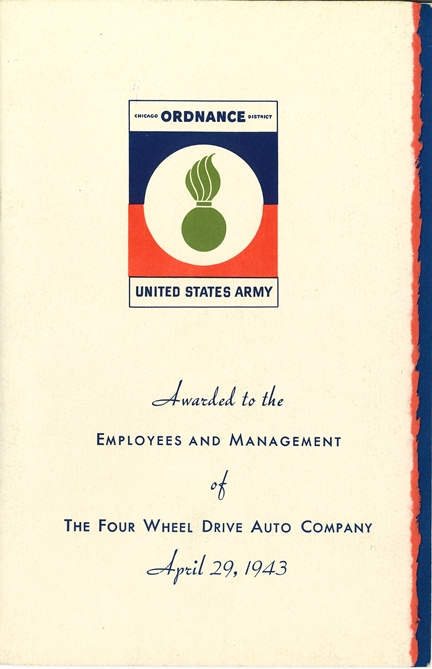
The program that each employee received is
very similar to the ones given out for the "E" Award. Photo courtesy of the Tim
Wright Collection.
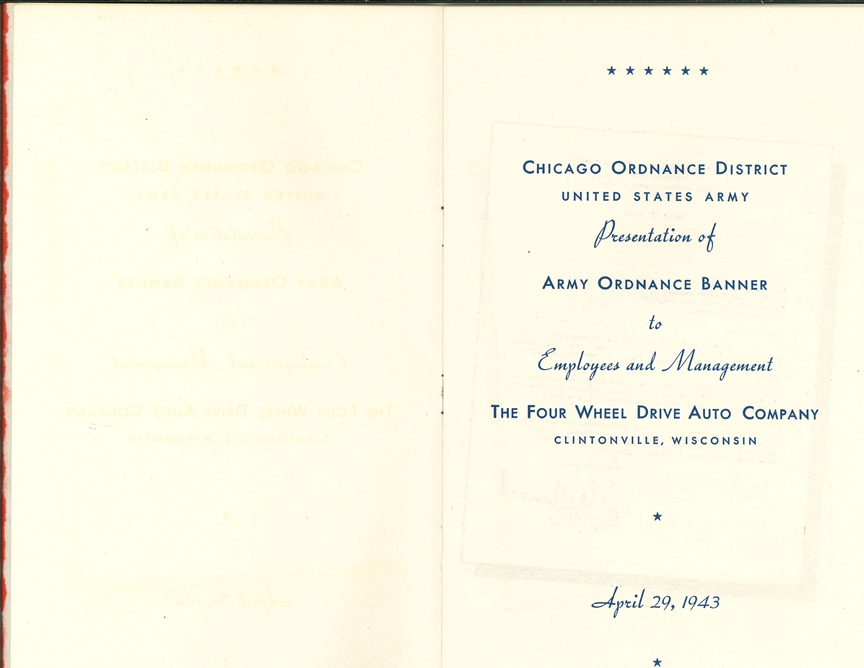
Photo courtesy of the Tim
Wright Collection.
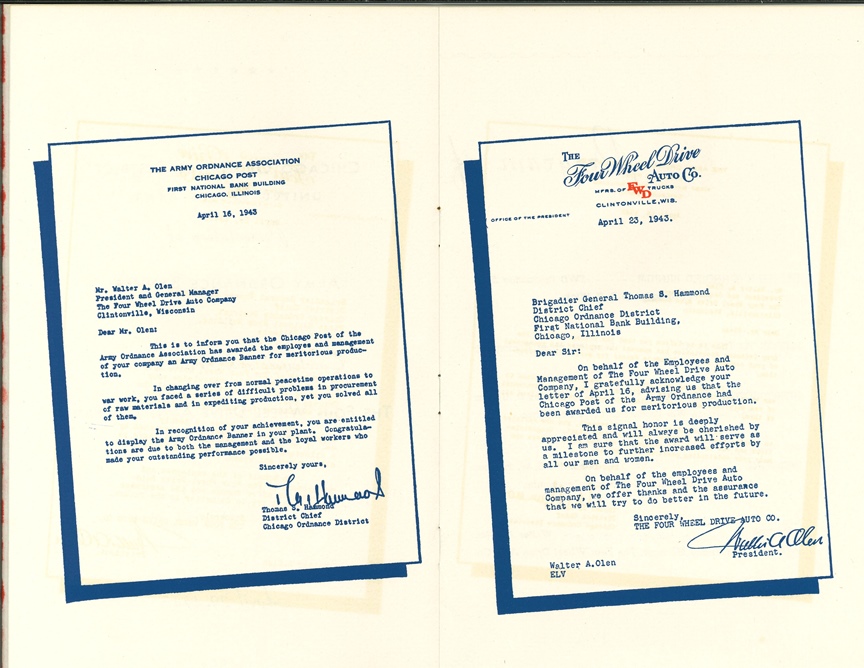
Photo courtesy of the Tim
Wright Collection.
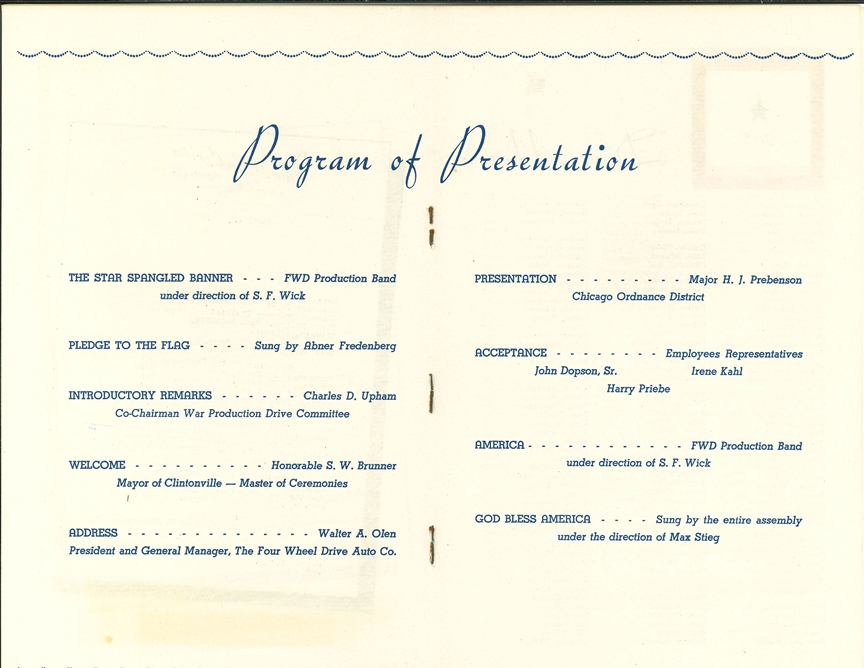
Photo courtesy of the Tim
Wright Collection.
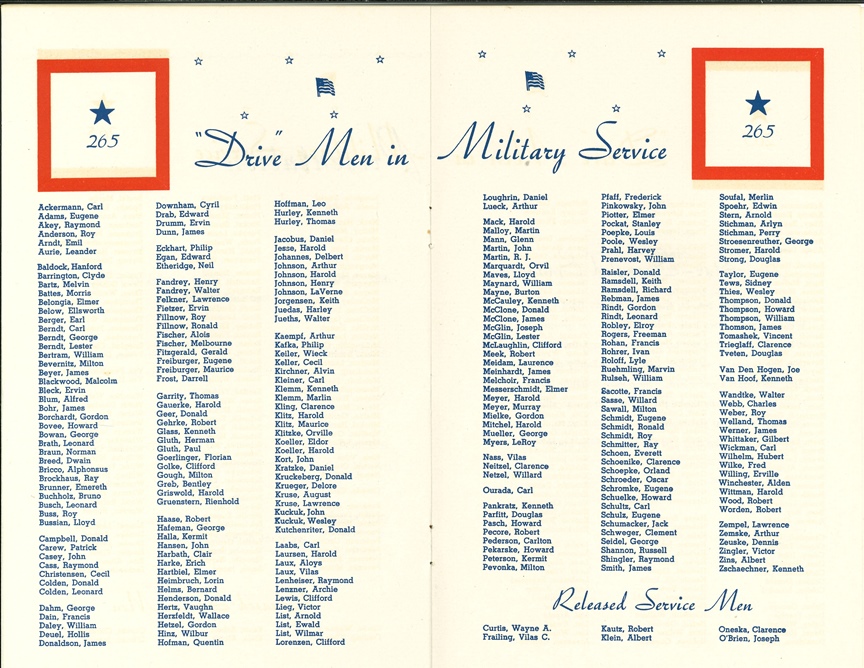
At the end of 1944, the FWD Clintonville
operation had 303 salaried employees and 1,850 hourly workers.
Having had 265 or 12.4% of the company's employees enter the military no
doubt resulted in a big push for replacements. Photo courtesy of the Tim
Wright Collection.
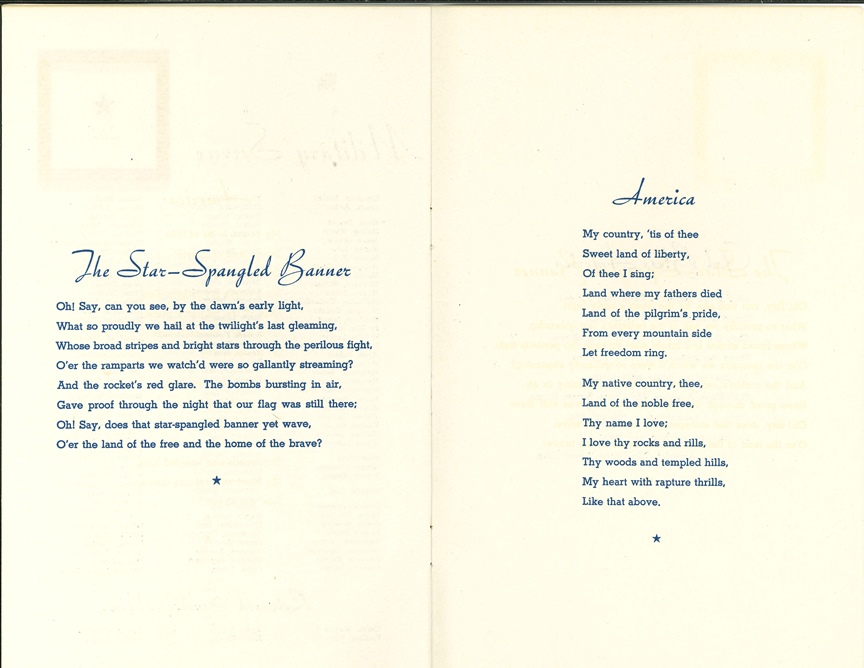
Photo courtesy of the Tim
Wright Collection.
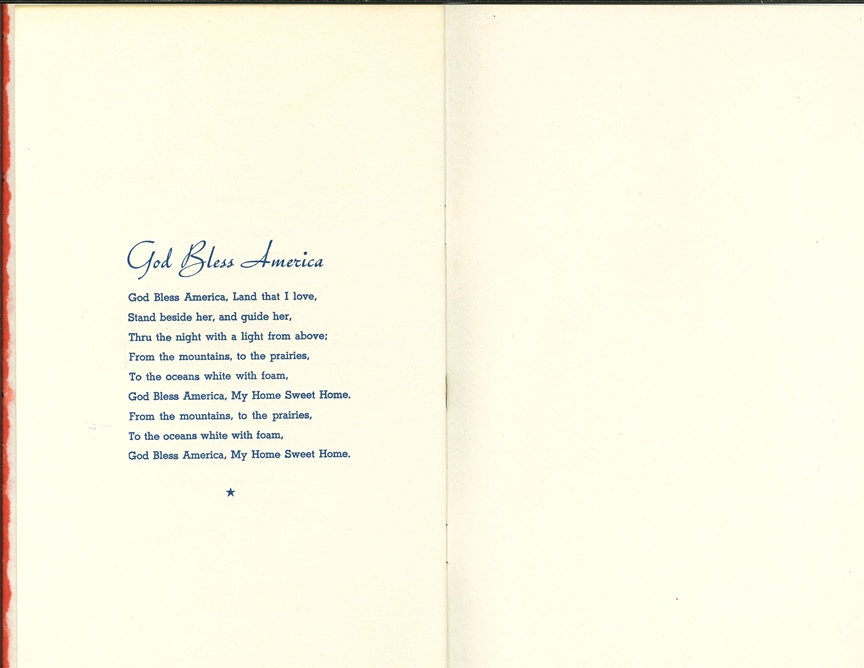
Photo courtesy of the Tim
Wright Collection.
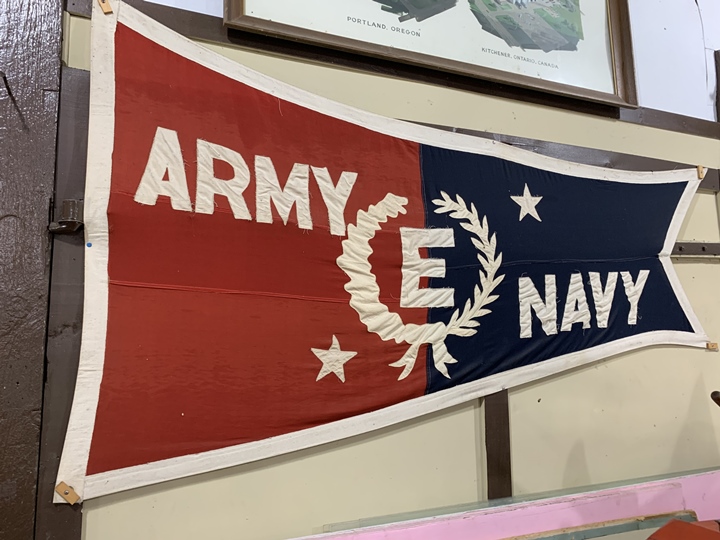
This award shows that while the Four Wheel
Drive Auto Company did not have the product line and capacity the U.S.
Army needed in World War Two, the company was producing trucks for the
Allies ahead of schedule and without labor strikes. The company
was awarded Army-Navy "E" flag by the U.S. Army four times during
World War Two. In other words, the company was doing all the right
things to get trucks out the door to Great Britain, Canada, and the
USSR. This "E" flag is on display at the FWD Seagrave Museum in
Clintonville, WI. This is the third of four flags the company was
awarded, as it has two stars on it. The original flag had no
stars, and a star was added each time the award was renewed every six
months. FWD was awarded its first "E" award on December 16, 1943.
Photo courtesy of the Tim Wright Collection.
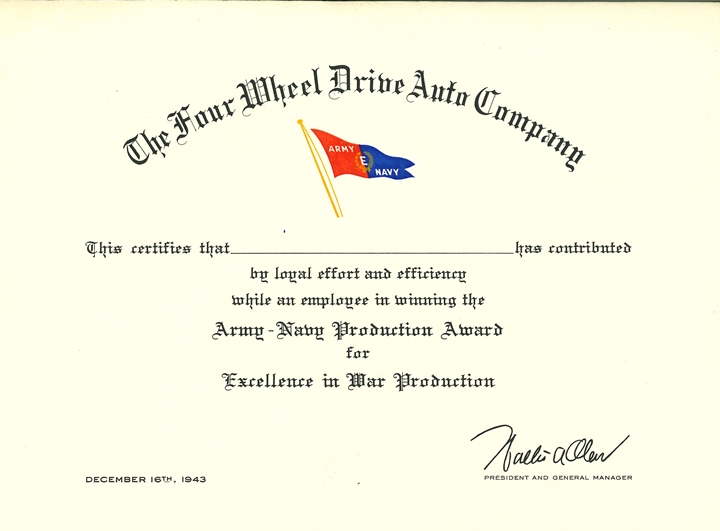
Photo courtesy of the Tim Wright Collection.
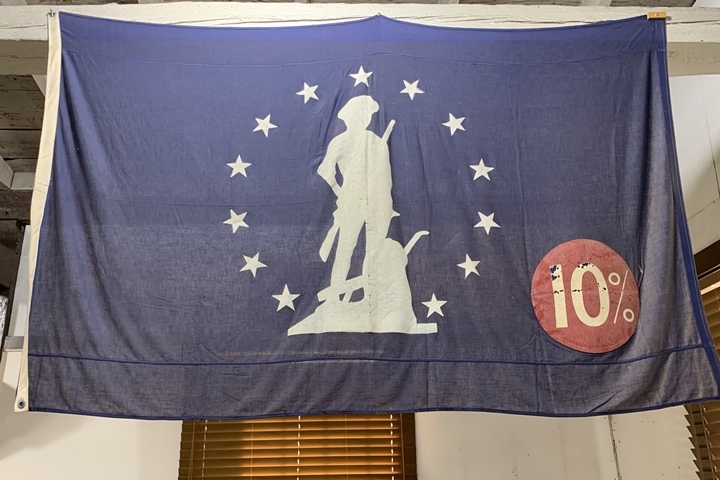
This flag was awarded for 100% FWD employees' participation in purchasing at least
10% of their wages in U.S. Savings Bonds. Photo courtesy of the
Tim Wright Collection.
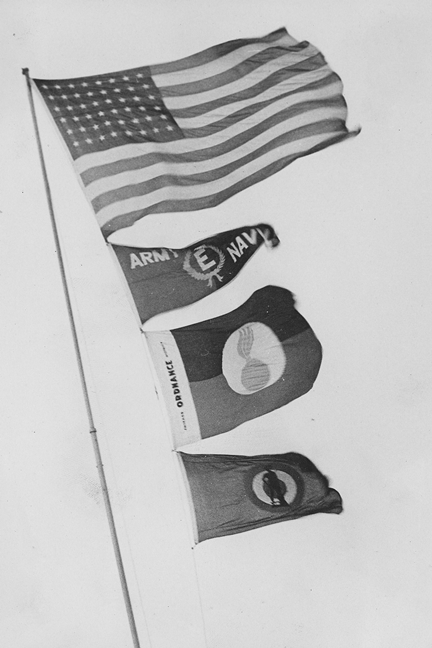
This image shows the U.S. Treasury's Bulls-eye Flag
at the bottom. The Treasury Department contracted with FWD five
times during World War Two. Photo from FWD World War Two
newsletter in the Tim Wright Collection.
Four Wheel Drive Auto Company World War Two
Products: There are 13 tables on this page. Eleven are
in this section.
Table 1 is a listing of all of the trucks the
Four Wheel Drive Auto Company built in World War Two. For the
casual reader, this may be all one needs. FWD built an estimated
15,724 trucks during World War Two.
Table 2 shows that the Four Wheel Drive Auto
Company's main plant at Clintonville, WI plant had $92,488,000 in major
contracts during World War Two.
Table 3 shows that the Four Wheel Drive Auto
Company's Steven's Point, WI plant had $3,122,000 in major contracts.
Table 4 shows the FWD major product
categories. Trucks, truck
chassis, and tractors comprised 92.1% of the contracts.
Spare parts was the next largest at 4.5%.
Table 5 shows the FWD-produced vehicles accepted
by Army Ordnance. This was 12,140 vehicles.
Table 6 associates data from Tables 2 and 5
for the Clintonville plant.
Table 7 is data on British Commonwealth
purchased HAR-01 and HAR-03 vehicles. These were ordered before
Lend-Lease was enacted and were direct purchases.
Table 8 is data on USMC type SU-COE trucks.
Table 9 is data U.S. Army Corps of Engineers SU-COE Trucks.
Table 10 contains FWD SU-COE Serial Numbers.
Table 11 contains information on Four Wheel Drive Auto
Company's Lend-Lease Transfers.
Table 12 associates data from Tables 2 and 5
for the Stevens Point plant. This is in the Stevens Point section.
Table 13 is in the SU-COE section.
|
Table 1 - Total Four Wheel Drive Auto Company World War Two Truck Production |
|
Type |
FWD Model |
Quantity |
Comments |
|
Truck,
3-1/2-ton 4x4 with winch behind cab, chassis and cab only |
HAR-01 |
1,633 |
814 units are a verified quantity. 819 units are a
estimated quantity. From Table 7. |
|
Tractor,
4-ton, 4x4 |
HAR-03 |
1,524 |
This is a verified quantity. Purchased by Canada for its use and for
use by Great Britain. From Table 7. |
| Truck, 4-ton
4x4, Cargo |
HAR-1 |
7,000 |
This is a verified quantity. Purchased
by Army Ordnance for Lend-Lease to Canada, Great Britain, and
the USSR. From Table 6. |
|
Truck, 4x4, Dump |
Unknown |
6 |
This is an estimated quantity. This
is based on a photo of six dump trucks that purchased for the
Navy Construction Battalions.
|
|
Truck 4-ton, 4x4, Bridge Erecting |
SU-COE |
71 |
This is an estimated quantity. These
were for the Army Corp of Engineers. From Table 9.
|
| Truck, 5-6-ton,
4x4, Cargo |
SU-COE |
1,460 |
This is a verified quantity. Purchased
by Army Ordnance for Lend-Lease to Canada, Great Britain, and
the USSR. From Table 6. |
| Truck, 5-6-ton,
4x4, Prime Mover |
SU-COE |
2,700 |
This is a verified quantity. Purchased
by Army Ordnance for Lend-Lease to Canada, Great Britain, and
the USSR. From Table 6. |
| Truck, 5-6-ton,
4x4, Cargo |
SU-COE |
250 |
This is an estimated quantity.
120 were
built at the Stevens Point, WI operation beginning in May 1943.
From Table 8. |
| Truck,
5-6(7)-ton, 4x4, Cargo |
|
700 |
This is a verified quantity. Purchased
by Army Ordnance for the Department of Agriculture. From
Table 6. |
| Truck,
5-6(7)-ton, 4x4, Tractor |
|
50 |
This is a verified quantity. Purchased
by Army Ordnance for the Department of Agriculture. From
Table 6. |
| Truck,
5-6(7)-ton, 4x4, Timber Hauler |
|
35 |
This is a verified quantity. Purchased
by Army Ordnance for the Department of Agriculture. From
Table 6. |
| Truck, 6-ton,
6x6, W/W Chassis for Bridge Erecting |
Same as Brockway and White |
168 |
This is a verified quantity. Purchased
by Army Ordnance for U.S. Army. From Table 6. |
| Truck, 6-ton,
6x6, W/W Chassis for Crane |
Same as Brockway |
26 |
This is a verified quantity. Purchased
by Army Ordnance for U.S. Army. From Table 6. |
| 12-ton 6x4
Tractor M20 |
Same as Diamond T
Model 980, 981 |
100 |
Several sources note that FWD built
100 Diamond T Model 980s and 981s under contract. Because they
were built under contract, the data plate would still note it
was a Diamond T vehicle. There is also a photo of this type
of
truck in World War Two parade in Clintonville, WI. |
| Truck, 15-ton,
4x4, Tractor |
|
1 |
This is a verified quantity. From
Table 6. |
|
Total |
|
15,724 |
|
|
Table 2 - Four Wheel Drive Auto
Company's Major World War Two Contracts - Clintonville, WI Plant
The information below
comes from the "Alphabetical Listing of Major War Supply
Contracts, June 1940 through September 1945." This was
published by the Civilian Production Administration,
Industrial Statistics Division. |
|
Product - Customer |
Contract Amount |
Contract Awarded
|
Completion
Date |
Contract Number |
Associated Table(s) |
|
Trucks - Foreign |
$3,081,000 |
9-1940 |
3-1941 |
A-1395 |
7 |
| Tools Machine -
Foreign |
$194,000 |
9-1940 |
11-1940 |
A-1534 |
|
|
Trucks - Foreign |
$3,061,000 |
10-1940 |
3-1941 |
A-1593 |
7 |
| Turret Parts -
Navy |
$293,000 |
5-1941 |
1-1942 |
NOS-886014 |
|
| Trucks - USMC |
$423,000 |
5-1941 |
11-1941 |
NOM-30129 |
8 |
| Trailers - Army |
$196,000 |
6-1941 |
8-1942 |
227-SC-3454 |
|
|
Tractors - Army |
$190,000 |
7-1941 |
1-1942 |
398-QM-35 |
5, 6 |
| Transportation
Equipment - Army Engineers |
$248,000 |
8-1941 |
11-1941 |
145-ENG-249 |
9 |
| Tractors -
Foreign |
$760,000 |
9-1941 |
3-1942 |
- |
7 |
| Tools Machine -
Army Engineers |
$172,000 |
10-1941 |
4-1942 |
978-ENG-160L |
|
|
Trucks - Army |
$2,482,000 |
11-1941 |
9-1942 |
2710-ORD-2781D |
5, 6 |
| Trucks - Army |
$289,000 |
12-1941 |
3-1942 |
398-QM-183L |
5, 6 |
| Tractors -
Foreign |
$690,000 |
1-1942 |
6-1942 |
- |
7 |
| Tractors -
Foreign |
$1,769,000 |
1-1942 |
7-1942 |
- |
7 |
| Trucks - USMC |
$577,000 |
2-1942 |
8-1942 |
NOM-33200 |
8 |
| Spare Parts
- USMC |
$54,000 |
3-1942 |
6-1942 |
NOM-33832 |
|
|
Cargo Trucks - Army |
$35,225,000 |
7-1942 |
12-1944 |
271-ORD-2675 |
5, 6 |
| Trucks - USMC |
$913,000 |
11-1942 |
5-1943 |
NOM-38159 |
8 |
| Toboggans - Army |
$109,000 |
11-1942 |
3-1942 |
271-ORD-2782 |
|
| Truck Parts
- Army |
$78,000 |
12-1942 |
4-1943 |
271-ORD-5589 |
|
| Truck Parts
- Army |
$359,000 |
12-1942 |
3-1944 |
271-ORD-5576 |
|
| Truck Parts
- Army |
$359,000 |
12-1942 |
3-1944 |
271-ORD-5584 |
|
| Machinery Road -
Army Engineers |
$385,000 |
1-1943 |
1-1943 |
1088-ENG-2036 |
9 |
|
Trucks - Army |
$8,500,000 |
8-1943 |
9-1944 |
11022-ORD-213S |
5, 6 |
| Truck Parts -
Treasury |
$110,000 |
5-1944 |
11-1944 |
TPS-55706L |
|
| Cargo Trucks -
Army |
$16,345,000 |
5-1944 |
3-1945 |
11022-ORD-213S |
5, 6 |
| Truck Parts -
Treasury |
$467,000 |
8-1944 |
3-1945 |
TPS-61389L |
|
| Motor Vehicle
Parts - Treasury |
$416,000 |
8-1944 |
12-1944 |
TPS-62992L |
|
|
Trucks - Army |
$7,030,000 |
10-1944 |
6-1945 |
11022-ORD-5389 |
5, 6 |
| Truck Parts
- Army |
$360,000 |
1-1945 |
11-1945 |
11022-ORD-6612 |
|
| Truck Parts
- Army |
$750,000 |
1-1945 |
11-1945 |
11022-ORD-6611 |
|
| Truck Parts
- Army |
$303,000 |
3-1945 |
12-1945 |
11022-ORD-7923 |
|
| Truck Parts -
Treasury |
$77,000 |
4-1945 |
12-1945 |
TPS-79745L |
|
|
Truck Chassis - Army |
$791,000 |
4-1945 |
6-1946 |
11022-ORD-8759 |
5, 6 |
| Truck Parts
- Army |
$1,028,000 |
4-1945 |
1-1946 |
11022-ORD-8523 |
|
| Truck Chassis
Cabs - Treasury |
$2,202,000 |
7-1945 |
9-1945 |
TPS-89073L |
|
| Cargo Bodies -
Treasury |
$2,202,000 |
7-1945 |
9-1945 |
TPS-89074L |
|
| Total |
$92,488,000 |
|
|
|
|
|
Table 3 - Four Wheel Drive Auto
Company's Major World War Two Contracts - Stevens Point, WI
Plant
The information below
comes from the "Alphabetical Listing of Major War Supply
Contracts, June 1940 through September 1945." This was
published by the Civilian Production Administration,
Industrial Statistics Division. |
|
Product - Customer |
Contract Amount |
Contract Awarded
|
Completion
Date |
Contract Number |
| Trucks - Army |
$3,122,000 |
3-1945 |
8-1945 |
11022-Ord-7890 |
Table 4 - Four Wheel Drive Auto Company's Major World War Two Product Categories
Includes both Clintonville and Stevens Point, WI
plants |
|
Product |
Amount |
Percentage |
|
Trucks, Truck Chassis,
Tractors (Clintonville and Stevens Point) |
$88,083,000 |
92.1% |
|
Tools Machine |
$366,000 |
0.4% |
| Turret Parts |
$293,000 |
0.3% |
| Trailers |
$196,000 |
0.2% |
| Spare
Parts |
$4,361,000 |
4.5% |
| Toboggans |
$109,000 |
0.1% |
| Cargo Bodies -
Treasury |
$2,202,000 |
2.3% |
|
Total |
$95,610,000 |
~100% (99.9%) |
Table 5 -
Four Wheel Drive Auto Company Vehicles
Accepted by Detroit Ordnance, US Army
The information below comes from "Summary Report of
Acceptances, Tank-Automotive Material, 1940-1945."
Published by Army Services Forces, Office, Chief of
Ordnance-Detroit, Production Division, Requirements and
Progress Branch
January 21, 1946. |
|
Type |
FWD Model |
Contract Number |
1940 |
1941 |
1942 |
1943 |
1944 |
1945 |
Total |
| Truck, 4-ton,
4x4, Cargo |
HAR-1 |
171-2675 |
|
|
|
4,584 |
2,416 |
|
7,000 |
| |
|
|
|
|
|
|
|
|
|
| Truck, 5-6-ton,
4x4, Cargo |
SU-COE |
11-022-213 |
|
|
|
|
500 |
|
500 |
| Truck, 5-6-ton,
4x4, Cargo |
SU-COE |
11-022-5389 |
|
|
|
|
|
721 |
721 |
| Truck, 5-6-ton,
4x4, Cargo |
SU-COE |
11-022-5389 |
|
|
|
|
|
239 |
239 |
|
Total Truck, 5-6-ton,
4x4, Cargo |
SU-COE |
|
|
|
|
|
500 |
960 |
1,460 |
| |
|
|
|
|
|
|
|
|
|
| Truck, 5-6-ton,
4x4, Prime Mover |
SU-COE |
11-022-213 |
|
|
|
|
1637 |
863 |
2,700 |
| Truck,
5-6(7)-ton, 4x4, Cargo |
|
271-2781l DA 181 |
|
|
700 |
|
|
|
700 |
| Truck,
5-6(7)-ton, 4x4, Tractor |
|
398-QM-35 / DA 35 |
|
32 |
18 |
|
|
|
50 |
| Truck,
5-6(7)-ton, 4x4, Timber Hauler |
CU |
398-QM-183L / DA 183 |
|
|
35 |
|
|
|
35 |
| Truck, 6-ton,
6x6, W/W Chassis for Bridge Erecting |
same as Brockway |
11-022-7890 |
|
|
|
|
|
168 |
168 |
| Truck, 6-ton,
6x6, W/W Chassis for Crane |
same as Brockway |
11-022-5759 |
|
|
|
|
|
26 |
26 |
| Truck, 15-ton,
4x4, Tractor |
|
3029 |
1 |
|
|
|
|
|
1 |
| Total |
|
|
|
|
|
|
|
|
12,140 |
|
Table 6 - This
table associates the contracts from Table 2 and Table 5 |
|
From Table 5 |
|
From Table 2 |
|
Type |
FWD Model |
Total |
Common
Contract Number |
Product - Customer |
Contract Amount |
Contract Awarded
|
Completion
Date |
Average Cost per Unit |
| Truck, 4-ton,
4x4, Cargo |
HAR-1 |
7,000 |
271-ORD-2675 |
Cargo Trucks -
Army |
$35,225,000 |
7-1942 |
12-1944 |
$5,032 |
| |
|
|
|
|
|
|
|
|
| Truck, 5-6-ton,
4x4, Cargo |
SU-COE |
500 |
|
|
|
|
|
|
| Truck, 5-6-ton,
4x4, Prime Mover |
SU-COE |
2,700 |
|
|
|
|
|
|
| Total
|
|
3,200 |
11-022-213 and 11022-ORD-213S |
Trucks - Army |
$8,500,000 |
8-1943 |
9-1944 |
$2,656 |
| |
|
|
|
|
|
|
|
|
| Truck, 5-6-ton,
4x4, Cargo |
SU-COE |
721 |
|
|
|
|
|
|
| Truck, 5-6-ton,
4x4, Cargo |
SU-COE |
239 |
|
|
|
|
|
|
| |
|
960 |
11-022-5389 |
Trucks - Army |
$7,030,000 |
10-1944 |
6-1945 |
$7,322 |
| |
|
|
|
|
|
|
|
|
| Truck,
5-6(7)-ton, 4x4, Cargo |
|
700 |
2710-Ord-2781 / DA 35 |
Trucks - Army |
$2,482,000 |
11-1941 |
9-1942 |
$3,545 |
| |
|
|
|
|
|
|
|
|
| Truck,
5-6(7)-ton, 4x4, Tractor |
|
50 |
398-QM-35 |
Tractors - Army |
$190,000 |
7-1941 |
1-1942 |
$3,800 |
| |
|
|
|
|
|
|
|
|
| Truck,
5-6(7)-ton, 4x4, Timber Hauler |
|
35 |
398-QM-183L
/ DA 183 |
Trucks - Army |
$385,000 |
12-1941 |
3-1942 |
$8,257 |
| |
|
|
|
|
|
|
|
|
| Truck, 6-ton,
6x6, W/W Chassis for Crane |
same as Brockway |
26 |
11022-Ord-8759 |
Truck Chassis -
Army |
$791,000 |
4-1945 |
6-1946 |
$30,423 |
| |
|
|
|
|
|
|
|
|
| Truck, 15-ton,
4x4, Tractor |
|
1 |
Unknown |
|
Less than $50,000, so not shown
on Major Contract Listing |
|
|
|
| |
|
|
|
|
|
|
|
|
| Stevens Point
Plant |
|
|
|
|
|
|
|
|
| Truck, 6-ton,
6x6, W/W Chassis for Bridge Erecting
Parts based on original Brockway
truck |
same as Brockway,
WL, White |
168 |
11022-Ord-7890 |
Trucks
- Army |
$3,122,000 |
3-1945 |
8-1945 |
$18,583 |
There is a problem in Table 7 with trying to
match up known contacts for the HAR-03. Volumes and contract
values do not make any sense as they range from $1,474 to $28,750 per
unit cost. I have also done an average cost. These strange
average cost values have no effect on the number of trucks produced.
Table 7 - Four Wheel
Drive Auto Company
World War Two HAR-01 and HAR-03 Foreign Contracts
Information for this came from "FWD HAR-Series Trucks:
American Full time All-wheel Drive 'Conventions' of World War
II" published in "Wheels & Tracks" Volume 5, 1983, pages
14-33 |
|
Type |
Foreign Contract number |
Number |
Serial Numbers |
U.S. Contract Number From Table 1 |
Product - Customer |
Contract Amount |
Contract Awarded
|
Completion
Date |
Average Cost per Unit |
| HAR-01 3-1/2-ton 4x4 with winch
behind cab, chassis and cab only |
Canada USP-6382 |
Calculated as 819 |
For Canadian Use -
Unknown Serial Numbers |
A-1395 |
Trucks - Foreign |
$3,081,000 |
9-1940 |
3-1941 |
Unknown- Assumed to be $3,760 as
below |
| HAR-01 3-1/2-ton 4x4 with winch
behind cab, chassis and cab only |
Canada USP-12045 |
814 |
For British Use -
L4688568-571, L4688575-850, L4688584-587, L4785291-6090 |
A-1593 |
Trucks - Foreign |
$3,061,000 |
10-1940 |
3-1941 |
$3,760
|
|
Total Har-01 |
|
1,633 |
|
|
|
|
|
|
|
| HAR-03
4-ton 4x4 tractor |
Canada
200
USP 18311 |
1,200 |
110446-111645 Inclusive |
? |
Trucks - Foreign |
$1,769,000 |
1-1942 |
7-1942 |
$1,474 |
| HAR-03
4-ton 4x4 tractor |
Canada
203
USP 19181 |
24 |
111647-111670 Inclusive |
? |
Trucks - Foreign |
$690,000 |
1-1942 |
6-1942 |
$28,750 |
| HAR-03
4-ton 4x4 tractor |
Canada
214
USP 18311 |
300 |
111671 - 111870 Inclusive |
? |
Trucks - Foreign |
$760,000 |
9-1941 |
3-1942 |
$2,533 |
|
Total HAR-03 |
|
1,524 |
|
|
|
$3,219,000 |
|
|
$2,112 |
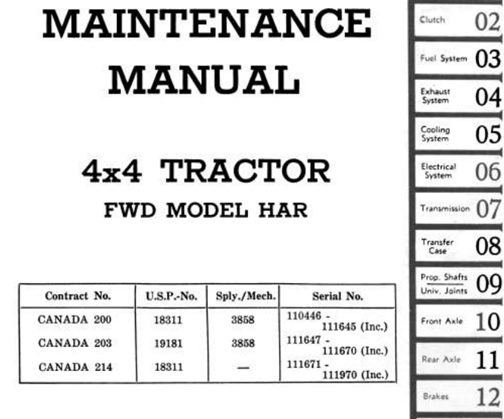
This image is from the Maintenance Manual for the
HAR-03. It provides contract and serial numbers.
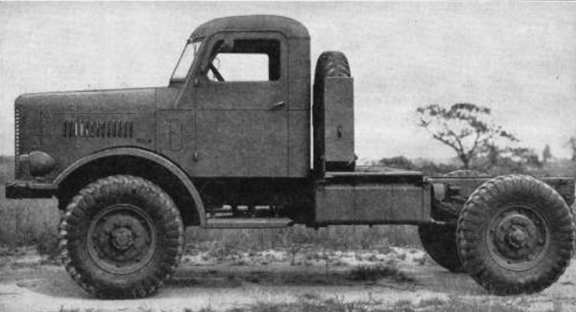
This is a HAR-03 with a Waukesha BZ 95 hp
engine.
|
Table 8 -
USMC SU-COE Trucks |
|
Product - Customer |
Contract Amount |
Contract Awarded
|
Completion
Date |
Contract Number |
Comments |
Quantity |
| Trucks - USMC |
$913,000 |
11-1942 |
5-1943 |
NOM-38159 |
The September 16, 2016, issue of
the Portage County Gazette notes that the FWD Stevens
Point Plant built 120 USMC trucks when it started production
in May 1943. While the contract was supposedly
completed in May 1943, this particular contract is the only
one of the three USMC contracts that best matches with its
dates. The photo in the Stevens Point Plant section
shows a completed USMC SU-COE at the plant. $913,000 divided
by 120 equals $7,608 cost per USMC SU-COE. |
120 |
| Trucks - USMC |
$423,000 |
5-1941 |
11-1941 |
NOM-30129 |
This is an estimated quantity. $423,000 divided by $7,608 =
55 |
55 |
| Trucks - USMC |
$577,000 |
2-1942 |
8-1942 |
NOM-33200 |
This is an estimated quantity. $577,000
divided by $7,608 = 75 |
75 |
|
Total |
|
|
|
|
|
250 |
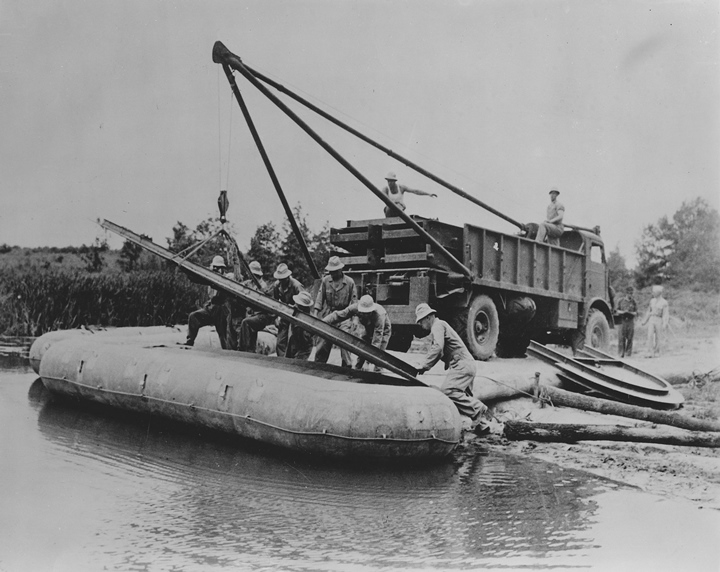
The Army Corps of Engineers purchased 28 FWD YUs
under Contract Number 145-ENG-249. This was a $248,000, contract
indicating that each FWD YU cost an average of $8,857. The YU was
the U.S. Army's first attempt to build a bridging truck. FWD
developed the design shown above which included the detachable A-frame
that was used as a crane. This was used for maneuvering the bridge
treadways into place as shown above. The FWD YU also included an
air compressor and air storage tanks for inflating pontoons.
Fourteen FWD YU bridging trucks were evaluated
during the Carolina Maneuvers. It was found that the biggest
drawback to the YU was that it took fifteen minutes to set up and
assemble the A-frame. This was considered too long for a combat
situation. Therefore, the Army Corps of Engineers suggested to use
two parallel swinging arms mounted to the truck body that could start
placing treadways in 90 seconds. This concept was generated by FWD
and it proposed another bridging truck with this design.
Concurrently, the Army Corps of Engineers was investigating other
similar methods proposed by other companies. In the end, it
decided on the Daybrook Hydraulic Corporation's design to be mounted on
Brockway 6-ton 6x6 trucks as its bridging truck.
The FWD YU shown here is being used by Army
Engineers to build a pontoon bridge at Fort Knox, KY on September 24, 1942. Photo courtesy of the
Tim Wright Collection.
The photo above and the one below are the only
known photographic evidence that the Army Corps of Engineers
purchased a number of trucks from FWD.
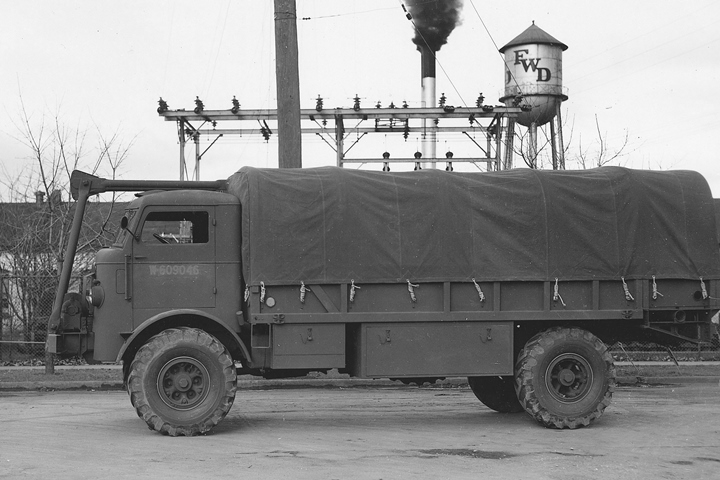
This truck has USA registration number
W-609046. Photo courtesy of the
Tim Wright Collection.
Both of the contracts below are assumed to be for the purchase of trucks
with added bridging equipment. Sometimes the contracts are not
completely clear on what is being ordered. The estimated number of
trucks estimated below is 71. While the exact cost is unknown, it
can be assumed that the Corps of Engineers purchased no more than 100
trucks.
|
Table 9 -
U.S. Army Corps of Engineers YU Trucks |
|
Product - Customer |
Contract Amount |
Contract Awarded
|
Completion
Date |
Contract Number |
Comments |
Quantity |
| Transportation
Equipment - Army Engineers |
$248,000 |
8-1941 |
11-1941 |
145-ENG-249 |
The assumed cost is $9,000 as
these trucks have bridging equipment. $248,000
divided by $9,000 = 28. |
28 |
| Machinery Road -
Army Engineers |
$385,000 |
1-1943 |
1-1943 |
1088-ENG-2036 |
The assumed cost is $9,000 as these
trucks have bridging equipment. $385,000 divided by
$9,000 = 28. |
43 |
|
Total |
|
|
|
|
|
71 |
Table 10 shows the FWD
serial numbers associated with the production of the SU-COE for Army
Ordnance. This is for reference only and is not required for the
calculation of the number of SU-COEs FWD made.
Table 10 - FWD SU-COE Serial Numbers
From Tech Manual 10-1377 dated July, 1944 |
|
Type |
Serial Numbers |
Number |
Comments |
|
Cargo Body |
62841-63191, inclusive |
350 |
|
| Cargo Body |
63441-63791, Inclusive |
350 |
|
| Cargo Body |
66173-66672, Inclusive |
500 |
|
|
Cargo Body
Total |
|
1,200 |
Table
5 shows that Army Ordnance accepted 1,460 SU-COE cargo trucks.
There were 260 more units accepted than there were serial numbers. |
| Tractors, w/w |
66674-69372, Inclusive |
2,698 |
Table
5 shows that Army Ordnance accepted 2,700 SU-COE tractors.
The two numbers are only off by 2. |
| Tractors, w/w |
69462-72300, Inclusive |
2,832 |
This
series of numbers was penciled in on one image of a tech manual
I found. There may have been a series of numbers added
late in the war when more trucks were built than originally
anticipated. |
|
Tractor Body Total |
|
5,530 |
|
|
Grand
Total |
|
6,730 |
|
|
Table 11 - Four Wheel Drive Auto
Company's Lend-Lease Transfers |
|
Type |
FWD Model |
United Kingdom |
USSR |
Canada |
Total |
| Truck, 5-6-ton,
4x4, Prime Mover |
SU-COE |
2,148 |
90 |
144 |
2,382 |
| Truck, 5-6-ton,
4x4, Cargo |
SU-COE |
500 |
|
|
500 |
|
Total |
|
2,618 |
90 |
144 |
2,882 |
HAR-1 Trucks:
The FWD Clintonville, WI plant built 7,000 HAR-1 4-ton 4x4 trucks under
Army contract
271-ORD-2675 awarded July 1942 totaling $35,225,000. This
was FWD's largest dollar and truck contract of World War Two. The
unit price for each HAR-1 was $5,032.
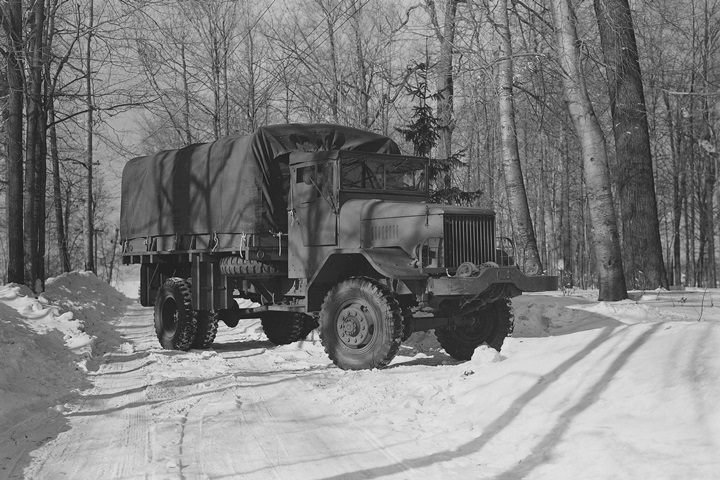
This HAR-1 is traversing the back roads of
Wisconsin during a road test. Interestingly enough, while the
HAR-1 was ordered by Army Ordnance for the Lend-Lease program and
British use, it was a left-hand drive vehicle. The later SU-COE
was a right-hand drive truck.
HAR-1 Walk Around:
The Four Wheel Drive Auto Company HAR-1
shown below is owned by the Wheels of Liberation in Gettysburg, PA.
I was able to photograph it with the engine cowling and cab removed
after it came back from bead blasting. The HAR-1 was purchased in
the sand color shown in the first three photos. The Wheels of
Liberation decided to repaint the truck in the original olive-drab paint
scheme. This is the only known HAR-1 in the United States.
Between early 1943 and mid-July 1944, the
Clintonville plant produced 7,000 HAR-1s for Lend-Lease. This is
an average monthly run rate of 378.
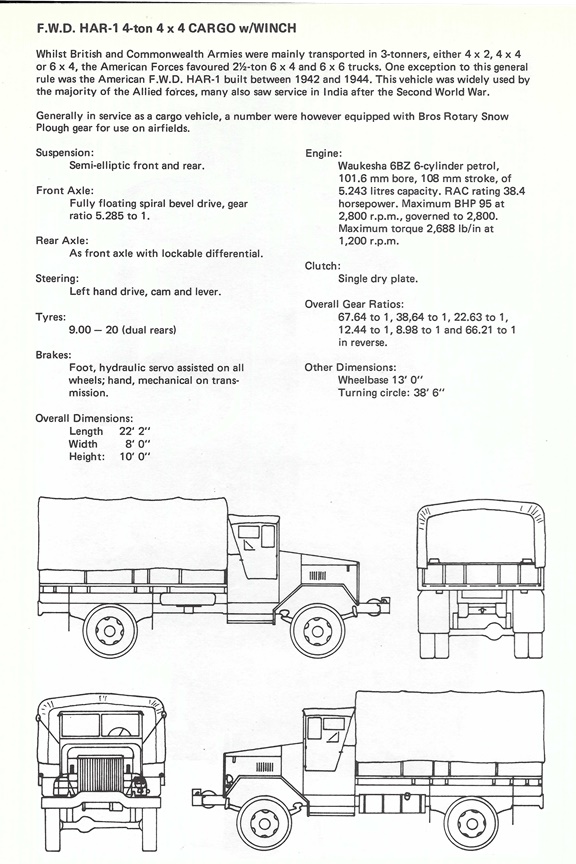
This HAR-1 specification sheet has been
added 1-13-2024 courtesy of Tim Wright.
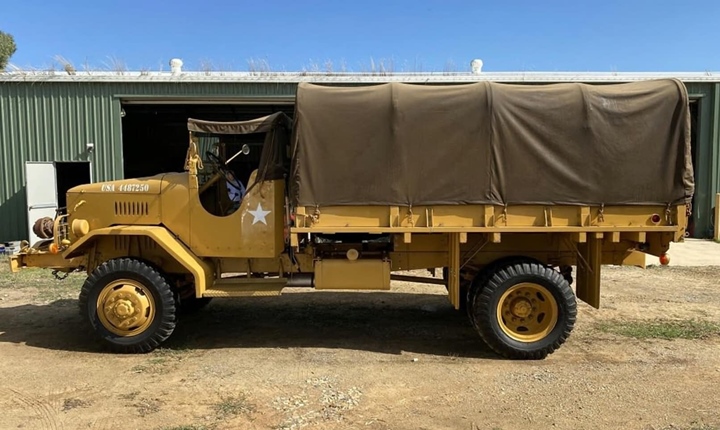
The majority of the trucks were provided to
the United Kingdom for its use. Note the fuel tank on the vehicle.
In the photos below, it has been removed for cleaning and repainting.
Photo courtesy of Jeff Lakaszcyck.
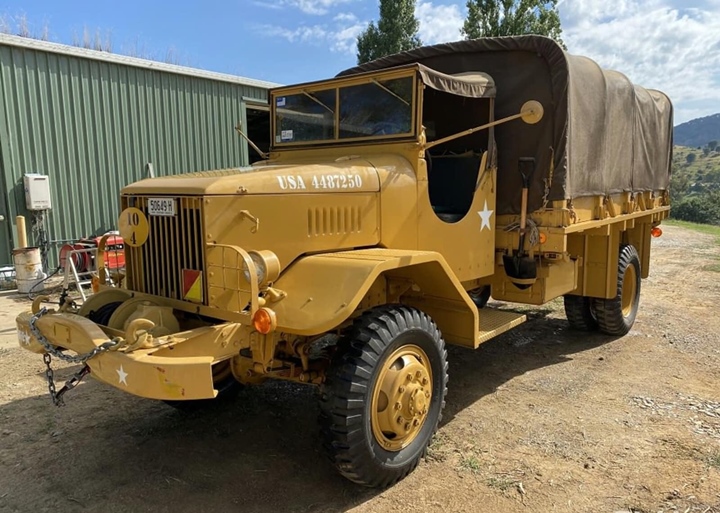
In the photos below, the cab, hood, engine
cowling, fenders, bumper, and winch have all been removed for bead
blasting and repainting. The FWD HAR-1 has the classic lines of an
American World War Two truck. It is a very nice looking vehicle.
Photo courtesy of Jeff Lakaszcyck.
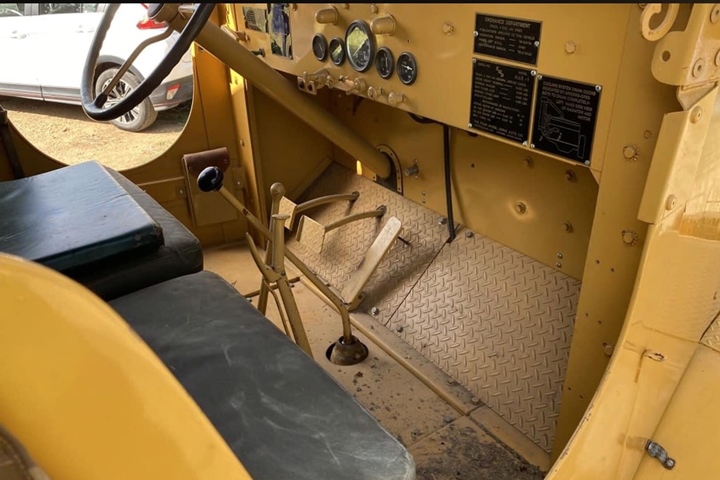
In the photos below, the interior of the
truck has also been removed. Photo courtesy of Jeff Lakaszcyck.
FWD made several of the components for the
FWD including the axles and frame. However, like other truck
manufacturers, it relied on outside suppliers to furnish many of the
components for the FWD. Below is the supplier listing for this
vehicle.
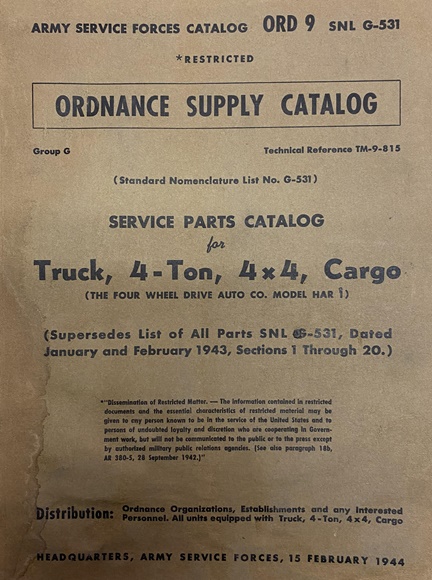
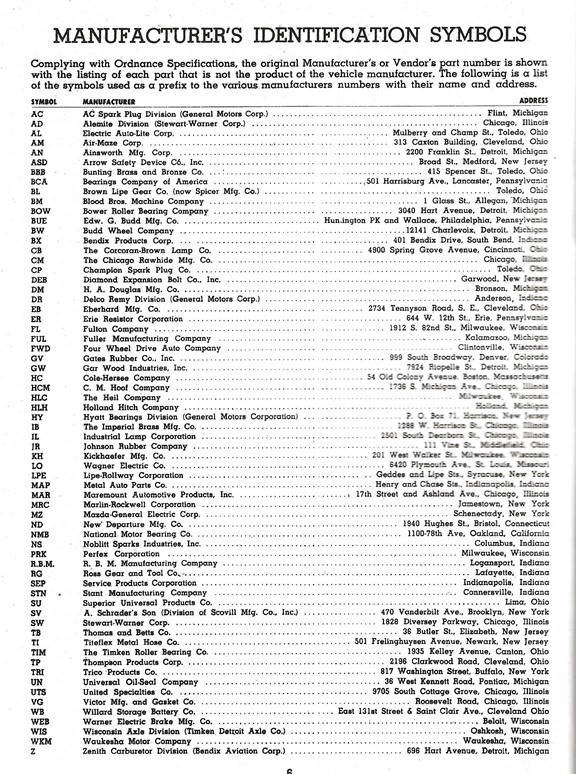
Many of the same companies on this list were
suppliers for the other American truck manufacturers of World War Two.
Some of the companies are still in existence today, while many have gone
by the wayside over the past 80 years. Some of the component
manufacturers will be identified in the photos below.
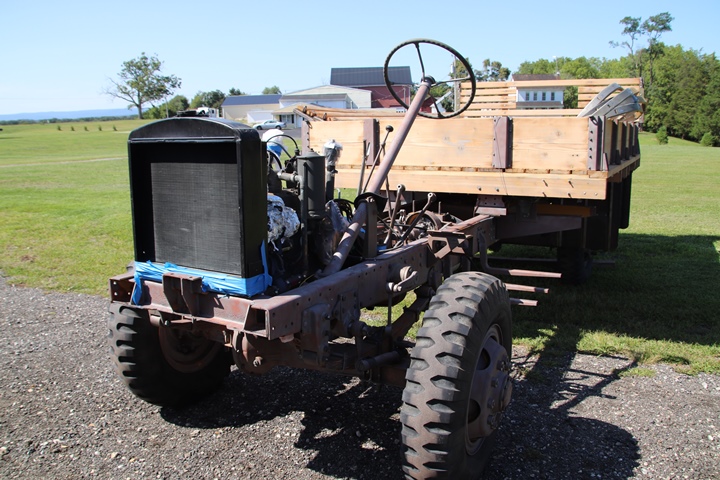
The walk around will begin at the
driver's side front corner. This allows us to start by viewing
first hand Otto Zachow's and William Besserdich's original patent that made
four-wheel -drive a useful technology. Author's photo.
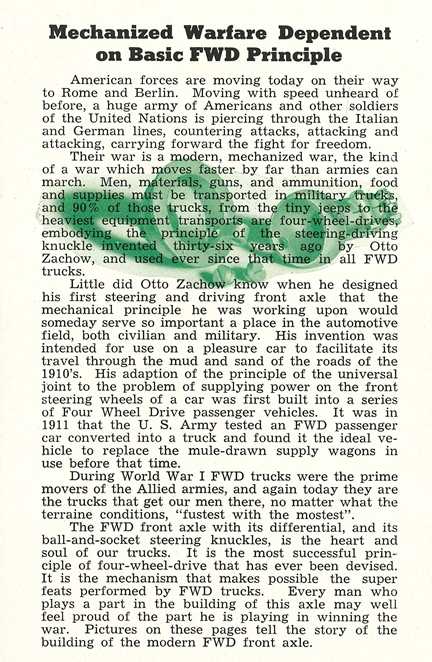
This article is from the volume 2, issue 2
of the FWD's World War Two employee newsletter. It explains the
importance of the concept for the existence of the company. What
it does not say is that after World War One, the company sold the patents
to the U.S. Army which allowed its competitors to have the same
technology. Photo courtesy of the Tim Wright Collection.
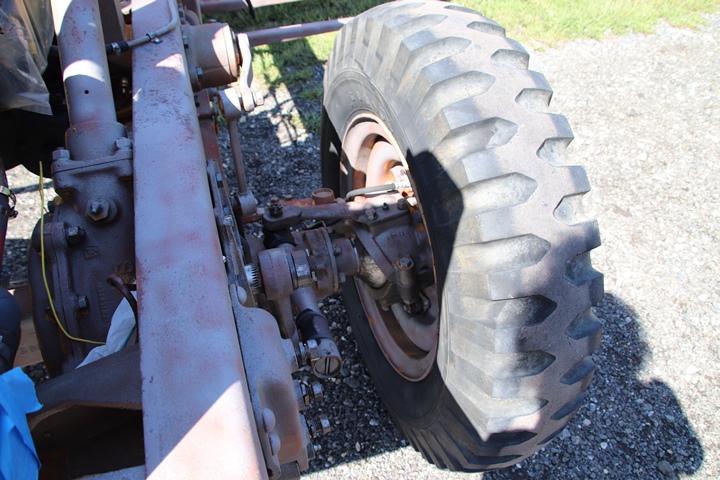
At the intersection of the driveshaft
and the front wheel is the ball and socket noted in the above article.
Author's photo.

Within the ball and socket is the double Y
joint that Otto Zachow and William Besserdich invented. The
complete text of the patent is on the
Otto Zachow and William Besserdich Patents
page. Author's photo.
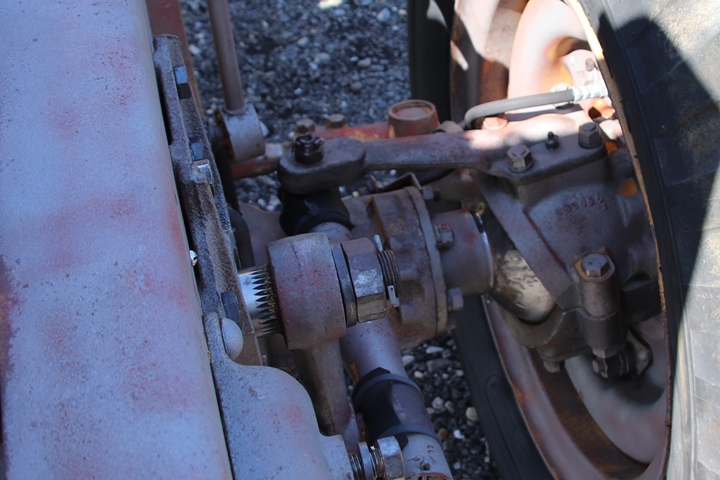
This view is a close-up photo of the
ball and socket assembly. Author's photo.
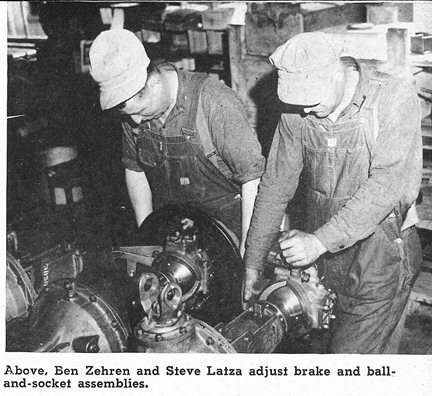
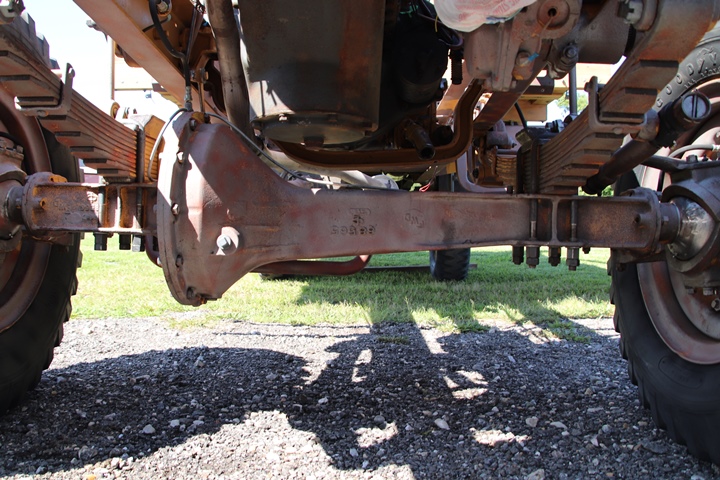
The upside down "FWD" can be seen on the
front axle. At the right of the photo is the ball-and-socket
assembly. On the left is the front differential noted in the
newsletter above. Author's photo
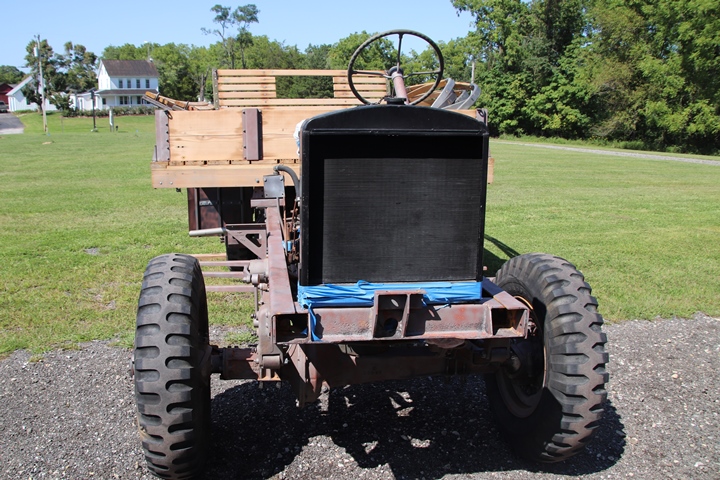
The chassis still had blue masking tape on
it after returning from the bead blaster. The radiator was
supplied by Perfex Corporation of Milwaukee, WI. Author's photo.
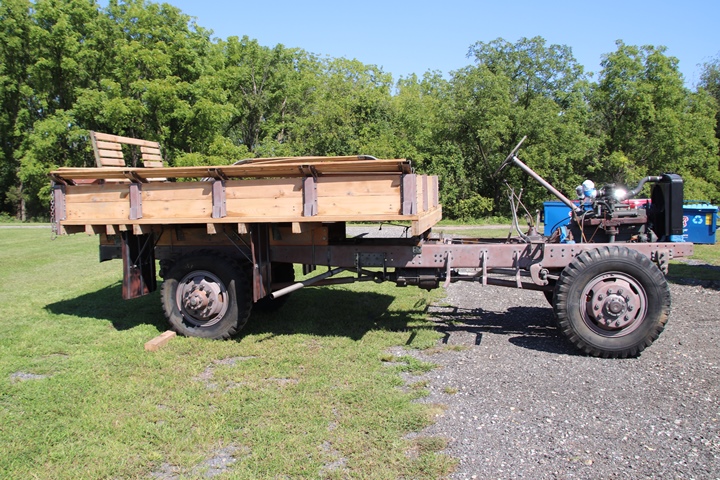
Note that even the wood body was bead
blasted to remove the sand-colored paint. Author's photo.
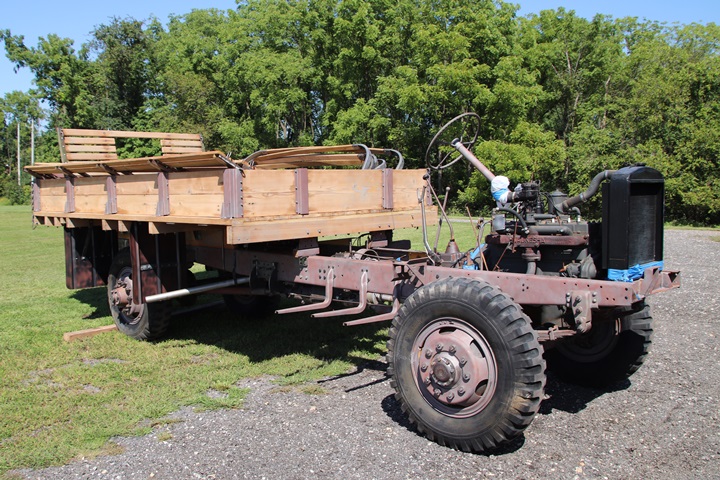
Budd Wheel Company of Detroit, MI, furnished
the wheels for this and most of the heavy duty trucks built during World
War Two. Author's photo.
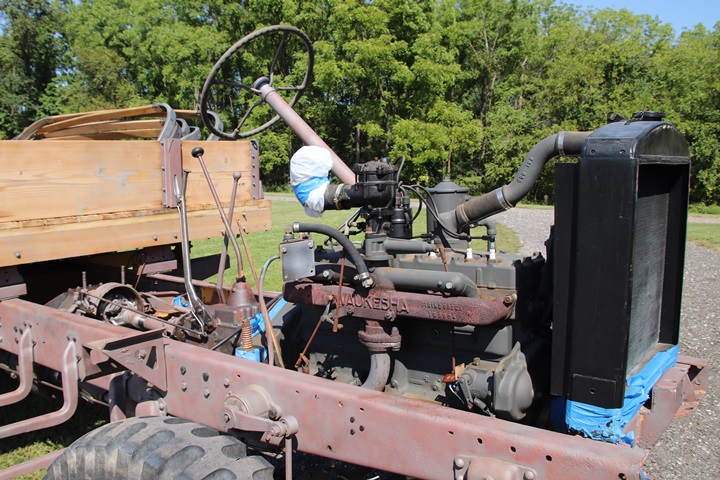
The power plant for the 7,000 HAR-1s was the
Waukesha Motor Company's Model 6BZ 6-cylinder gasoline engine
that produced 95 HP at 2800 rpms. Waukesha Motor Company was
located in Waukesha, WI. Author's photo.
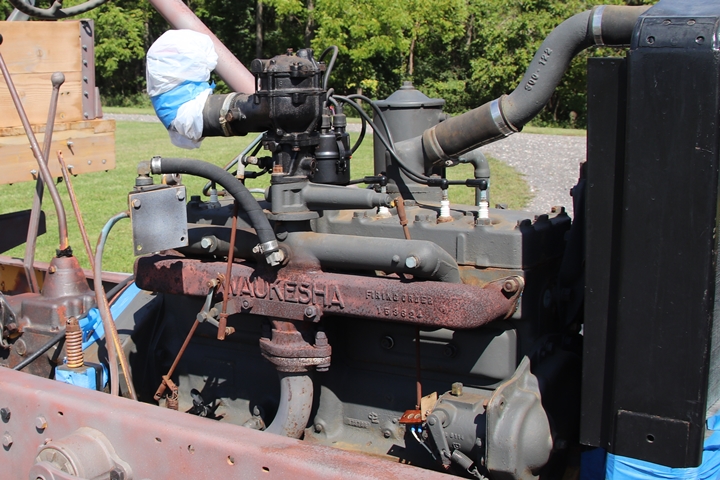
The engine came equipped with a carburetor
from the Zenith Carburetor Division of Bendix Aviation. The
generator, starter, regulator, distributor, and coil were all furnished
by Auto-Lite of Toledo, OH. Author's photo.
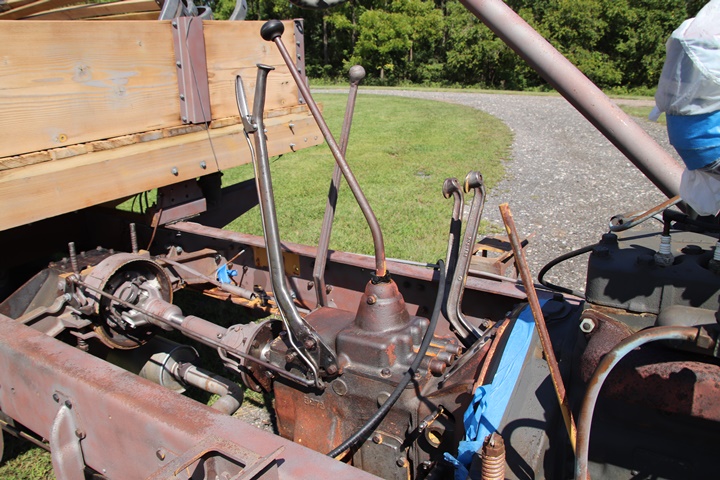
Fuller Manufacturing of Kalamazoo, MI was
the supplier of the 5B-33-SP five-speed transmission and the hand brake
system. This includes the brake lever, brake release spoon,
connecting rod, and the hand brake assembly. Author's photo.
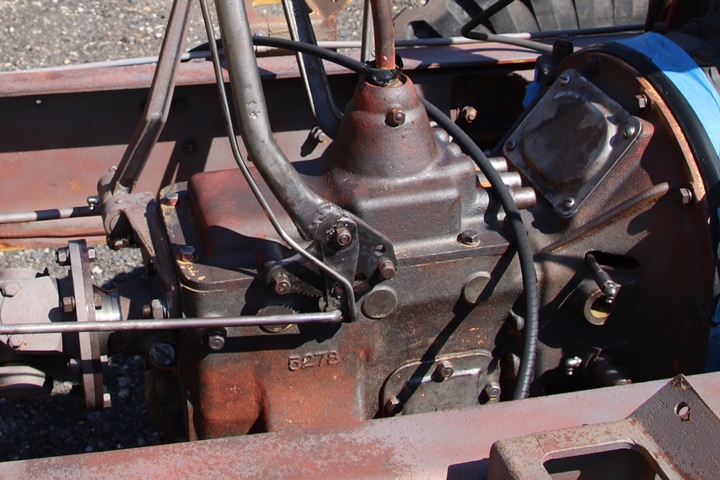
The Fuller transmission is shown in this
close-up photo along with the hand brake lever pivot mechanism.
Author's photo.
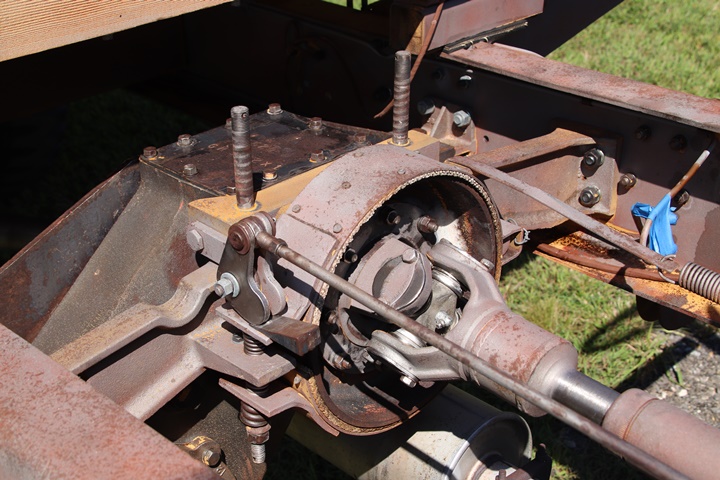
The drum and brake lining are shown in this
image. The two studs are for securing the cab of the truck.
Author's photo.
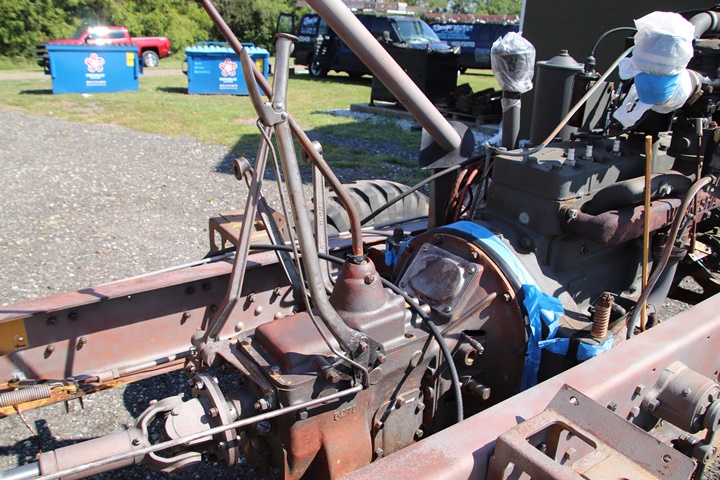
Author's photo.
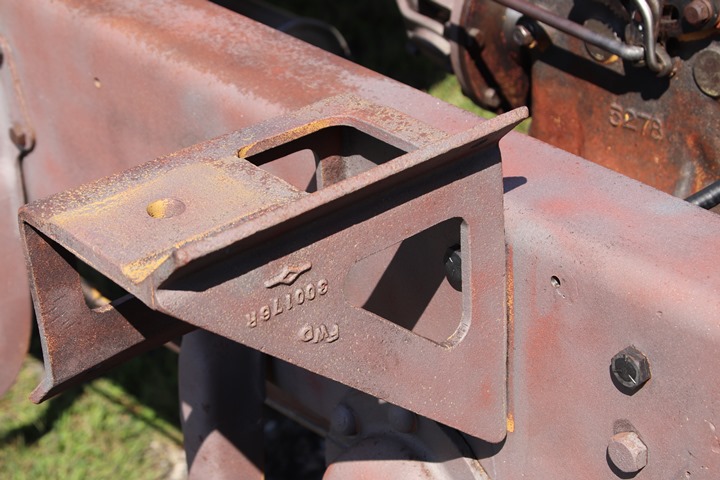
This FWD-made bracket was used to mount and
secure the cab to the frame. Author's photo.
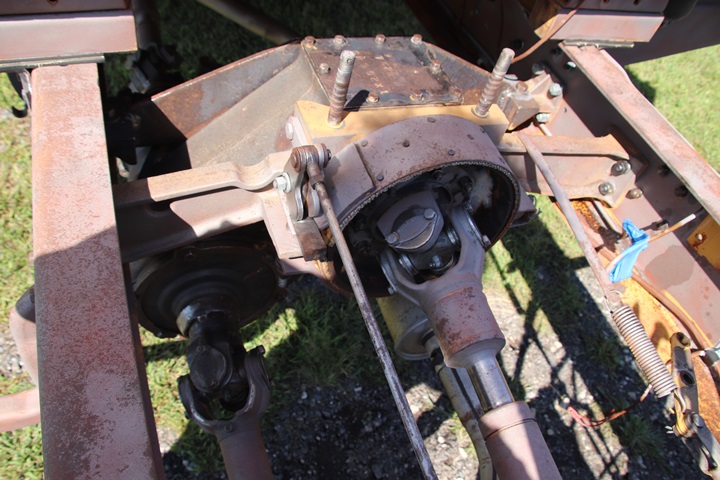
Behind the hand brake is the transfer case.
The front wheel drive propeller shaft is in the lower left of the photo.
This appears to have been built by FWD. Author's photo.
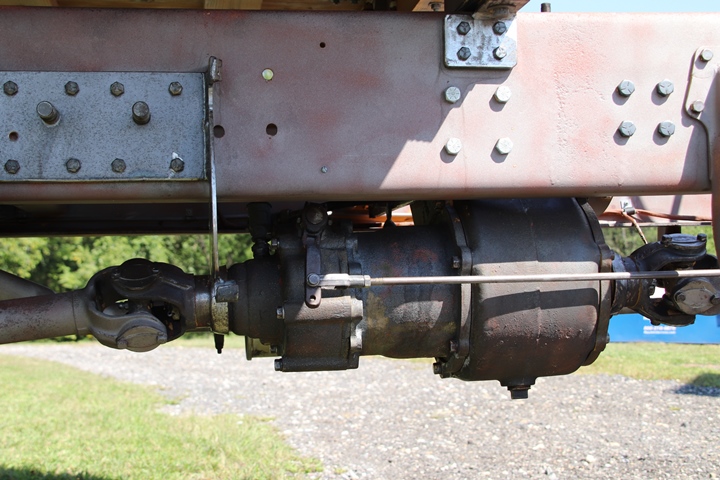
This side view of the transfer case shows
both the front and rear propeller shafts. Otto Zachow and William Besserdich
had a second patent, Patent No.
907,940 for a "Power Applying Mechanism." This was for their
version of the transfer case which applied power to both the front and
rear axles. The Otto Zachow and William Besserdich transfer case
was a gear driven unit. The transfer case shown here is a chain
driven unit, indicating that FWD had moved on to a more advanced and
common technology for the transfer of power to both front and rear
axles. Also, there was no mention of the transfer case in the
newsletter article above. The complete text of the patent is on the
Otto Zachow and William Besserdich Patents
page. Author's photo.
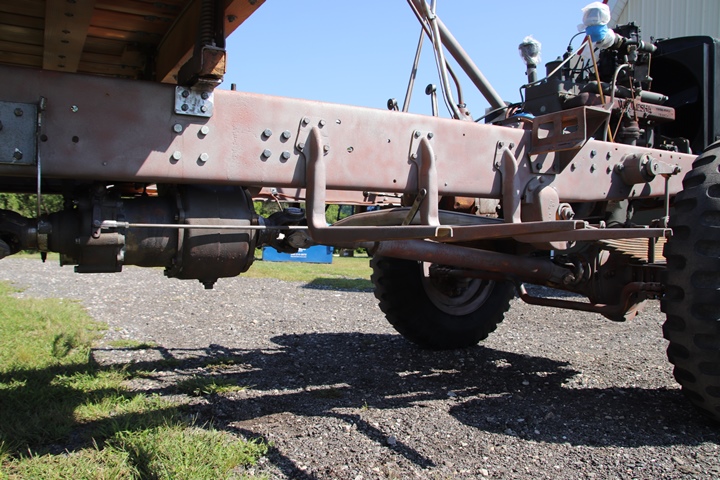
Author's photo.
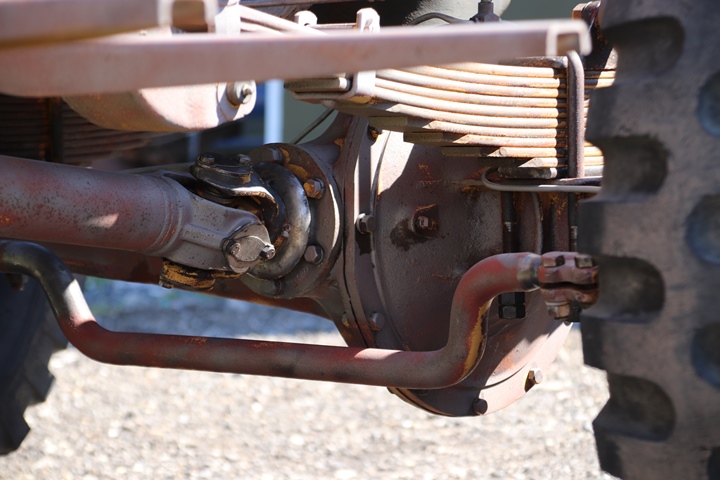
The front differential on this truck has its
roots in the origin of the company and the original 1908 Patent No.
882,986 by Otto Zachow and William Besserdich. Author's photo.
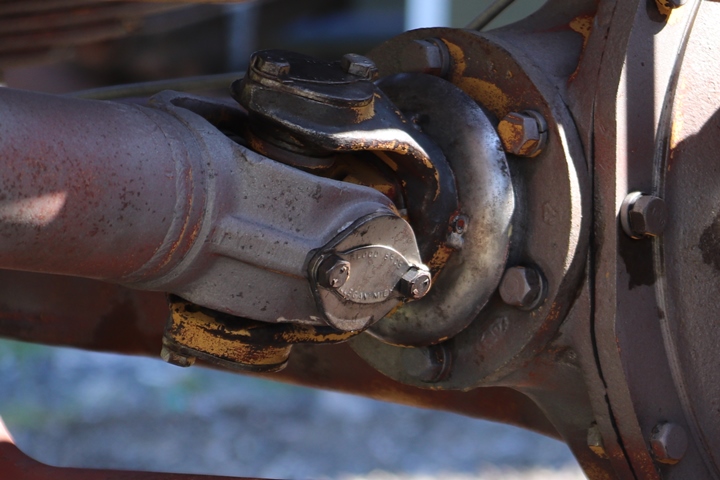
The information on the universal joint says it was made by the Blood
Brothers Machine Company of Allegan, MI, which is a company name I had
not seen before. At the turn of the 20th Century, the Blood
Brothers began making bicycles in Kalamazoo, MI. In 1914, the
brothers purchased a factory in Allegan, MI, and began making race cars
with their own unique chain drive. The Cornelian race car
was driven by Louis Chevrolet in the 1915 Indianapolis 500. Mr.
Chevrolet had to drop out due to engine valve failure but did place 20th
in the event. Further investigation indicates the Blood Brothers
supplied universal joints for about half of the different truck models
used in World War Two. But I digress. All of the universal
joints on the HAR-1 were provided by the Blood Brothers. Author's
photo.
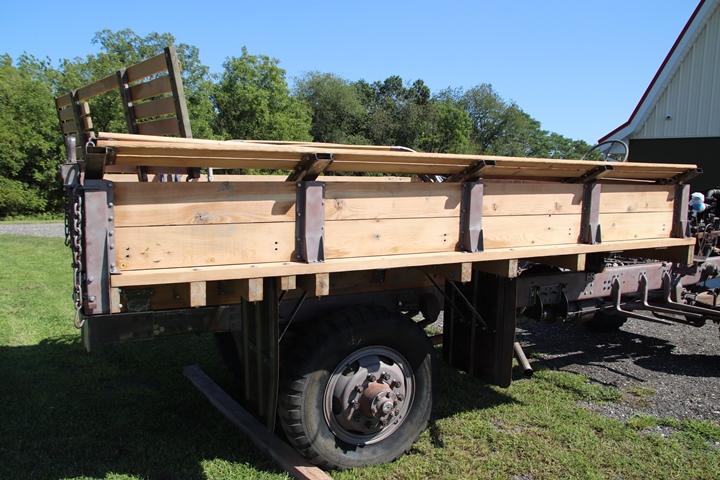
The wood portions of the bed appear to have
been made by FWD as there is no other supplier given. However, all
of the steel parts on the bed were supplied by the Edward G. Budd
Manufacturing Company of Philadelphia, PA. Author's photo.
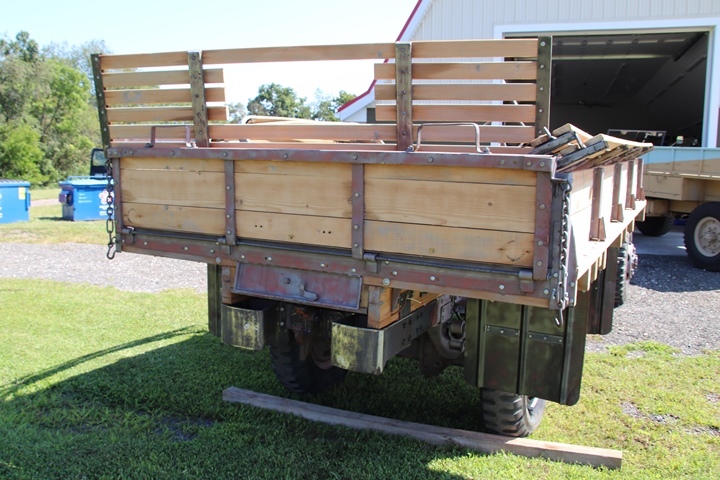
There is a steel step on the tailgate to
assist soldiers in getting into the bed of the vehicle. Author's
photo.
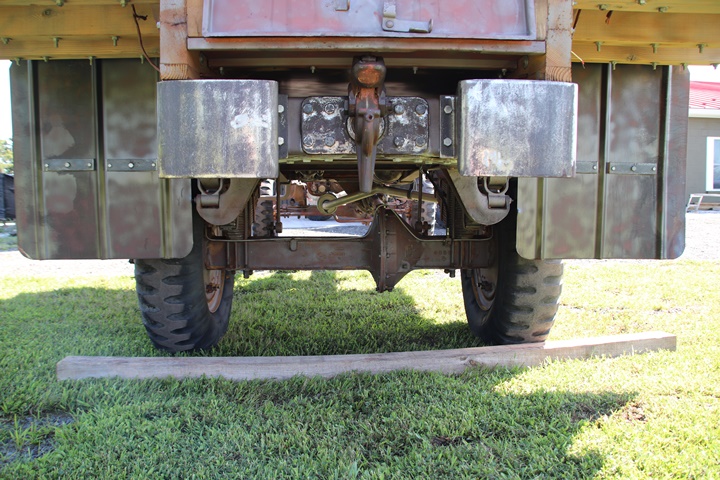
The Holland Hitch Company of Holland, MI
provided the pintle hook. The bumperettes and the mud flaps appear
to have been manufactured by FWD. Author's photo.
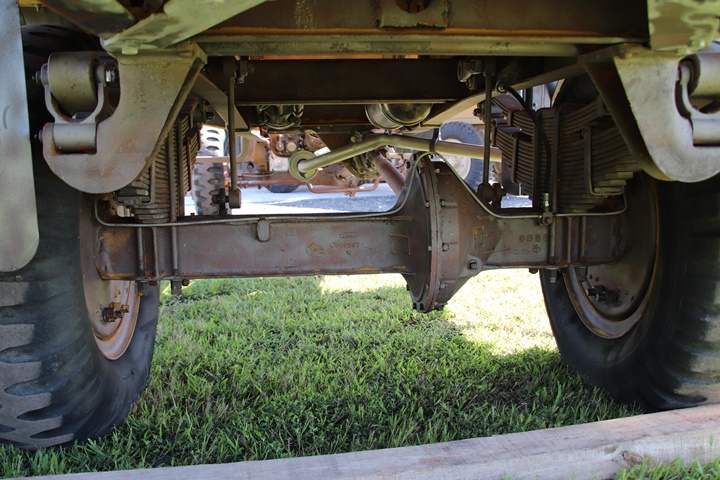
The rear axle was built by FWD.
Author's photo.
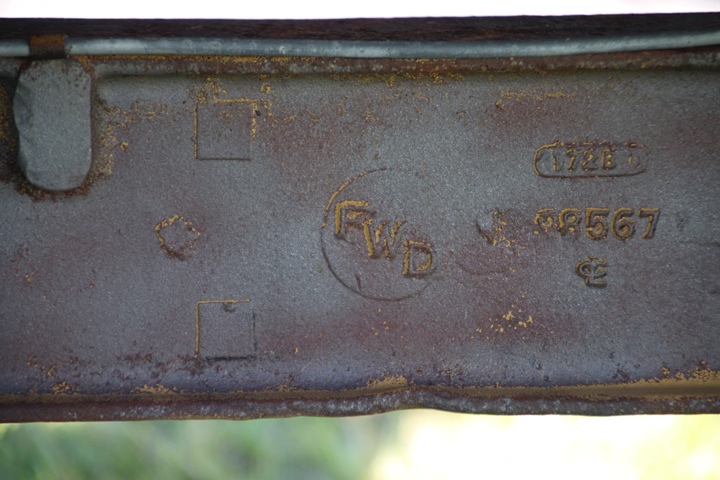
Author's photo.
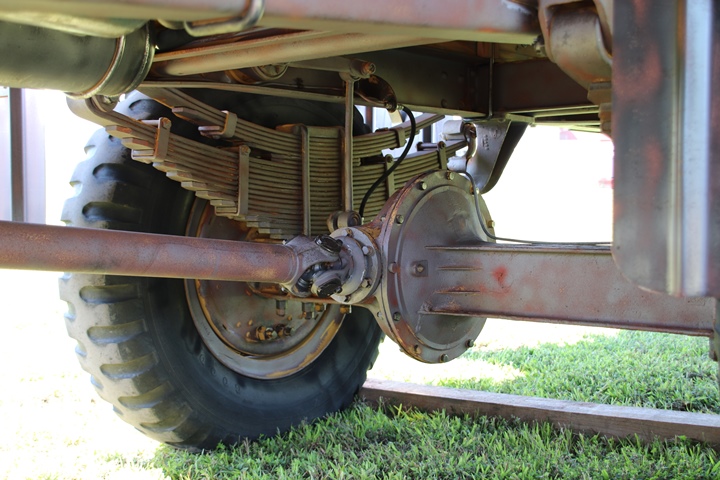
The rear axle, differential, and springs
were all manufactured by FWD. The rear and front brakes were
supplied by the Wagner Electric Company of St. Louis, MO. The
drums and hubs were provided by the Kickhaefer Manufacturing Company of
Milwaukee, WI. Author's photo.
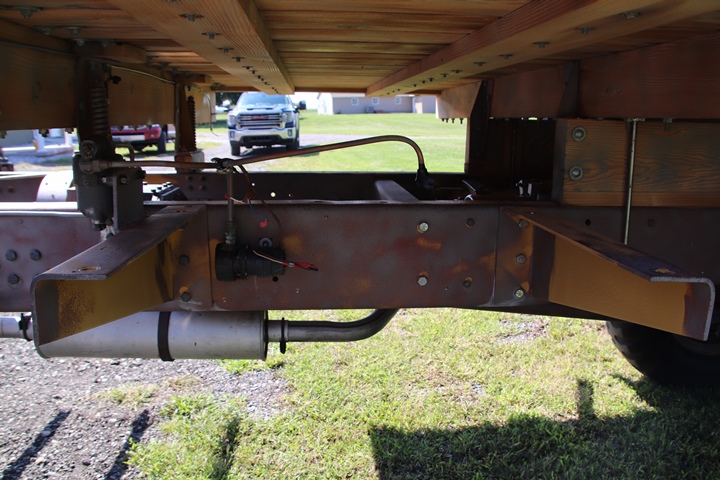
This image shows some of the construction of
the bottom of the body and how it was mounted to the frame. The
Maremount Automotive Products Company of Chicago, IL supplied the
muffler for the FWD HAR-1. The two brackets are used for mounting the fuel
tank. Author's photo.
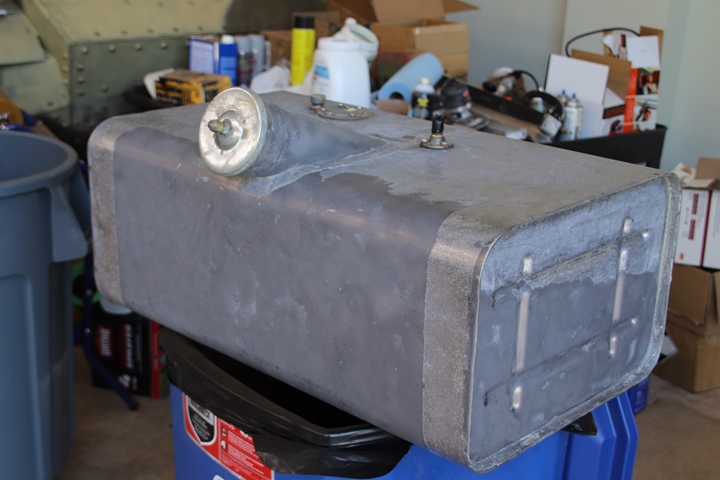
The 40 gallon fuel tank was out of the truck
for cleaning and painting. The cap was supplied by Stant
Manufacturing of Connersville, IN. Author's photo.
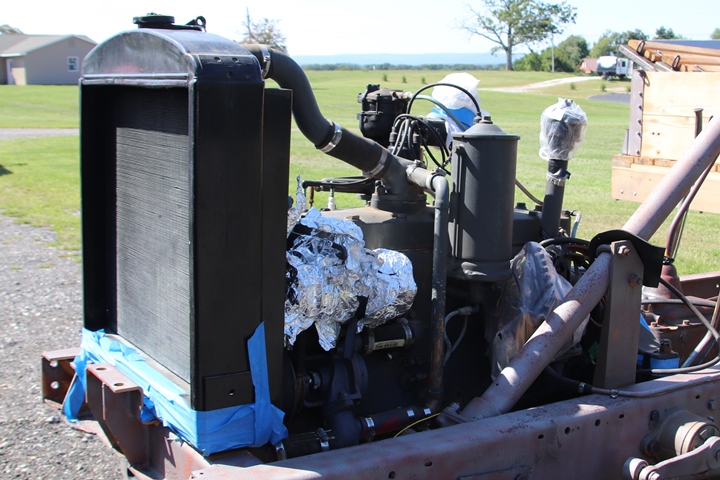
This brings us around to the front of the
vehicle. The front axle, differential, and driveshaft were all
produced by FWD. The steering wheel, tube, and steering gear
components came from Ross Gear in Lafayette, IN. Author's photo.
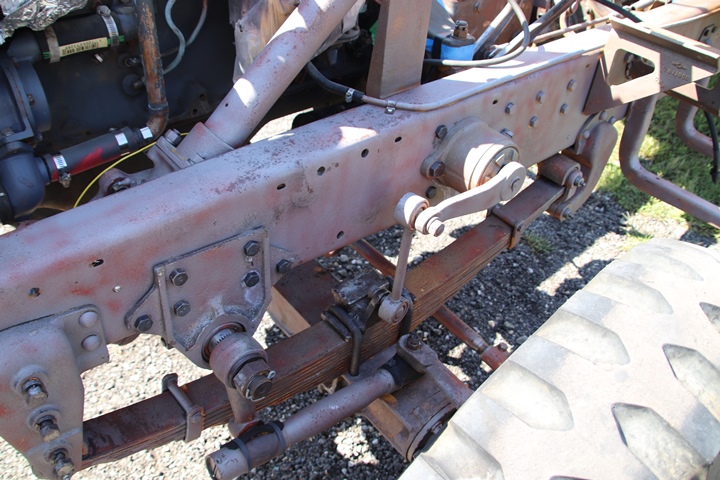
The manufacturer of the shock absorber that
is mounted to the frame and the middle of the front spring assembly is a
mystery. It has a manufacturer's code of HH in the parts manual.
As can be seen in the list of manufacturers at the top of this
section, there is no HH code. The steering drag links and tie rods
were furnished by the Thompson Products Corporation of Cleveland,
OH. Author's photo.
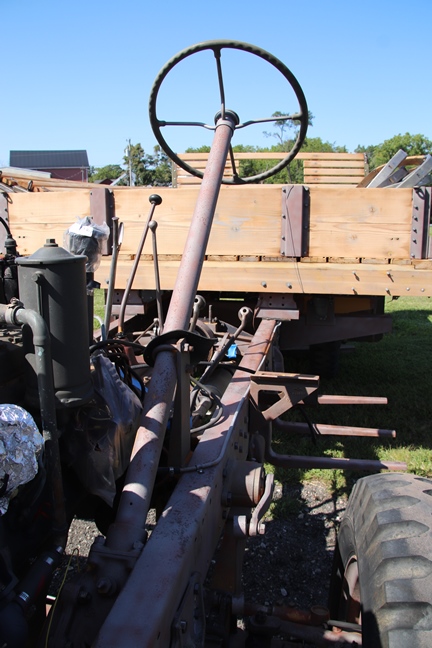
The steering assembly was manufactured by
Ross Gear. It includes the steering wheel, tube, and the steering
gear. Author's photo.
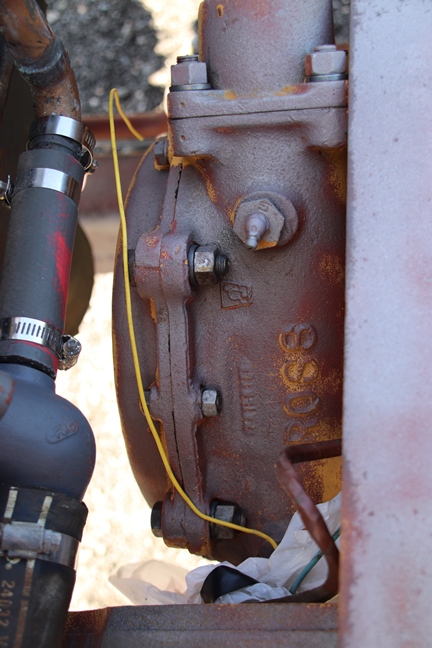
The name "Ross" can be seen on the
steering gear. Author's photo.
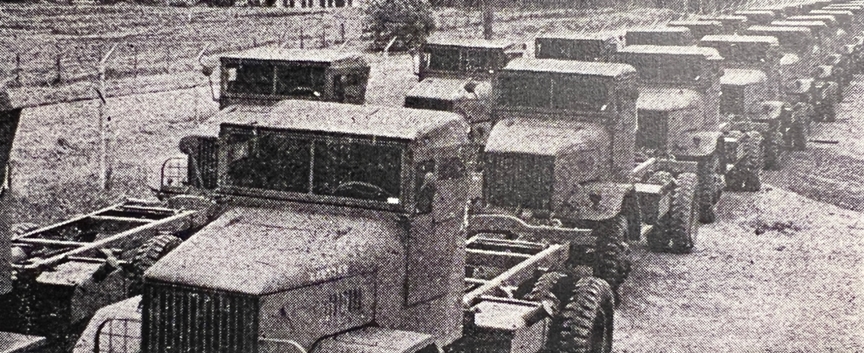
This photo was taken in mid-July 1944. Production stopped at
7,000, which fulfilled U.S. Army Ordnance contract number 171-2675.
These units are sitting outside of the Clintonville, WI plant waiting on
missing parts before being shipped. One of the obvious absences is
the body. It is unknown whether these were installed at
Clintonville or by a sub-contractor at another location. Photo
courtesy of the Tim Wright Collection.
With the completion of the
HAR-1 contract, FWD could focus on the production of 960 SU-COE cargo
trucks and 2,700 SU-COE prime movers for Lend-Lease.
Other Surviving FWD HAR-1
Trucks:
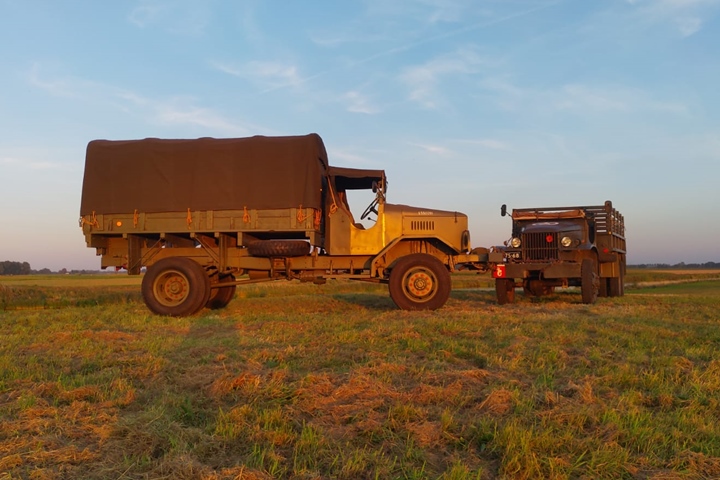
The FWD HAR-1 shown above is the proud
possession of Mr. Hein Klop of the Netherlands. Mr. Klop has been
able to fully restore the truck to its original configuration.
Image courtesy of Mr. Klop added 1-13-2024.
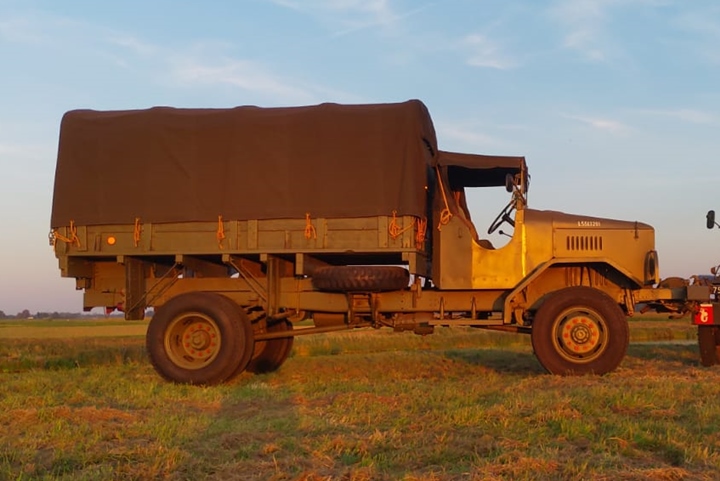
Image courtesy of Mr. Klop added 1-13-2024.
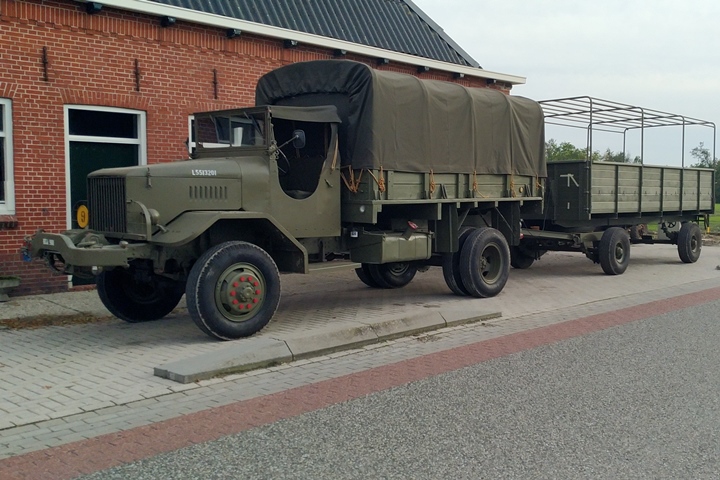
Image courtesy of Mr. Klop added 1-13-2024.
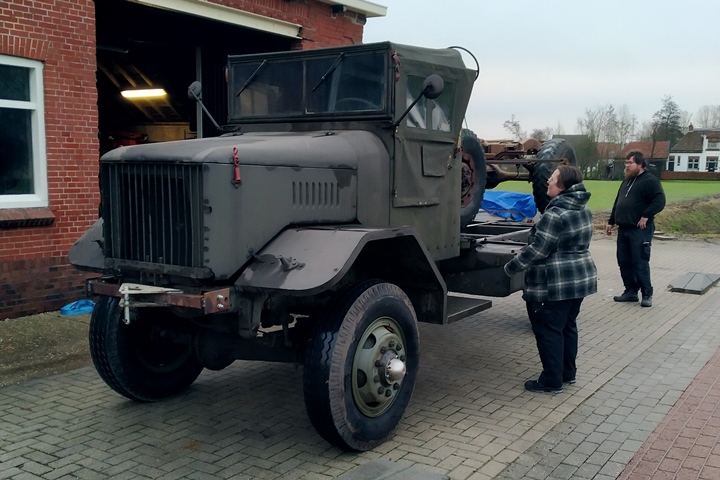
Mr. Klop also has this HAR-1 in his
collection. Mr. Klop is currently searching for the missing parts
of this vehicle to also make it a complete restoration. Image
courtesy of Mr. Klop added 1-13-2024.
U.S. Navy Trucks:
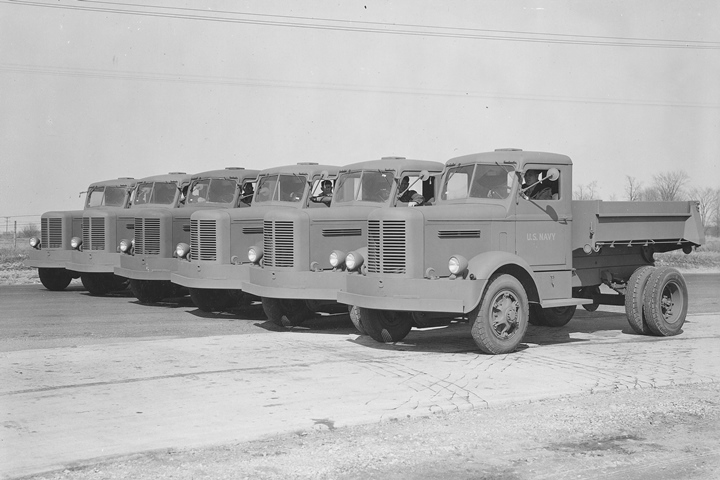
These six trucks are destined for the U.S.
Navy. The information with the photo indicates these were for the
U.S. Navy Seabee Construction Battalions of World War Two. If so,
the manufacture of these would have been after March 5, 1942, when the
Seabees were created. The trucks appear to be FWD commercial
trucks furnished to the Navy. Table 1 indicates that there were no
major contracts for these trucks. However, if the order was only
for the six units shown here, the value of the contract would have been
less than $50,000 and therefore not recorded in Table 1. Photo courtesy of
the Tim Wright Collection.
This appears to have been
a one-time order. During World War Two, the U.S. Navy Seabees used
GMC CCKW cargo dump trucks in its construction of facilities.
SU-COE Trucks:
The SU-COE was produced in two basic different versions during World War
Two. The first version of 250 went to the USMC and were built in
both Clintonville and Stevens Point, WI. After these were
completed at Stevens Point and production HAR-1 production ended in
Clintonville, the company began producing a right-hand drive version
under U.S. Army contracts for British Lend-Lease. In 1944 and 1945,
the company produced 1,460 SU-COE cargo versions and 2,700 prime movers.
The SU-COE also had a
number of limited production and experimental designs. It was the
truck chassis that FWD used to promote other military uses during World
War Two.
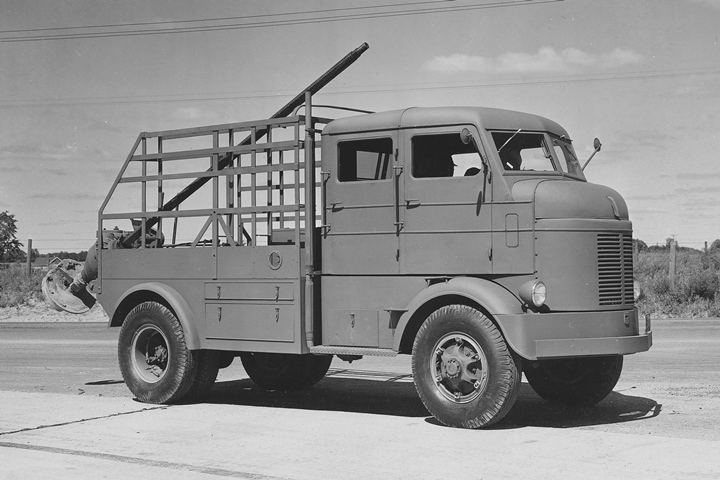
This extended cab truck is described as
being an FWD line unit with earth borer for the U.S. Engineers.
This appears to be a prototype of what might have been a very small
production run for the Army engineers early in the war. The engine
has been moved forward from that of an SU-COE, which seems to be more of a
cab forward design than a COE. Photo courtesy of the Tim Wright
Collection.
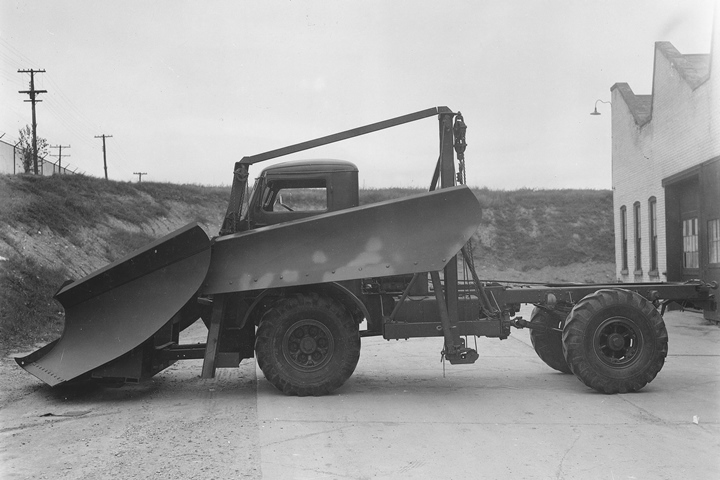
This photo is described as a snow removal
unit, which has been mounted to an SU-COE chassis. Photo courtesy
of the Tim Wright Collection.
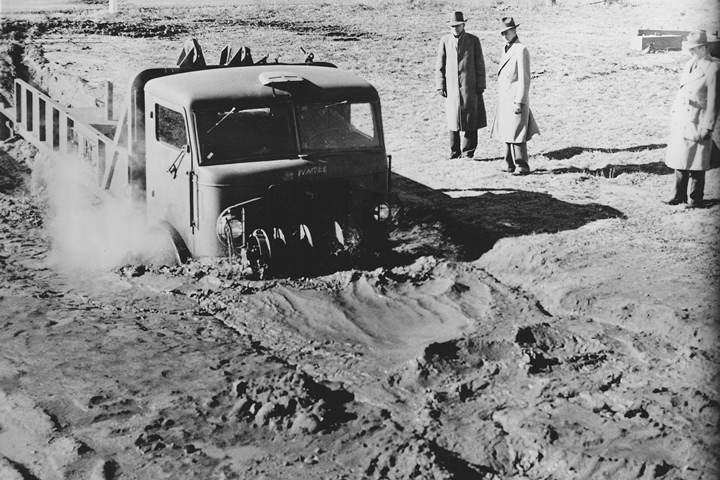
This image shows an Army engineer SU-COE
being tested in the FWD proving ground mud hole. Photo courtesy of
the Tim Wright Collection.
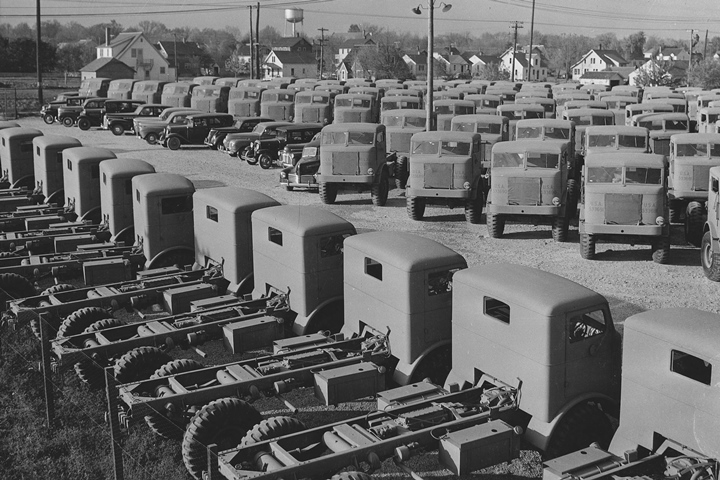
How cool is this? There are at least
73 FWD-built SU-COE cargo trucks awaiting shipment. All still need
to have the cargo body installed. There are five trucks with
identifiable USA registration numbers. They are 533681, 533689,
533690, 533691, and 533695. The vehicles are destined for the
United Kingdom as they are right-hand drive. Photo courtesy
of the Tim Wright Collection.
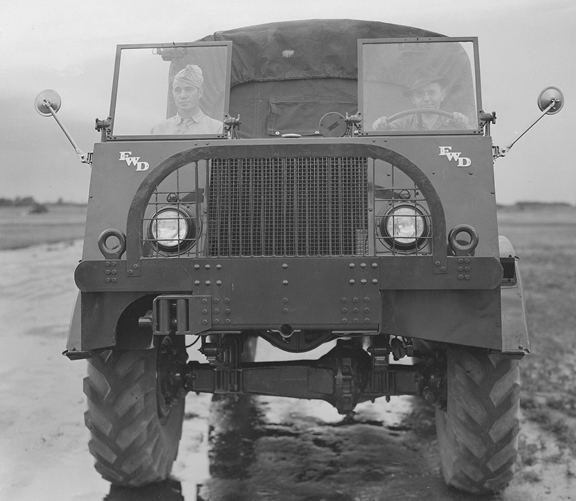
This photo is of a USMC SU-COE undergoing a
test demonstration drive. Photo courtesy of the Tim Wright
Collection.
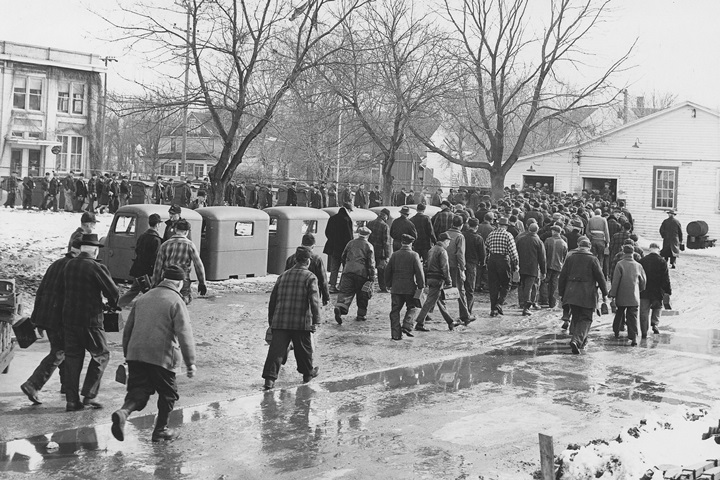
This appears to be a slushy spring day at
the Clintonville plant during shift change. Of interest is that
the company had at least six SU-COE
cabs outside along the driveway. Photo courtesy of the Tim Wright
Collection.
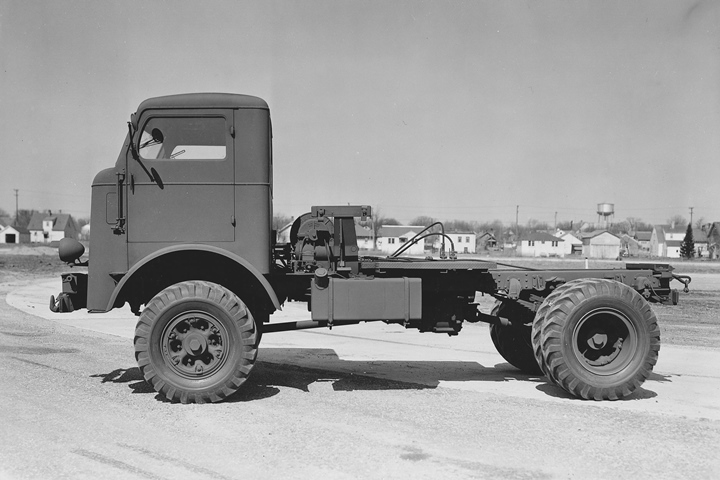
This and the next photo may or may not be the
same SU-COE, as they were taken at different times of the year.
Both appear to be the right hand drive Lend-Lease version. This
one is described as a cargo transport tractor. Photo courtesy of the Tim
Wright Collection.
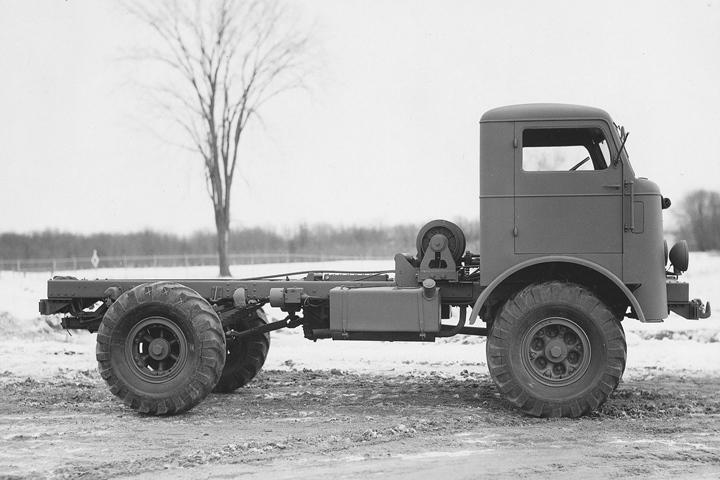
This one is described as a medium artillery
tractor. Both of these trucks are different than the ones shown
sitting in the yard at Clintonville, as these two have a winch. The
others don't. Photo courtesy of the Tim Wright Collection.
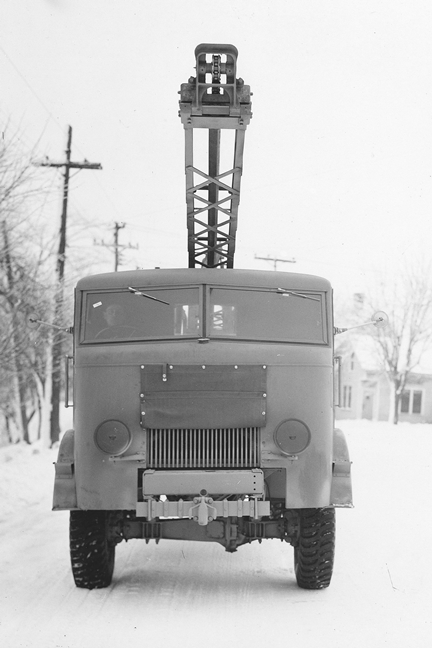
This Wisconsin winter photo shows what was
described as a bomb recovery unit. There was a reference or two in
1942 FWD company newsletters that FWD bomb removal trucks were in use in
England. Note that this is a right-hand drive truck with the
headlights covered over and no blackout light. As the photo below
shows, Lend-Lease SU-COEs did not have headlights and only one blackout
light. Photo courtesy of the Tim Wright Collection.
The vehicle above may have
been a prototype of a very limited production run. I have not been
able to find a corresponding contract for bomb removal trucks. If
there was a limited number of these built for the British and the
contract was less than $50,000, it would not have shown up in the Major
Contract listing.
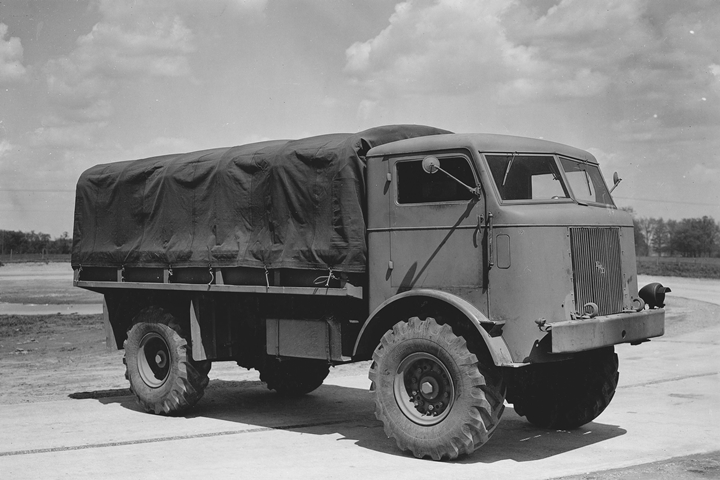
Photo courtesy of the Tim Wright Collection.
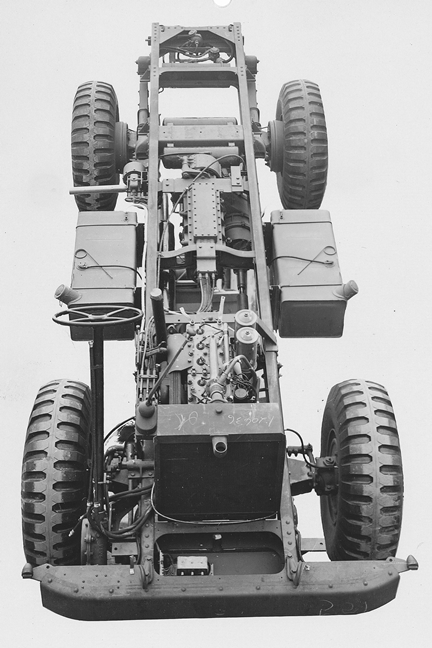
This photo of the SU-COE shows the truck had
two fuel tanks and the front wheel drive propeller shaft and differential are on
the opposite side of the driver. Photo courtesy of the Tim Wright
Collection.
Anatomy of the FWD SU-COE: For
the FWD HAR-1, I was able to do walk around of a vehicle under
restoration. For the SU-COE, there are currently no vehicles
available to do this with. This is a very rare vehicle in the
United States. Therefore, I will use the SU-COE Operation and
Maintenance Manual, TM-10-1377 to provide information about this
vehicle.
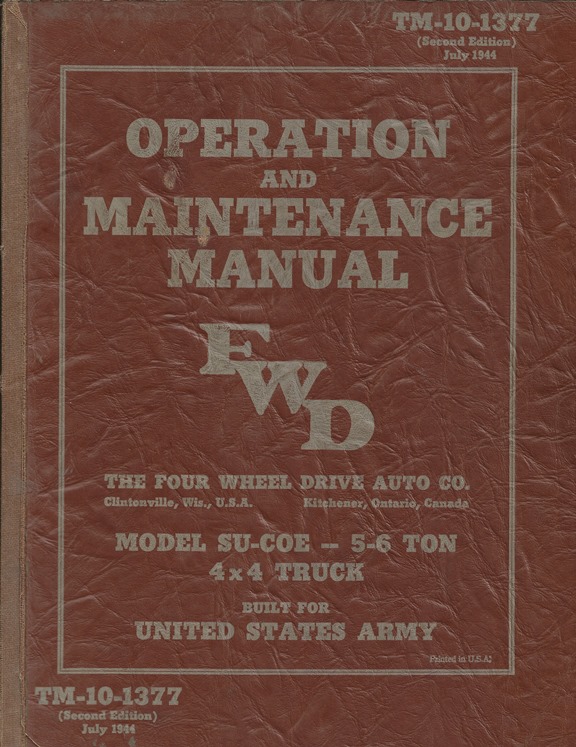
There is a considerable amount of
information in this manual that cannot be found anywhere else. The
FWD SU-COE is one the most obscure, if not THE most obscure World War
Two truck built by an American truck company. The section below
will hopefully shed more light on this rare vehicle. Image added
1-13-2024.
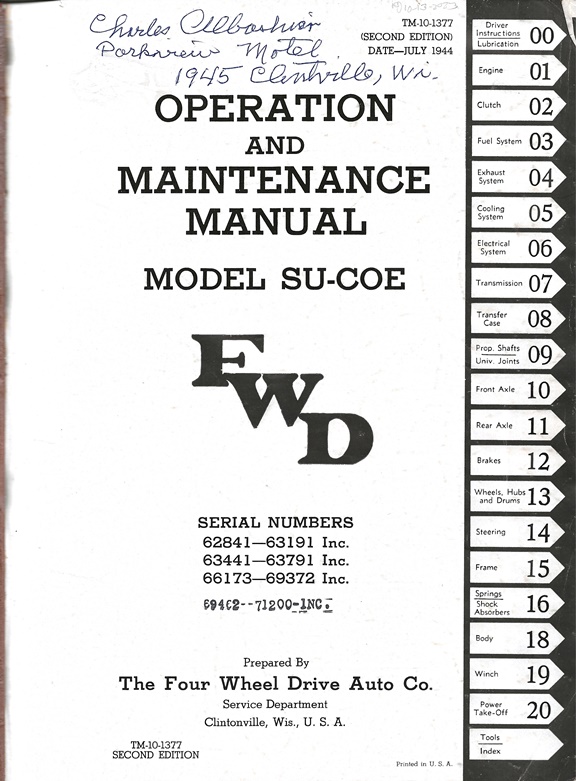
This second addition of this manual has a
rubber stamped "69462--71200-INC." on this page. Normally, these
numbers are found penciled in on other manuals Ihave seen. This
gives me further confidence that this series of trucks was actually
produced. Image added 1-13-2024.
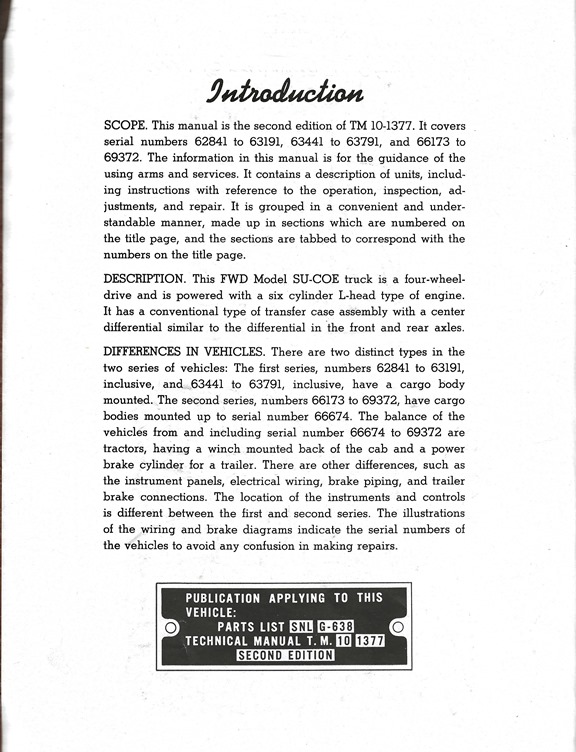
Image added 1-13-2024.
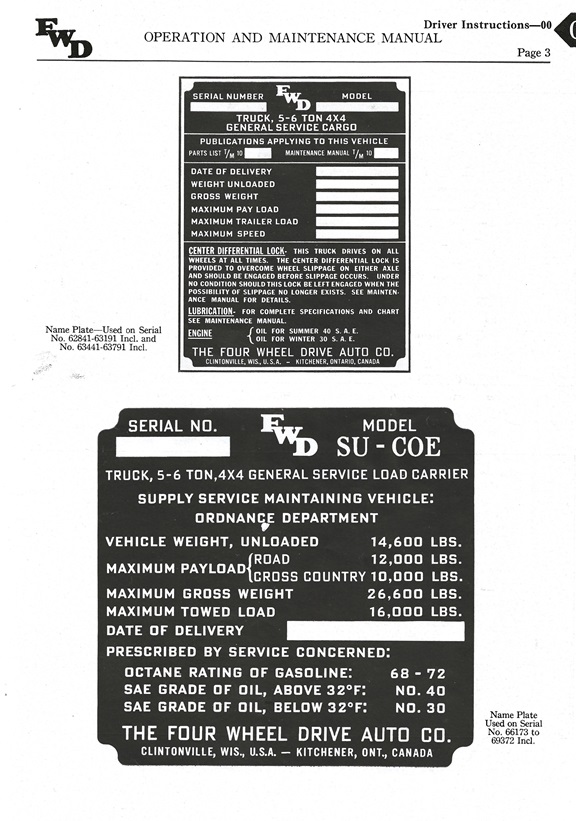
There were two different data plates for the
SU-COE series, depending on the serial numbers. Image added
1-13-2024.
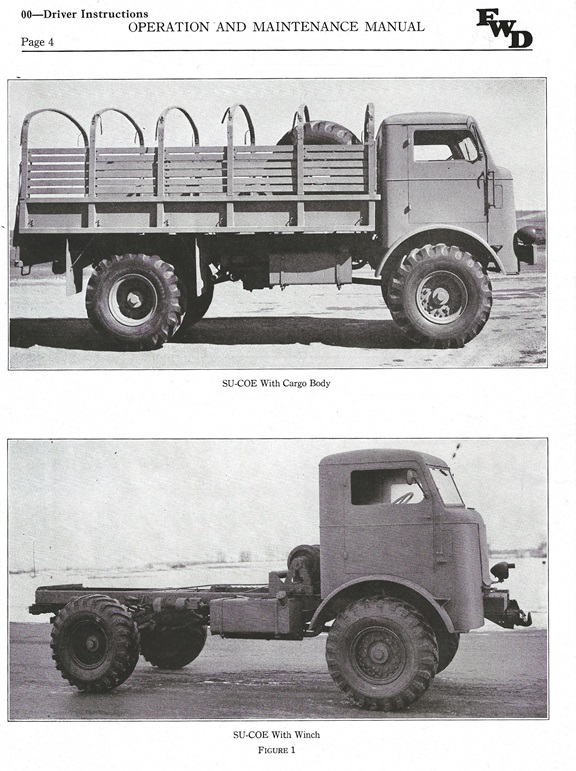
Image added 1-13-2024.
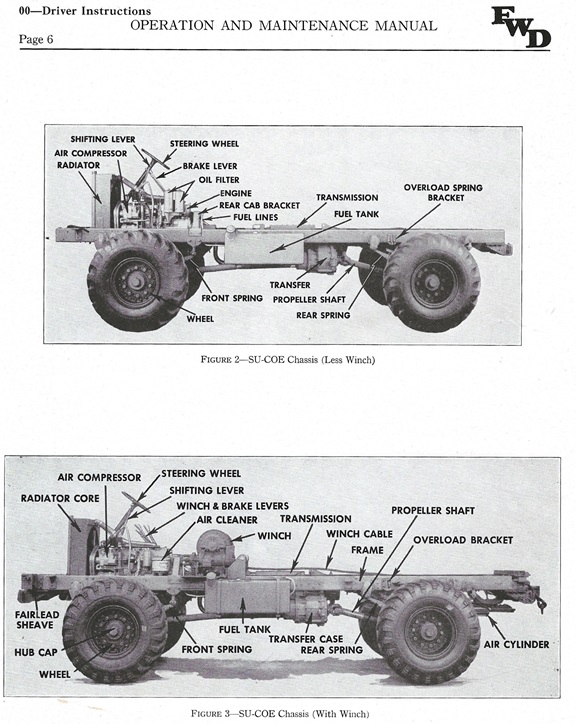
Image added 1-13-2024.
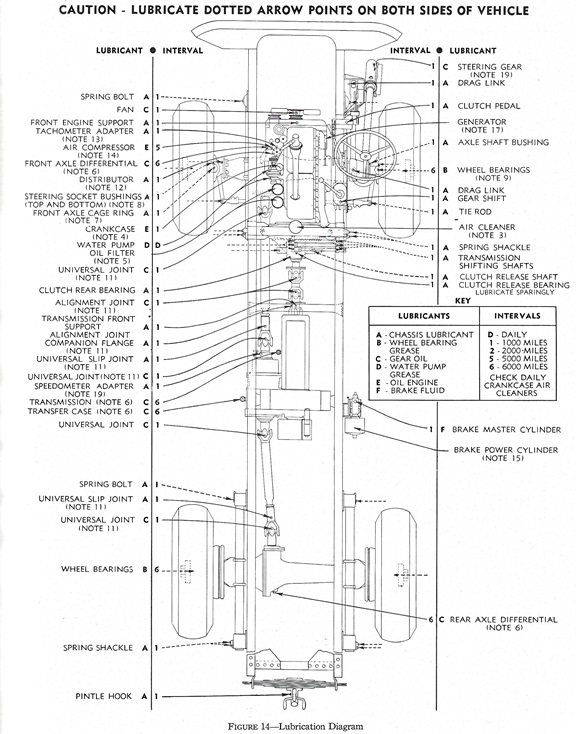
Lubrication diagrams are a good way to show
the drive train components on a vehicle. They also show how far
the technology has come in the past 80 years. Currently,
most, if not all components like those shown here are self-lubricating.
Image added 1-13-2024.
Table 13 below shows all of the different
manufacturers that contributed to the manufacture of the SU-COE during
World War Two.
|
Table 13 -
FWD SU-COE Components - Table added 1-13-2024. |
|
Component |
Manufacturer |
Model |
Other Information |
|
Engine |
Waukesha |
SPKR |
Six
cylinder, 126 h.p. |
|
Clutch |
Brown-Lipe |
Single Plate |
14 inch |
|
Carburetor |
Zenith |
4257-2" |
|
|
Fuel Pump |
AC |
Mechanical |
|
|
Fuel Filter |
AC |
|
|
|
Fuel Tanks |
FWD |
|
Two 40 gallon tanks |
|
Muffler |
Maysteel |
|
39 inch length, 6 inch diameter |
|
Radiator |
Pertex |
|
Tubular |
|
Electrical |
|
|
|
|
Generator |
Auto-Lite |
GEH-5002-2 |
12 volt, 27 amps, positive ground |
|
Regulator |
Auto-Lite |
VRG-4102B |
Positive ground |
|
Starting Motor |
Auto-Lite |
MAS-409 |
|
|
Distributor |
Delco-Remy |
640-C or 1110180 |
It is interesting that FWD used two different companies for
the electrical components, spliting them between Auto-Lite
and Delco-Remy. Normally, the generator, starter, and
ignition system is all supplied by one company. While
not noted in the manual, it is assumed the ignition coil was
furnished by Delco-Remy. |
|
Spark Plugs |
Champion |
Commercial 1 and J9 |
7/8 inch and 14mm |
|
Battery |
Willard |
Standard Duty |
153 amp-hour |
|
Horn |
Delco-Remy |
Twin Electric |
|
|
Head Lamps |
Corcoran-Brown |
|
|
|
Radio Interference Suppression |
TobeDeutschmann Corp. |
|
|
| |
|
|
|
|
Transmission |
FWD |
U |
Direct in 5th |
|
Transfer Case |
FWD |
"S" |
Chain drive |
|
Universal Joint - Front- Rear |
Blood Brothers |
6N |
Four joints |
|
Universal Joint - Alignment |
Blood Brothers |
5N |
Two joints |
|
Propeller Shafts - Front and Rear |
FWD |
|
3-1/4 inch diameter tube |
|
Front Axle |
FWD |
Two Piece |
Full floating, bevel drive |
|
Rear Axle |
FWD |
Two Piece |
Full floating, bevel drive |
|
Brake |
Lockheed Hydrulic |
|
Internal Expanding |
|
Trailer Power Cylinder |
Hanna |
|
|
|
Air Power Cylinder |
Wagner Electric Company |
A-357 an A-840 |
|
|
Air Compressor |
Wagner Electric Company |
D-Rotary |
Clockwise, Belt drive |
|
Electric Hand Control |
Wagner Electric Company |
|
|
|
Hydraulic Relay Valve |
Bendix |
|
|
|
Conversion Valve |
Bendix |
|
|
|
Parking Brake |
FWD |
|
|
|
Wheels |
Kelsey-Hayes |
Divided Disc |
20 x 10.00 |
|
Steering Gear |
Ross |
T-74 |
Twin-Lever Roller |
|
Frame |
Assumed to be FWD |
|
|
|
Springs-Front |
Assumed to be FWD |
14 Leaves |
|
|
Springs-Rear |
Assumed to be FWD |
16 Leaves |
|
|
Springs-Rear Auxiliary |
Assumed to be FWD |
7
Leaves |
|
|
Cab |
FWD |
COE |
66 inches long by 84 inches wide |
| |
|
|
|
|
Cab Components |
For SN 62841-63191, inclusive
and 63441-63791, Inclusive |
|
Instrument Panel |
Stewart Warner |
|
Ammeter, Oil Gauge, Speedometer, Heat Indicator, Fuel Gauge |
|
Lighting Switch |
Douglas |
|
|
|
Ignition Switch |
Douglas |
|
|
|
K.D. Switch |
K.D. Lamp Company |
|
|
|
Tilt-Ray Switch |
Douglas |
|
|
|
S.P.DT Switch |
Douglas |
|
|
|
Starter Switch |
Delco-Remy |
|
|
|
Trouble Lamp Socket |
Cole-Hersee Company |
|
|
|
Vacuum Gauge |
Bendix |
|
|
|
Air Pressure Gauge |
Bendix |
|
|
|
Hand Throttle |
Shakespeare Products |
|
|
|
Choke Assembly |
FWD |
|
|
|
Windshield Wiper |
Trico |
|
|
| |
|
|
|
|
Cab Components |
For SN 66674-69372, Inclusive
and
69462-72300, Inclusive |
|
Instrument Panel |
Stewart Warner |
|
Ammeter, Oil Gauge, Speedometer, Temperature Gauge, Fuel
Gauge |
|
Twin Horns |
Delco-Remy |
|
There is no listing for horns for the other set of serial
numbers. This may have been an oversight. |
|
Windshield Wiper |
Trico |
|
|
|
B.O. Head Lamps |
Corcoran-Brown |
|
|
|
Lighting Switch |
Douglas |
|
|
|
Ignition Switch |
Douglas-United Specialties |
|
|
|
K.D. Switch |
K.D. Lamp Company |
|
|
|
Tilt-Ray Switch |
Douglas-Delco Remy |
|
|
|
S.P.DT Switch |
Douglas-Sampson United Company |
|
|
|
Starter Switch |
Delco-Remy |
|
|
|
Trouble Lamp Socket |
Cole-Hersee Company |
|
|
| |
|
|
|
|
Body |
Galion and Stoughton |
Cargo |
Inside Length=186", Inside Width=88", Inside Height=59",
Sides=14" |
|
Winch |
Gar Wood |
4MB |
Back of Cab |
|
Power Take-Off |
Gar Wood |
74Y |
|
Engines and transmissions in World
War Two trucks are what are normally documented in publications on
the vehicles. However, underneath the trucks and sometimes
hiding in plain sight are other components of the vehicle that are
just as important as the engines and transmissions. But no one
really pays any attention to them. I have decided to feature
several of those below.
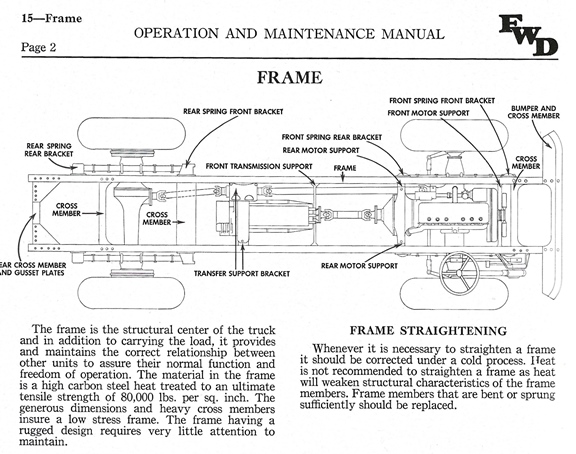
Every good truck starts with a solid frame.
However, it is hidden underneath the vehicle, and like the late Rodney
Dangerfield used to say, "Gets No Respect!" Without a well
designed and built frame, the truck will not be able to carry the load
that is required of it. It is the backbone of the truck.
This page not only denotes the type and strength of the steel used in
the frame, but also how it can be straightened, if necessary.
Image added 1-13-2024.
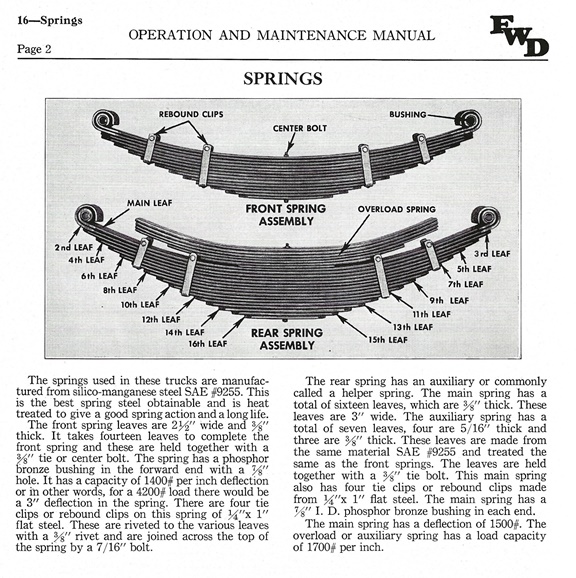
Springs are another hidden component
underneath the vehicle. Both the frame and the springs were
considered by the Four Wheel Drive Company to be important enough for
the company to manufacture them in-house. Image added 1-13-2024.
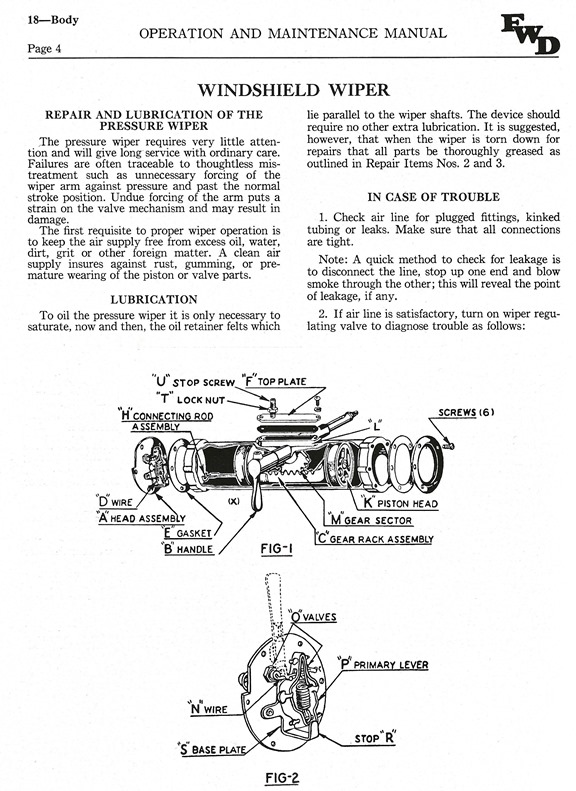
Hiding in plain sight is the windshield
wiper and motor assembly which is driven by air pressure or vacuum off
the engine and was mounted at the top of the windshield. Have you
ever been driving at night in a driving rainstorm and had your
windshield wiper motor go out? I have. It is not a pleasant
experience, to say the least. Military trucks have to run through
all sorts of inclement weather such as rain and snow at all times of the
day and night. A military truck's windshield wipers and motors
must be reliable for safe driving. FWD did not make its own
windshield wipers. Like all of the other World War Two truck
manufacturers, FWD purchased this important safety item from the Trico
Products Corporation of Buffalo, NY. Image added 1-13-2024.
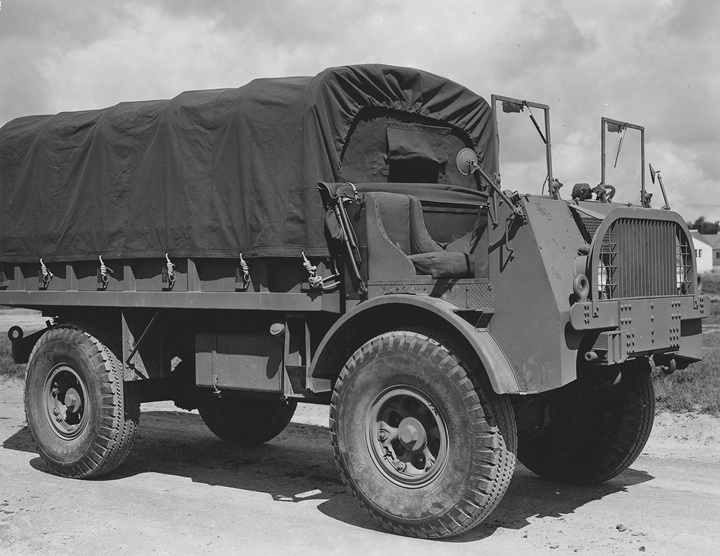
This photo shows that the SU-COE had two
wipers, with the wipers mounted to the inside of the windshield frame.
The driveshaft goes through the frame and actuates the wiper blade on
the outside of the windshield. Image added 1-13-2024.
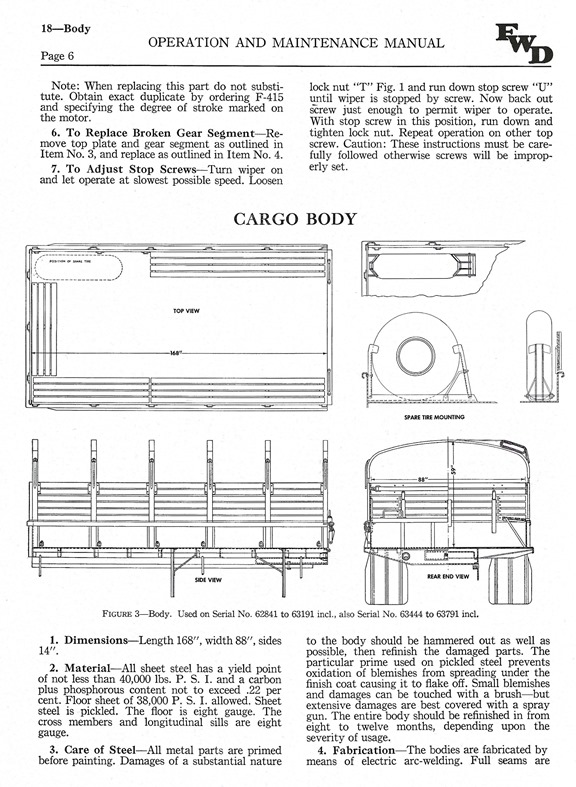
The cargo body also hides in plain sight and
is the reason the truck is built so that it can carry a useful load.
There are two different sets of drawings for the cargo body. This
one is for serial numbers 62841-63191 inclusive and 63441-6379 inclusive.
Image added 1-13-2024.
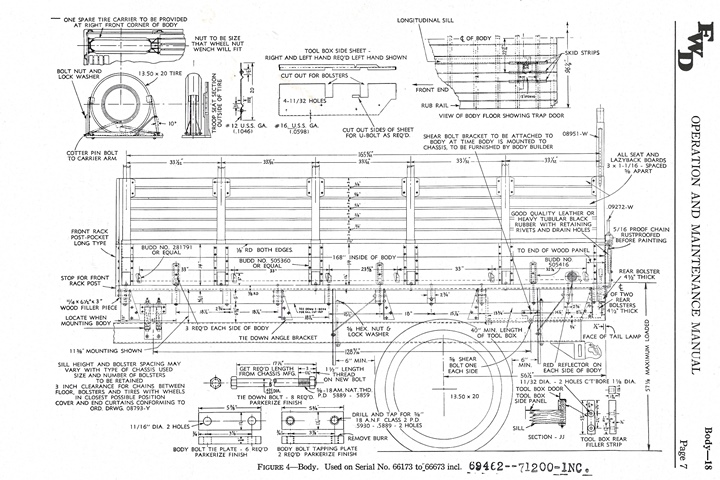
This one has two pages and is considerably
more detailed. It is for serial numbers 66674-69372 inclusive and
69462-72300 inclusive. Image added 1-13-2024.
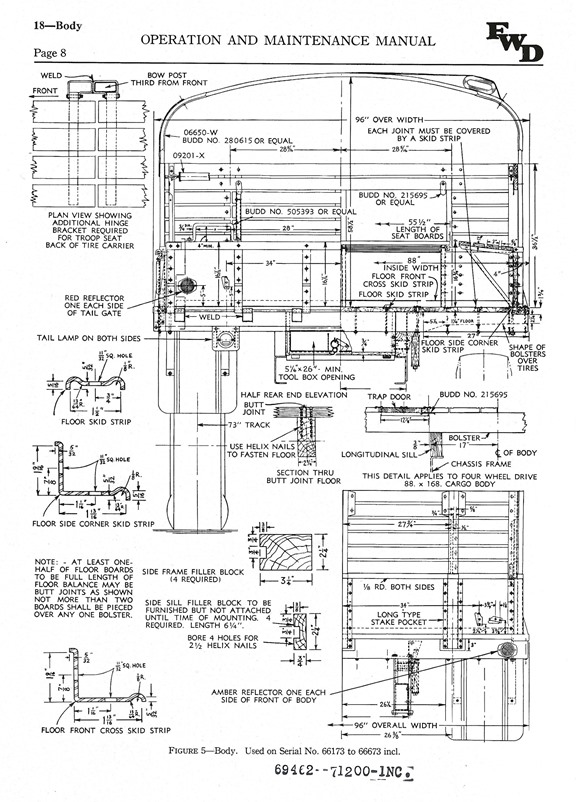
Image added 1-13-2024.
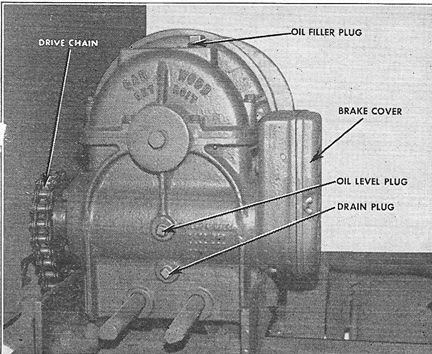
Also hiding in plain sight is the winch.
This image shows the exterior of the Gar Wood Model 4MB. The
outside view shows that the interior winch mechanism is encased in
several castings. Image added 1-13-2024.
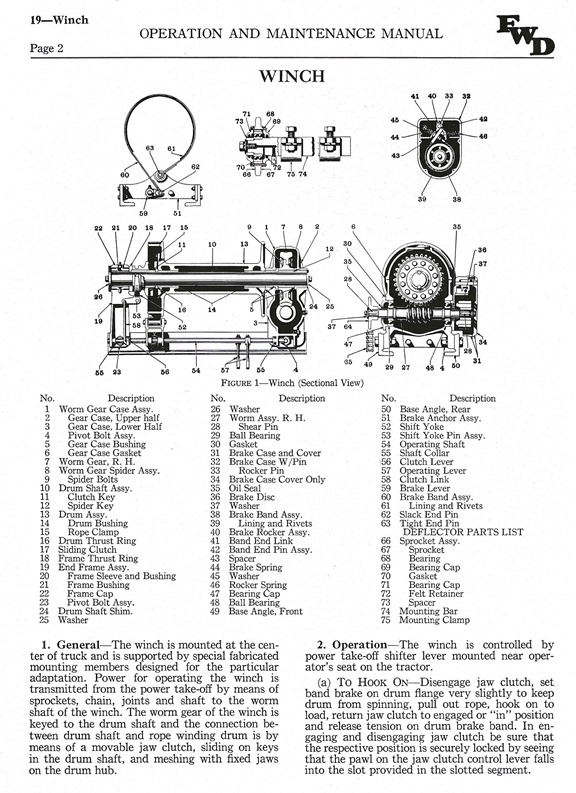
While the winch does not look complicated
from the outside, this interval view shows that the device consists of
75 different components. Image added 1-13-2024.
Diamond T Model 980 or 981, 12-ton,
6x4 M20 Trucks:
FWD produced under subcontract 100 Diamond T Model 980 tank
transporters. These are mentioned in early FWD 1942 newsletters
indicating work may have begun on them in 1941. Because they were
built under contract, any survivors built by FWD cannot be identified, as
they will have Diamond T data plates.
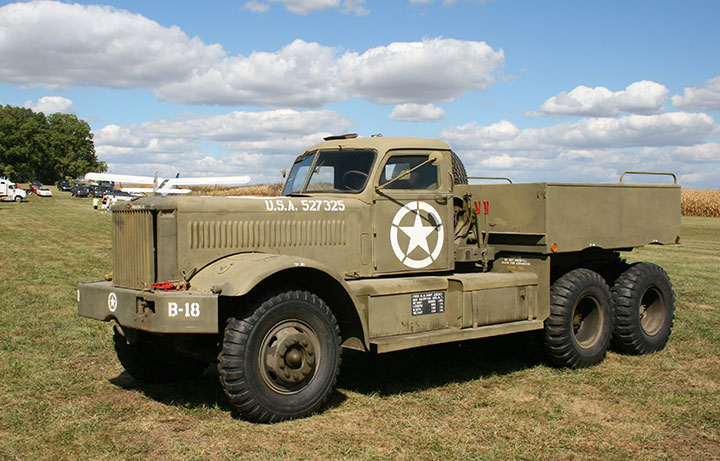
FWD produced 100 of the hardtop cab version
of Diamond T Model 980/981. There is a small chance this vehicle was actually built by FWD in Clintonville,
WI. Author's photo.
The Stevens Point, WI Plant:
The Clintonville FWD operation could not keep up with the orders it was
receiving and needed another facility to assemble trucks. Nearby
Stevens Point, WI had a new county highway garage that had enough space
for final assembly. Since the beginning of World War Two, Stevens
Point business leaders had been looking for a company that could come to
town to augment the several paper mills in the area. In late April
1943, Portage County Commissioners voted to allow FWD to utilize the
county highway department garage for the duration of the war.
Stevens Point provided $5,000 and the Chamber of Commerce provided
$2,500 to the county to relocate the county highway office workers to
another temporary location. This was all done as the plant needed
to hire 100 workers immediately and would eventually employ a projected
400 workers. FWD paid $7,200 per year to rent the building.
Production began in early May 1943.
My best friend for the past 30 years grew
up in Stevens Point, WI and is very familiar with much of the history of
the area. However, he was unaware that FWD had this plant in
Stevens Point during the war. Actually, many of the historians at
the FWD Museum in Clintonville, WI were unaware of this factory until
2016, when it was researched by a local Stevens Point historian.
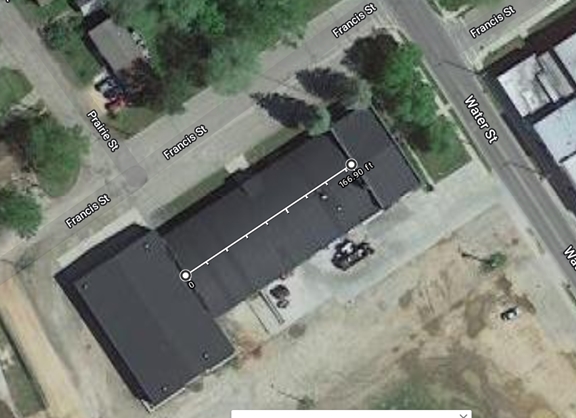
The World War Two section of the plant was
approximately 167 feet long by 80 feet wide. The USMC SU-COE 4x4
truck that the plant assembled was just over 21 feet long. This
implies that there could have been one or more assembly lines with most
likely seven vehicles on them. The SU-COE was 8 feet wide,
allowing for several lines running back and forth within the building.
According to the historical record, there were going to be 24
departments in the plant. These could have actually been the
different work stations where parts were assembled to the chassis.
Enough room would have been needed to provide for stock storage of all
of parts supplied by the Clintonville plant and outside suppliers.
Clintonville supplied the frames and axles while Waukesha Motors
supplied engines and Fuller Manufacturing supplied the transmissions.
Another 60-70 companies shipped in their components for final assembly.
The 168 6-ton, 6x6 bridge
erecting trucks that the facility built at the end of the war were
somewhat larger at 24 feet long and 8-1/3 feet wide, most likely
resulting in five on an assembly line. As this was a
White Model 666, it had a different set of parts from many of the same
suppliers as the SU-COE.
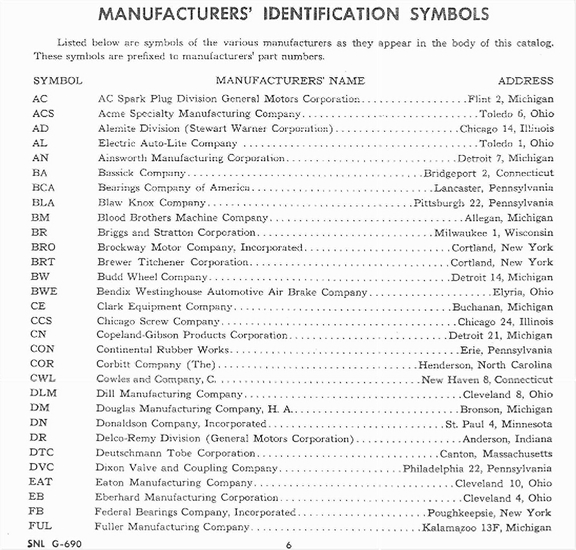
This and the next image are the suppliers
for the 6-ton, 6x6, bridge erecting truck. Adequate space in the
13,360 square foot building needed to be maintained for all of the
incoming parts.
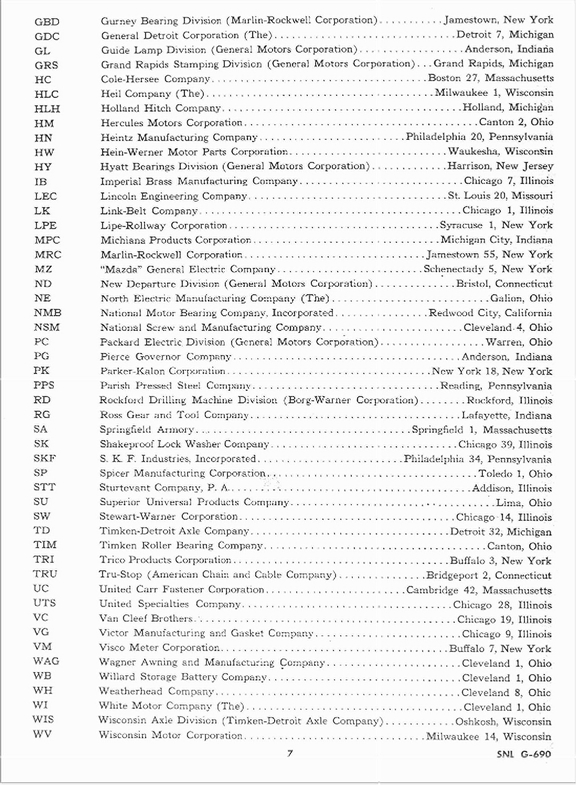
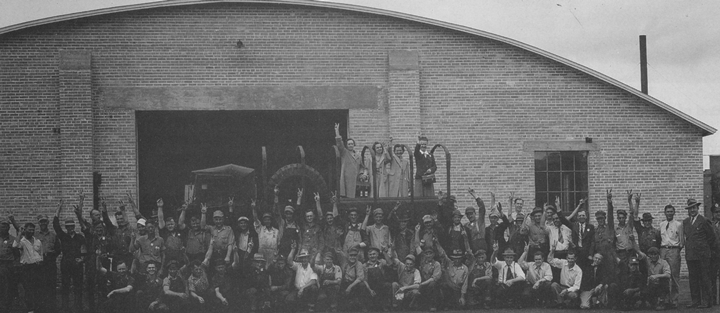
This group picture most likely is in
recognition of either the first or last USMC
SU-COE truck built. It appears that the plant only employed four
women as office help. "Rosie the Riveter" had not made her way
into upper central Wisconsin. A core team of experienced
supervisors were assigned to Stevens Point from Clintonville.

According to the historical record, Stevens
Point built the last 120 of the estimated 250 USMC SU-COEs that the company built.
These were built on U.S. Navy contract NOM-38159. Photo courtesy
of the Tim Wright Collection.

According to the September 16, 2016, edition of the Portage County
Gazette that published an article on the Stevens Point FWD plant, the
U.S. Ordnance Department placed an order for 550 trucks to go to the
Canadians. Table 5 shows that 500 SU-COEs were accepted in 1944
under Ordnance contract 11-022-213. It would have made sense for
Stevens Point to make this version of the SU-COE, as it was nearly the
same as the USMC truck except it had an enclosed cab and right side
steering. This allowed Clintonville to focus on the 7,000 units of
HAR-1s it was building. Photo courtesy of the Tim Wright
Collection.
The last truck built at Stevens Point was the
6-ton, 6x6 bridge erecting truck chassis which was based on the White
666 truck. As Table 12 shows, Stevens Point built 168 of these
between March and August of 1945. While another 2,907 were built
by Brockway, Ward LaFrance, and White, this order would seem to have
been a late build for more trucks of this type for the planned invasion
of Japan.
|
Table 12 - This
table associates the contracts from Table 2 and Table 5 |
|
From Table 5 |
|
From Table 1 |
|
Type |
FWD Model |
Total |
Common
Contract Number |
Product - Customer |
Contract Amount |
Contract Awarded
|
Completion
Date |
Average Cost per Unit |
| Stevens Point
Plant |
|
|
|
|
|
|
|
|
| Truck, 6-ton,
6x6, W/W Chassis for Bridge Erecting
Parts based on original Brockway
truck |
same as Brockway,
WL, White |
168 |
11022-Ord-7890 |
Trucks
- Army |
$3,122,000 |
3-1945 |
8-1945 |
$18,583 |
Below are two bridge erector trucks that
were photographed at the 2019 D-Day activities in Normandy, France.
Both are Brockways, but the FWDs were identical to these. The body
of the truck was designed to carry bridging pontoons and then back up to a river to be crossed,
and slide the pontoons into the
water. The truck could also inflate the pontoons on-site, allowing
it to carry more of them to the crossing location. As noted
earlier, these were considerably larger and more complicated than the
FWD SU-COEs that Stevens Point assembled.
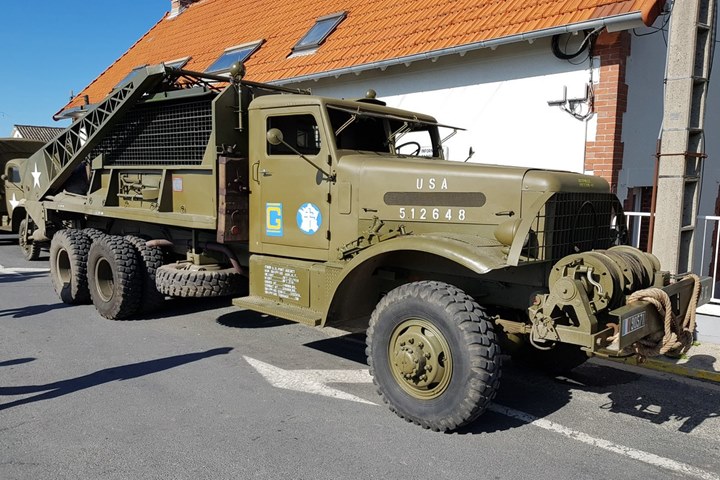
This is the hard cab version of the Brockway
B-666. Photo is courtesy of Pierre-Olivier Buan.
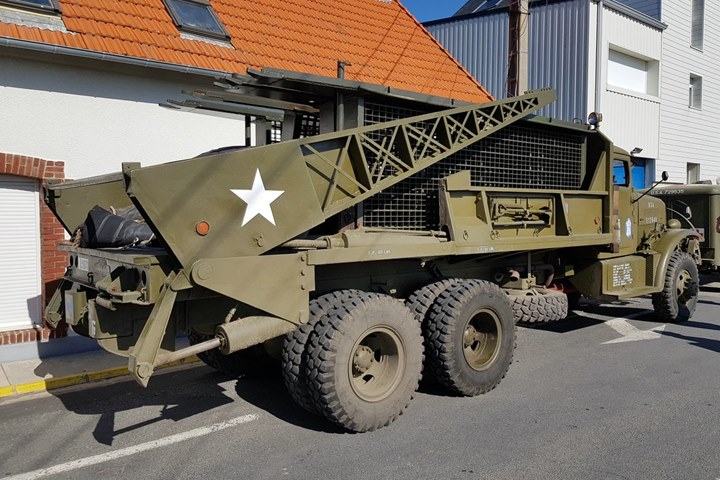
Note that there is bridging equipment in the
body of the truck. There appears to be deflated pontoons at the
rear. Photo is courtesy of Pierre-Olivier Buan.
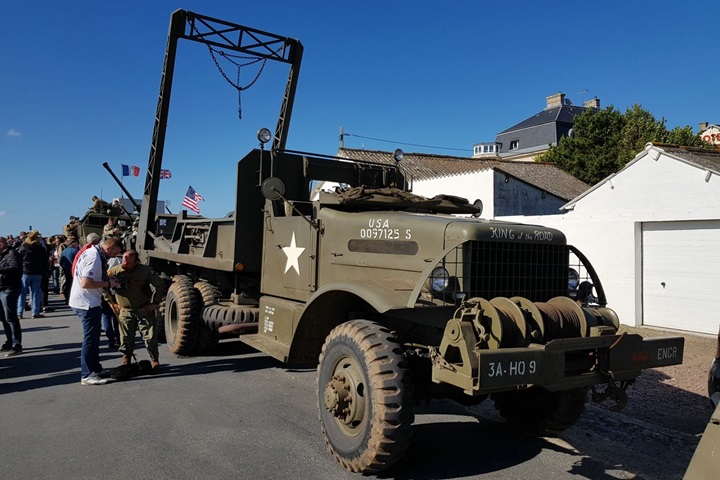
This soft top version of the B-666 has its
Daybrook Bridge Erector unit in the upright position. As the unit
started to rise, a pontoon located on it would slide into the water.
Photo is courtesy of Pierre-Olivier Buan.
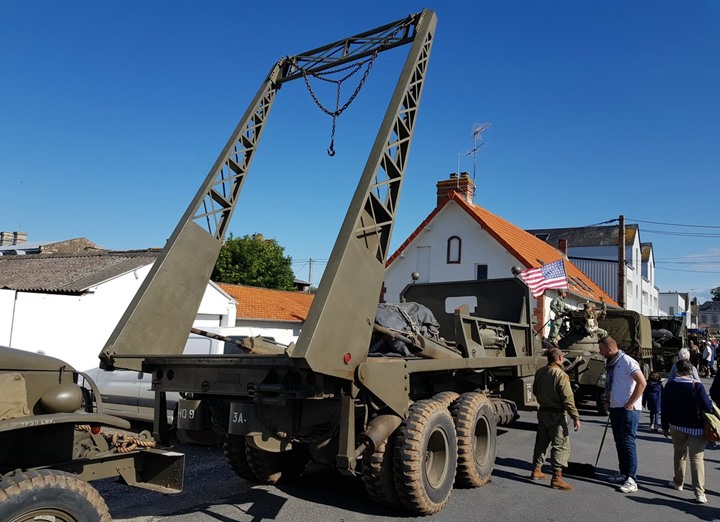
Photo is courtesy of Pierre-Olivier Buan.

The former Portage County, WI county highway
garage still exists in Stevens Point. Currently, it has been
re-purposed into a local
recycling point. Image courtesy of Google Maps.
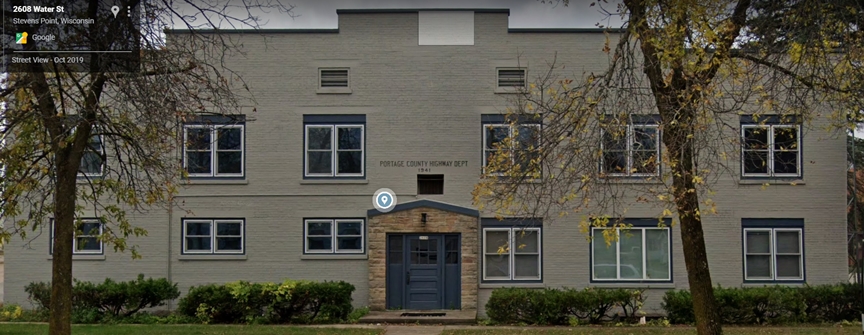
The Portage County highway garage was new to the county as it had just
been built in 1941. Image courtesy of Google Maps.

Directly across the street is the Stevens
Point Brewery. Image courtesy of Google Maps.
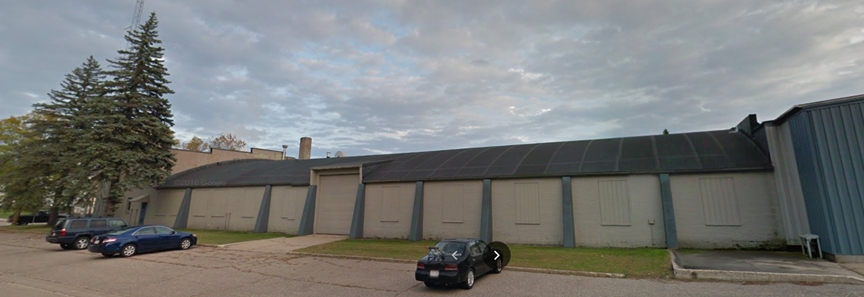
This image of the northeast side of the
building shows that at one time it had windows. There is also a
large overhead door. Image courtesy of Google Maps.
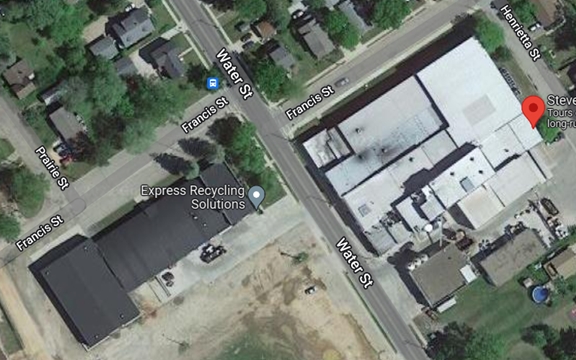
Image courtesy of Google Maps.
As I noted before, my best friend is from Stevens Point. Because
of this, I was aware of the brewery in town and on occasion have been
treated to some of its products. So, I was surprised to find that
my research led me to the FWD facility that was across the street from
the brewery. But my association goes much deeper than just the beer
made at "The Point Brewery."
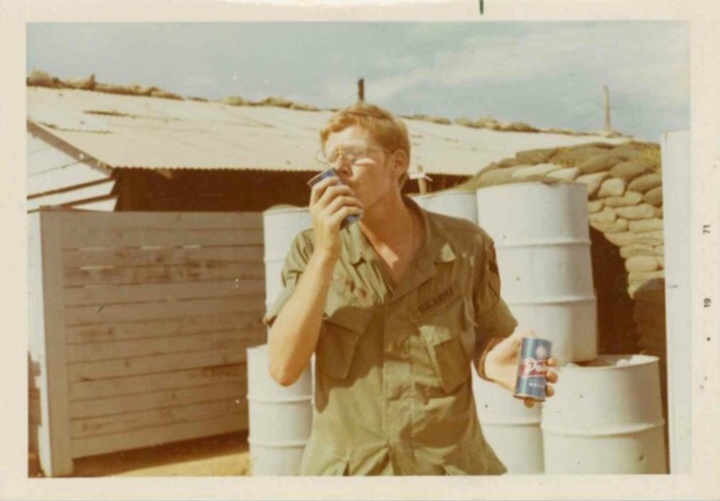
This is George Hanson, my friend Rob
Hanson's older brother, when he was stationed at a firebase in Vietnam.
George has just received a care package of Point beer from home.
Of the several care packages of Point beer that were sent to him, it was
the only one he ever received. The others mysteriously disappeared
in transit. I met George around 2009 when he came to Indianapolis,
IN from Stevens Point to assist with an event with which his brother and
I were associated. And of course, he brought some Point beer!
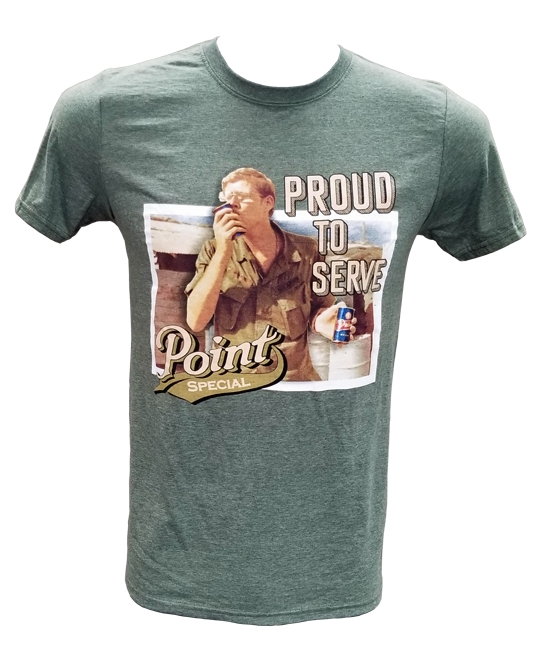
Unfortunately, George passed away in 2016.
When he did, the Point Brewery made up a commemorative T-shirt with his
photo on it. Sales of the shirts raised funds to send World War
Two veterans on Honor Flights to the World War Two Memorial in
Washington, DC.
The Appleton, WI Plant: On
August 13, 1941, the Four Wheel Drive Auto Company purchased the Eagle
Company of Appleton, WI through a stock transfer. It was then
named the Eagle Division of FWD. The plant was located at 414 East
Winnebago Street in Appleton. The plant no longer exists and is
now the location of an apartment complex.
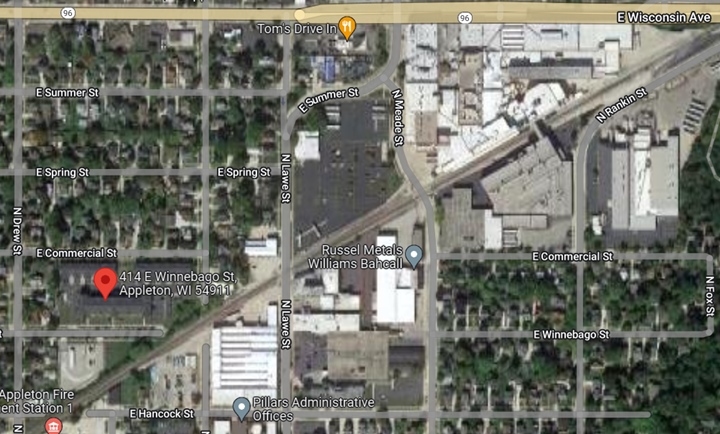
The Eagle Division was part of a group of
industrial plants located on either side of the railroad tracks.
Satellite view courtesy of Google Maps.
Eagle Manufacturing produced tractors, silo cutters, and feed cutters
with 30 workers. The number of employees was expected to increase
to 150 when the work transferred from the Clintonville plant.
During World War Two its main known
product was the manufacture of Signal Corps K-38 telephone line splicing
trailers. The Eagle Division built these under Signal Corps
contract number 227-SC-3454. Production ran between June 1941 and August
1942. The total contract
value was $192,000. It is unknown what the Eagle Division produced
for the rest of the war. It can be assumed it manufactured
subcomponents for the FWD truck being assembled in Clintonville.
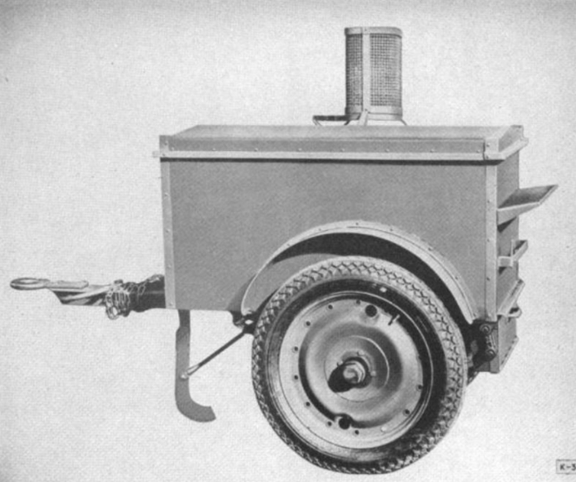
The Signal Corps K-38 telephone line
splicing trailer was the military version of the ATT Model S line
splicing trailer.
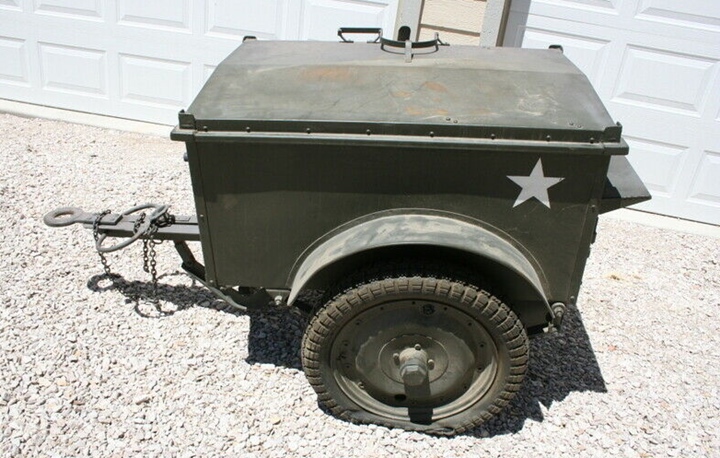
This and the following photos are of a FWD
Eagle Division-built K-38 trailer. This trailer is now part of the
FWD/Seagrave Museum in Clintonville, WI. This photo and the others
were provided by the previous owner in California before the sale.
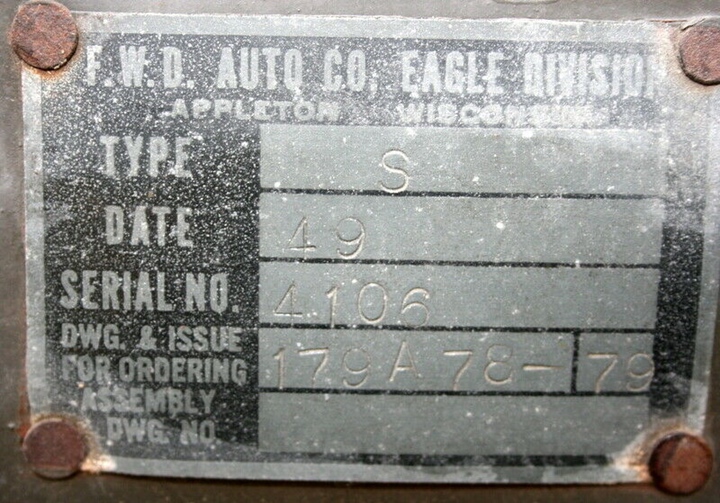
This shows the trailer as an ATT S type.
This identification seems to have been very common for many of the K-38
trailers built. The meaning of the date of "49" is unknown.
The serial number 4106 implies that the Eagle Division built at least
this many trailers at a unit cost of $46.76.
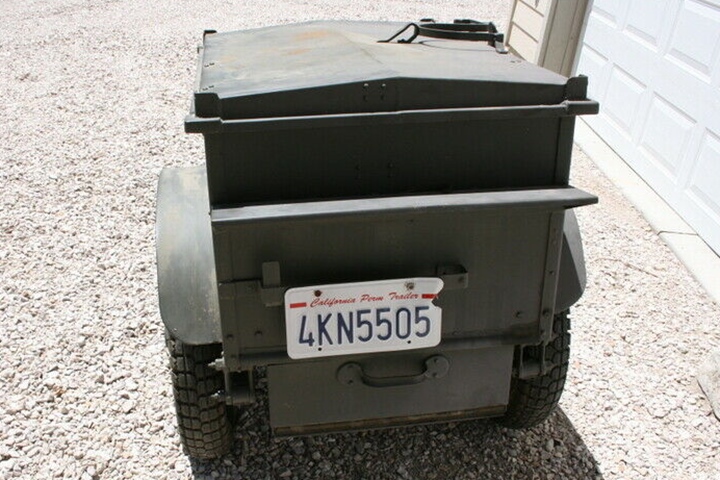
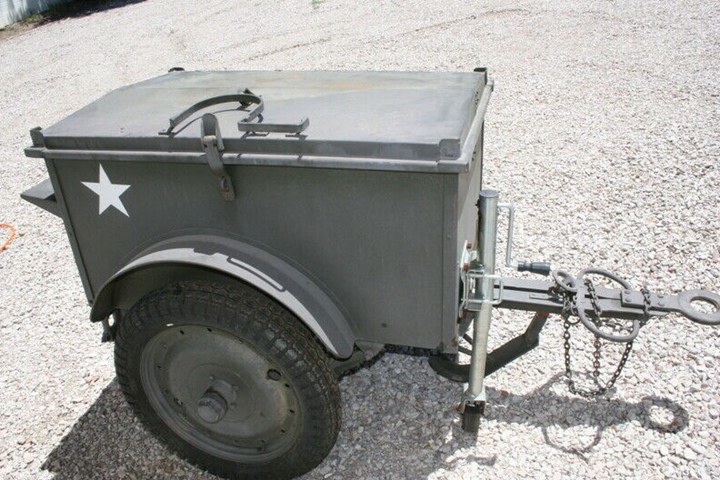
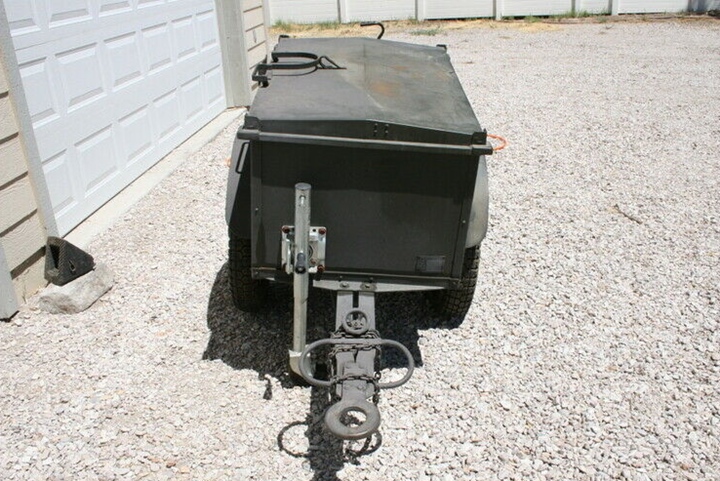
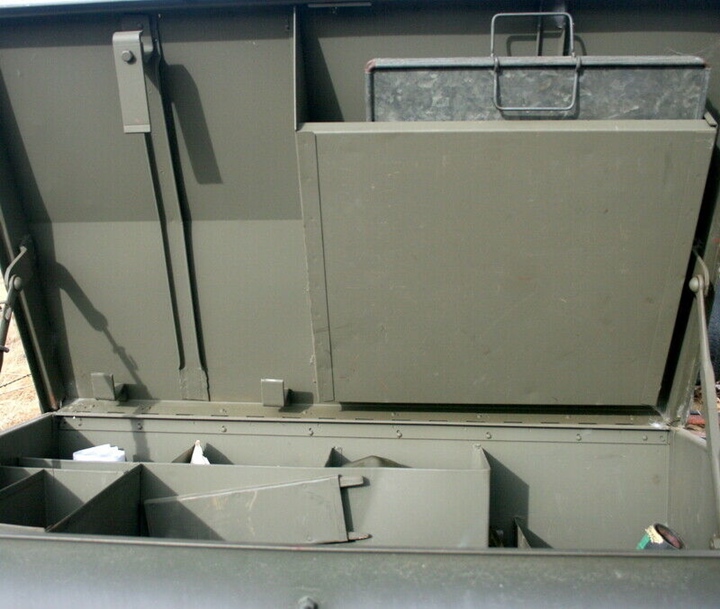
When World War Two truck
production ramped up in 1941, the company moved production of
non-truck products to Appleton, which included the Eliason Motor
Toboggans. FWD transferred the work in October 1941. In
December 1941, the plant went on a three shift, 24 hour operation to
manufacture the back ordered toboggans. Carl Eliason can be considered the father of the modern
snowmobile with his invention of the first belt driven snow toboggan in
1924. In 1940, when demand began increasing beyond his ability to
manufacture the product, Mr. Eliason sold his patents to the FWD company
in return for royalties on each unit sold.
In November 1942, the
United States Army purchased 150 snow toboggans from FWD under contract
number 271-ORD-2782. The amount of the contract was $109,000
resulting in a per unit cost of $726. The Army utilized the
vehicles in Alaska, especially for rescuing downed airmen in the snowy
wilderness.

This FWD photo appears to have a 1942 date.
This may well be the type that the U.S. Army used during World War Two.
Photo courtesy of the Tim Wright Collection.
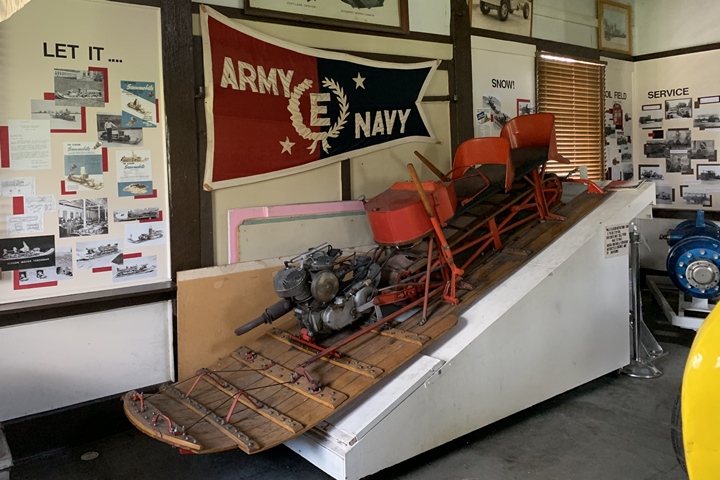
FWD produced four different models of
snow toboggans. They were Models A, B, C, and D. This one on display at
the FWD Seagrave Museum in Clintonville, WI is a different model than
the one the U.S. Army used. Photo courtesy of the Tim Wright
Collection.
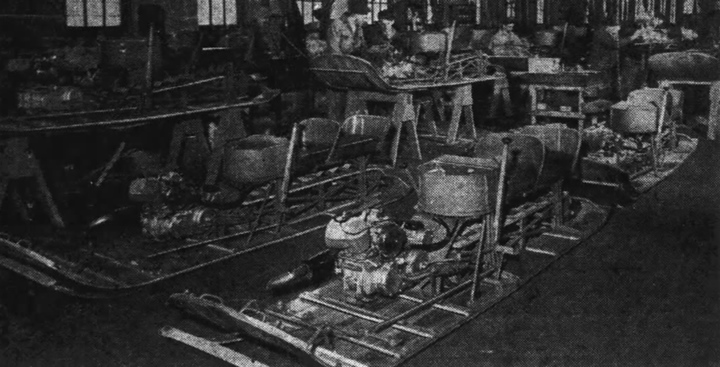
This image shows the motor toboggans under
construction at the Eagle Division plant.
The Clintonville, WI
Plant:
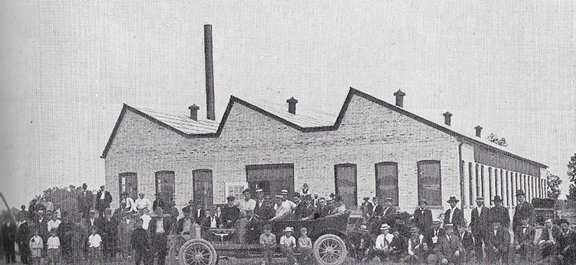
This is the original Four Wheel Drive Auto
Company's first factory that was built in 1911. Photo courtesy of
the Tim Wright Collection.
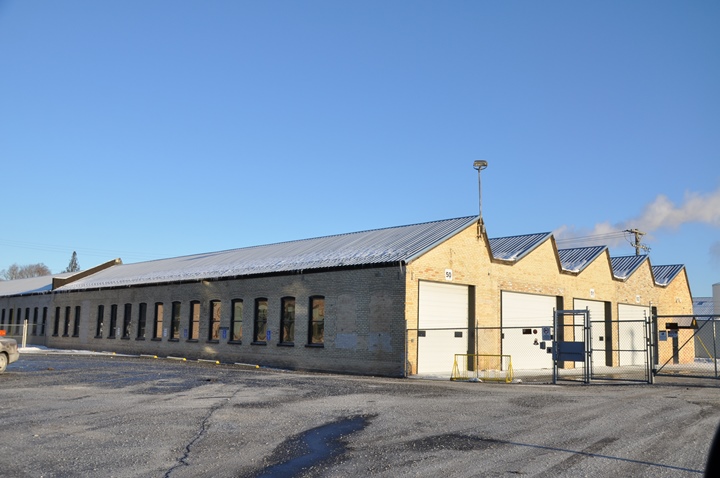
The original factory at Clintonville still
exists but has been taken out of operation. Photo courtesy of the
Tim Wright Collection.
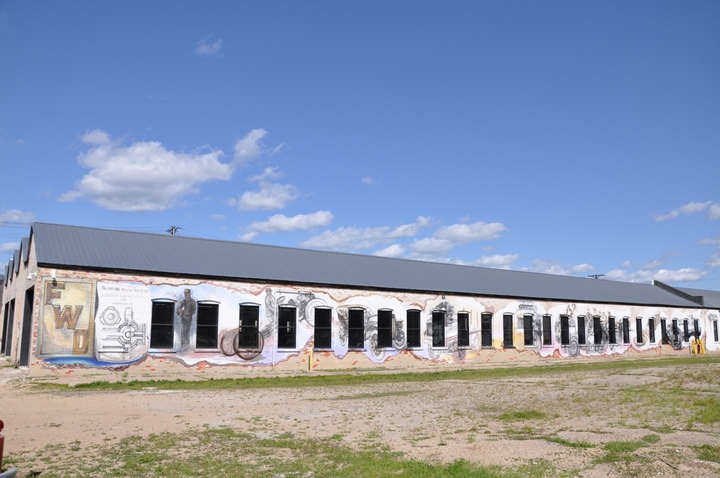
A mural has been painted on the opposite
side of the building. Note the image of the double-Y universal
joint patent. Photo courtesy of the Tim Wright Collection.
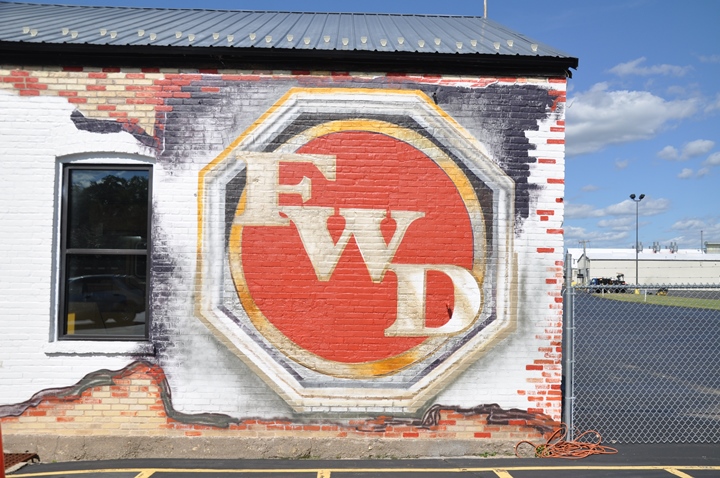
At the end of the mural is this FWD
insignia. Photo courtesy of the Tim Wright Collection.
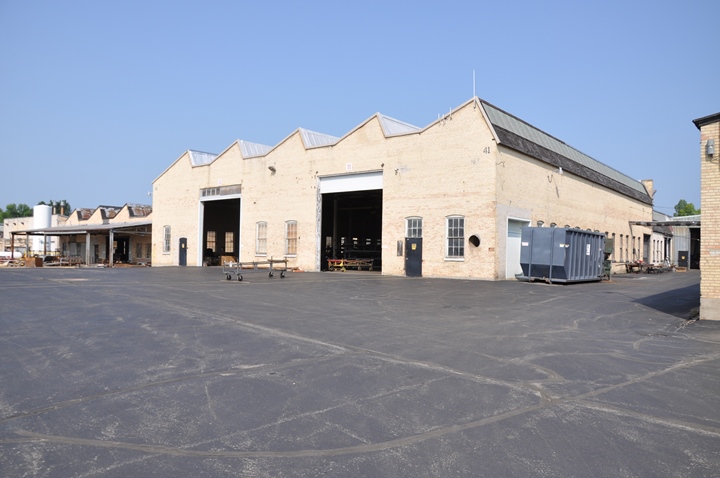
Parts of the large factory complex are still
in use for the manufacture of components used in Seagrave fire
apparatus. Photo courtesy of the Tim Wright Collection.
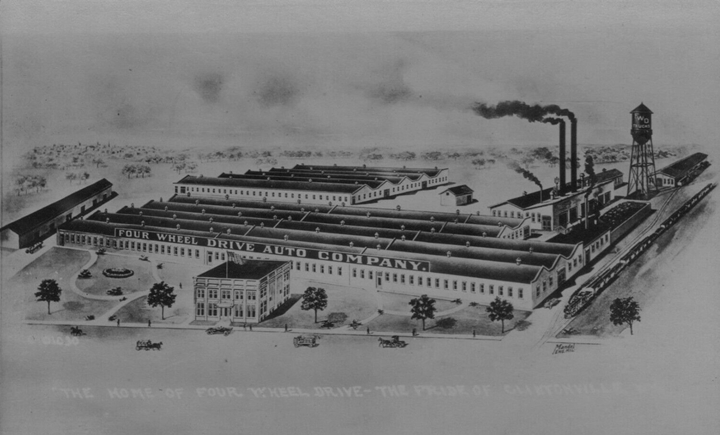
It then expanded into this factory complex.
At the front of the complex is a two story office building.
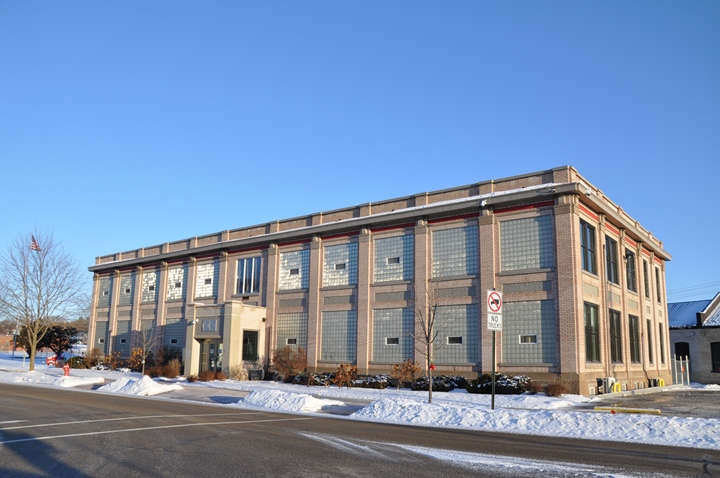
The office building along with the rest of the original factory
complex still exists. Photo courtesy of the Tim Wright Collection.
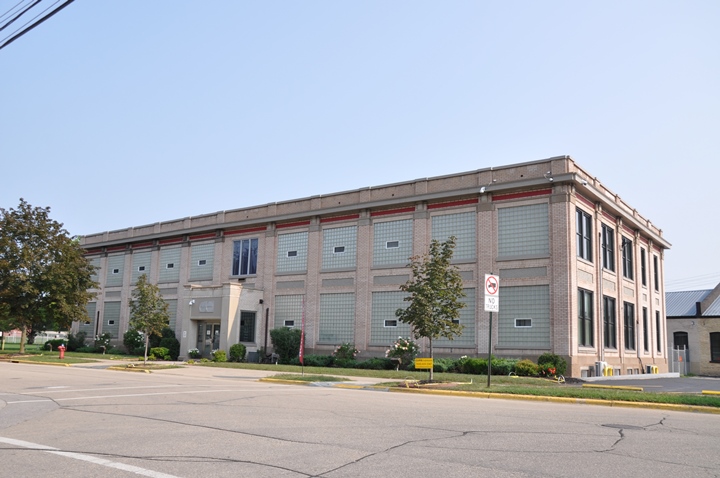
This photo taken in the summer shows the
landscaping in front of the office building. Photo courtesy of the
Tim Wright Collection.
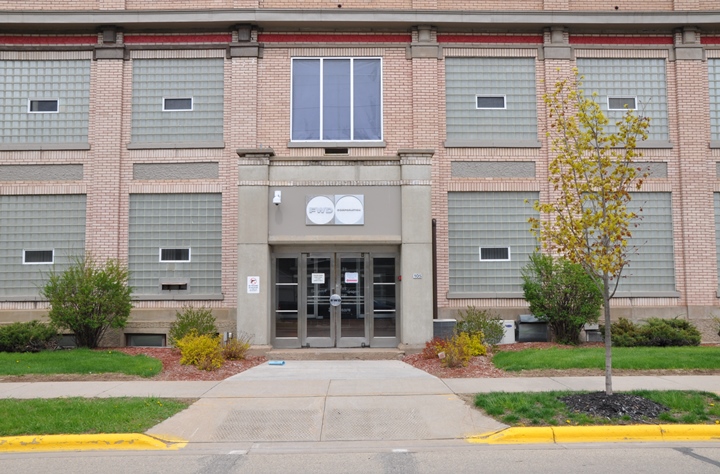
Even though final assembly of Seagrave fire
trucks has moved to a new building on the complex, the original office
building is still in use. Over 100 years after it was built, it
shows the elegance of the original design. Photo courtesy of the Tim Wright Collection.
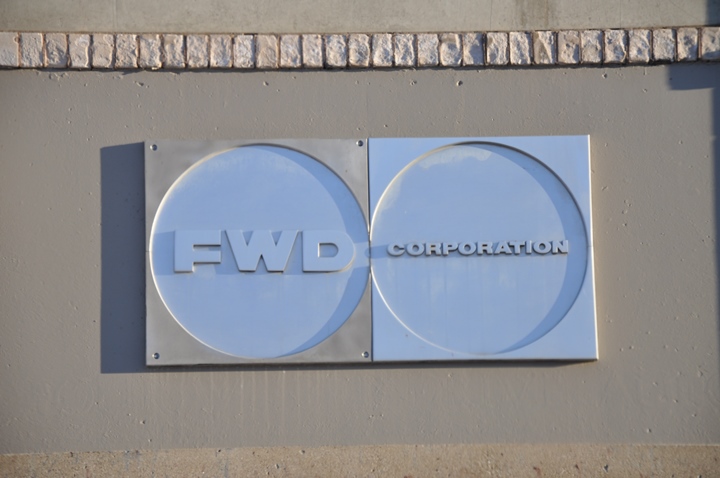
Photo courtesy of the Tim Wright Collection.
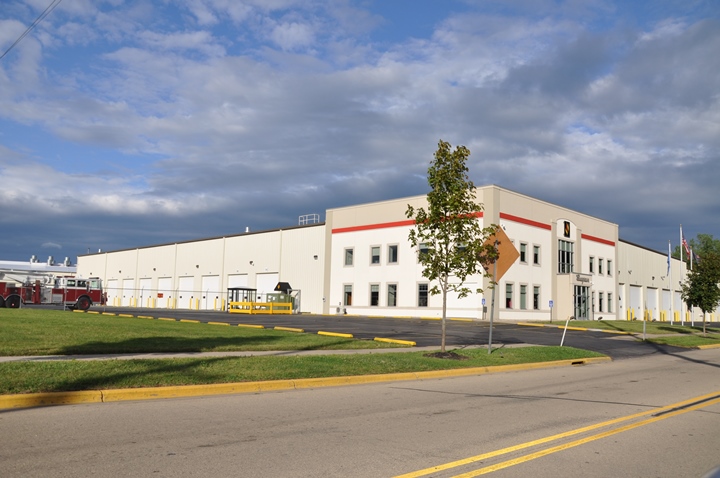
To the east of the office building, the
company has built a new facility for the assembly of Seagrave fire
trucks. Photo courtesy of the Tim Wright Collection.
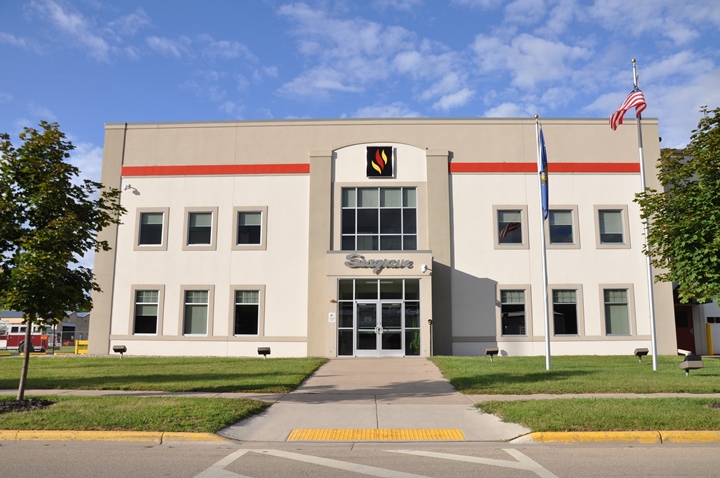
Photo courtesy of the Tim Wright Collection.
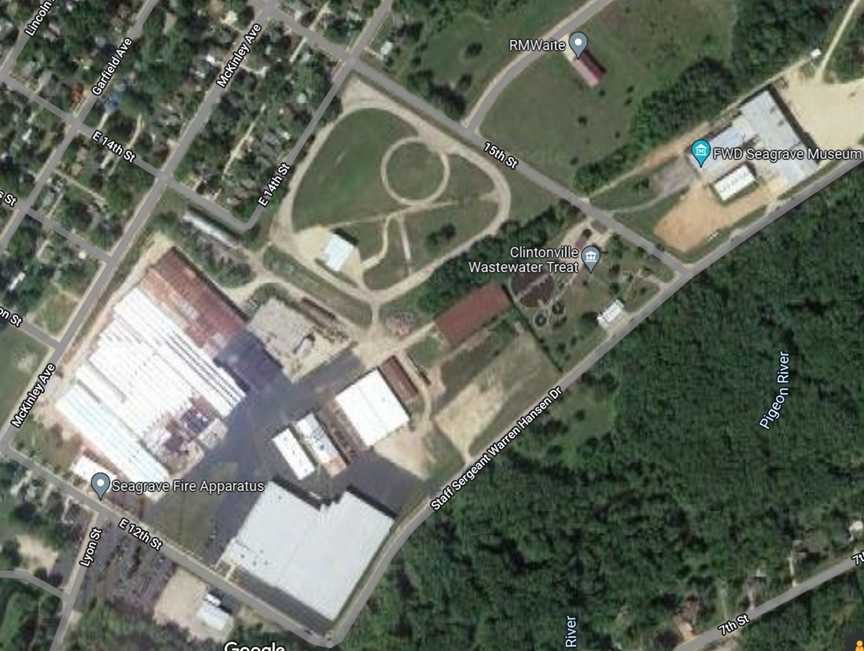
This Google Maps satellite view shows the
current size of the factory complex. The test track can be seen
at the top center and the FWD Seagrave Museum in the upper right-hand
corner. The original factory is located at the west end of the
complex along McKinley Avenue. The new Seagrave plant is located
in the lower right corner at the intersection of East 12th Street and Staff
Sergeant Warren Hansen Drive.
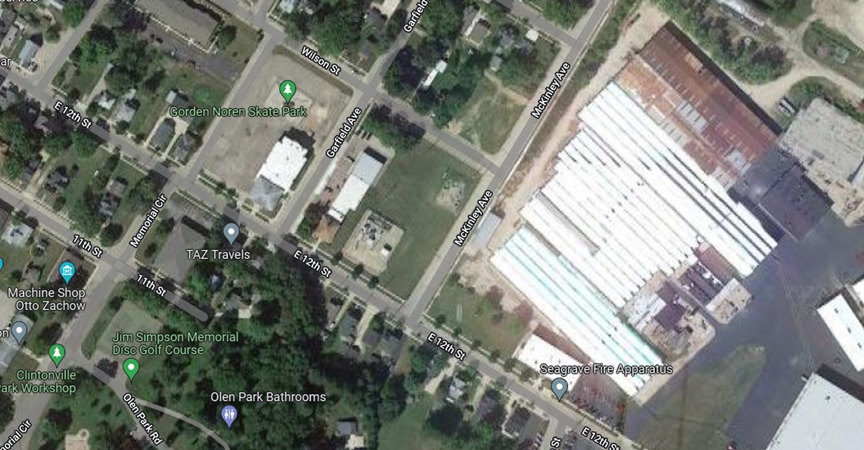
The Otto Zackhow Machine Shop and the
factory are just a couple of blocks from one another. Image
courtesy of Google Maps.
Post-World War Two FWD Specification
Sheets:
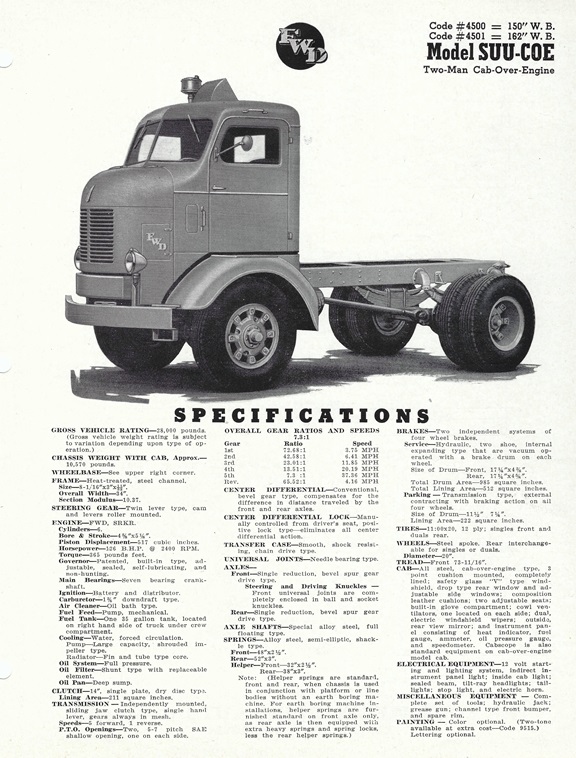
Image added 1-13-2024 courtesy of Tim
Wright.
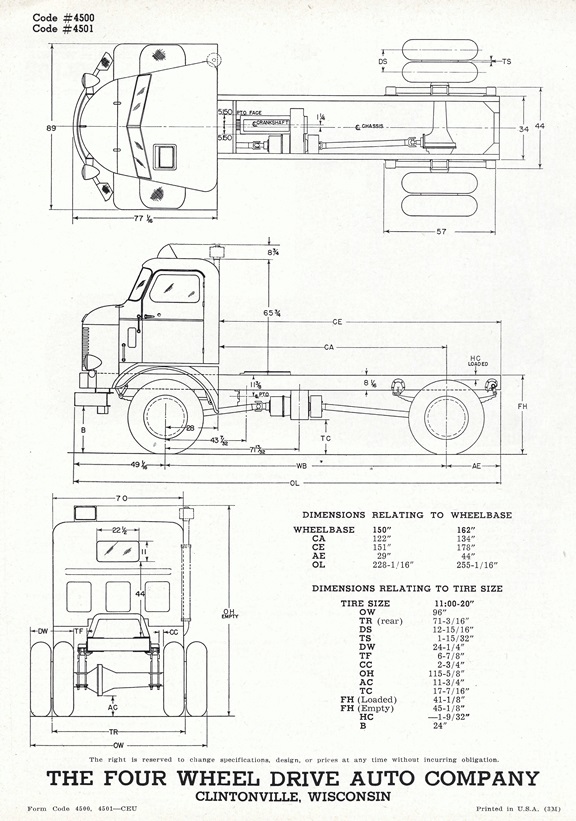
Image added 1-13-2024 courtesy of Tim
Wright.
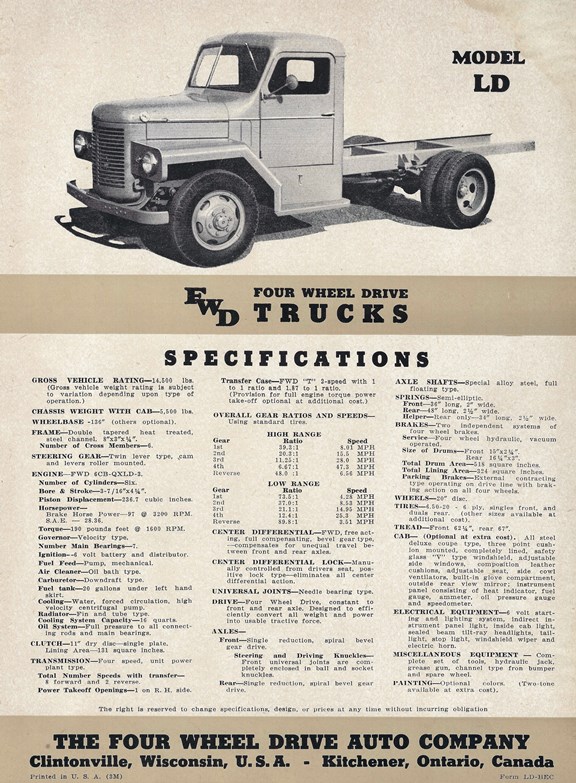
Image added 1-13-2024 courtesy of Tim
Wright.
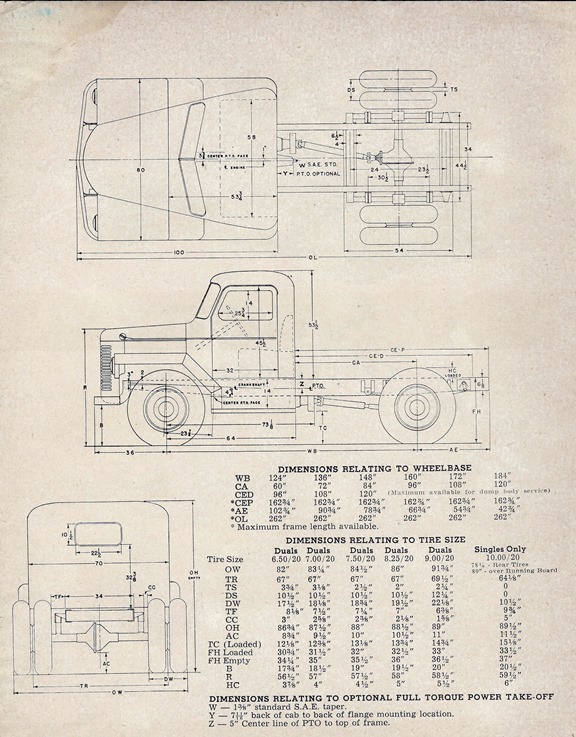
Image added 1-13-2024 courtesy of Tim
Wright.
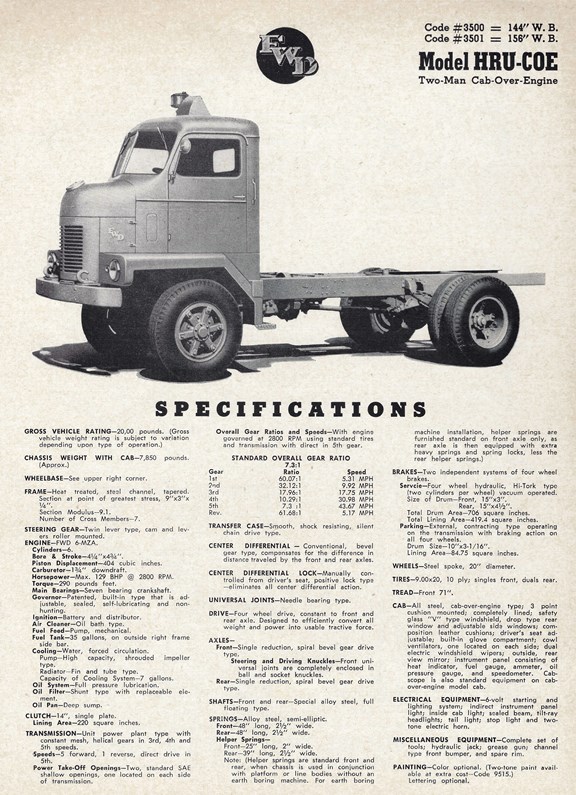
Image added 1-13-2024 courtesy of Tim
Wright.
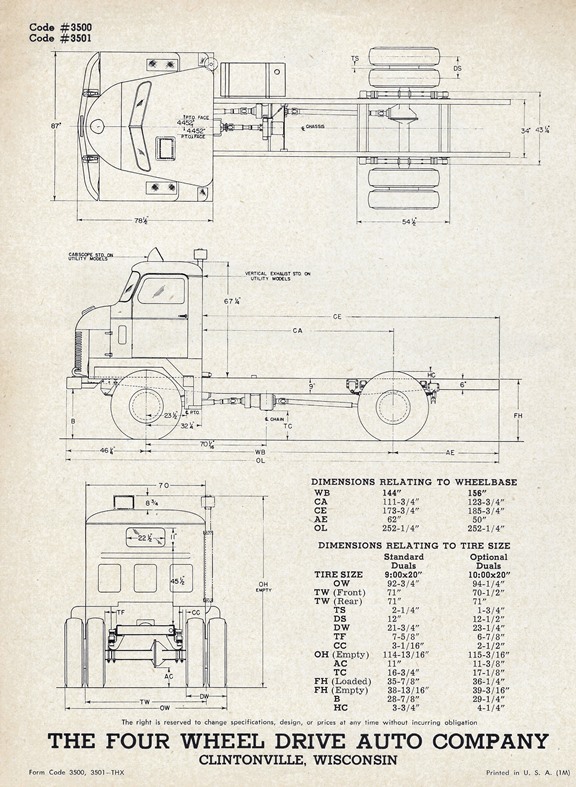
Image added 1-13-2024 courtesy of Tim
Wright.
|






































































































































































